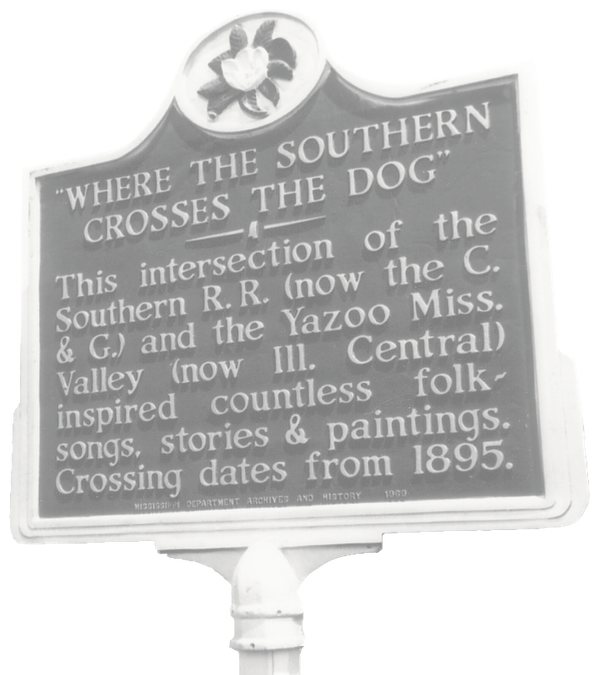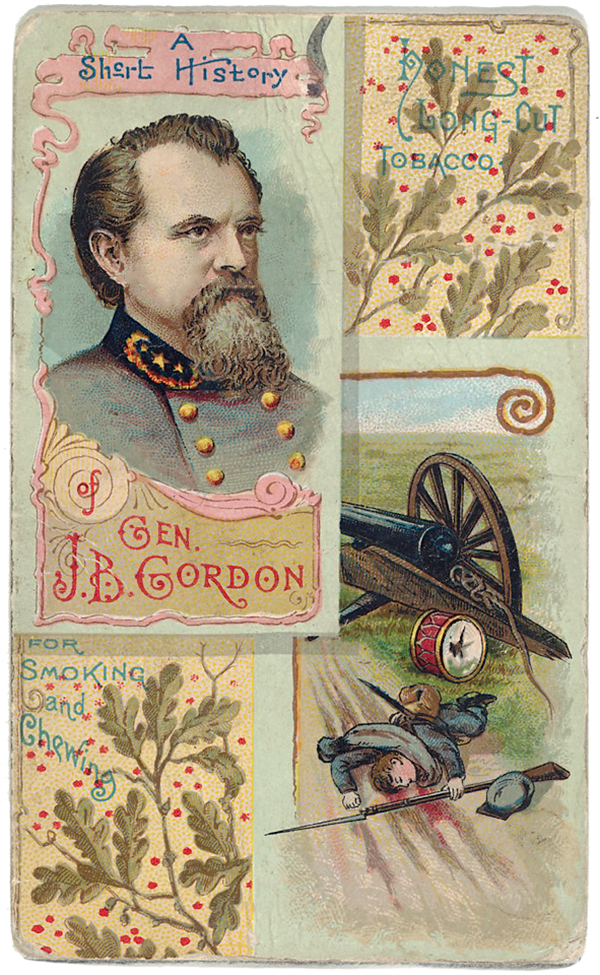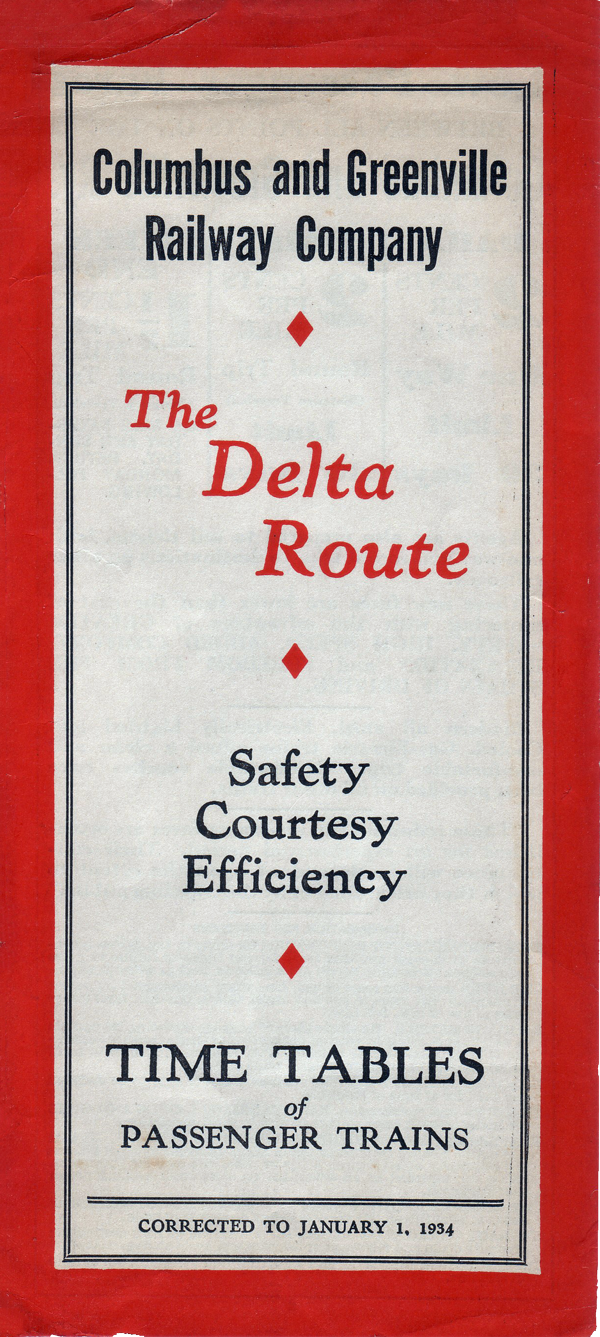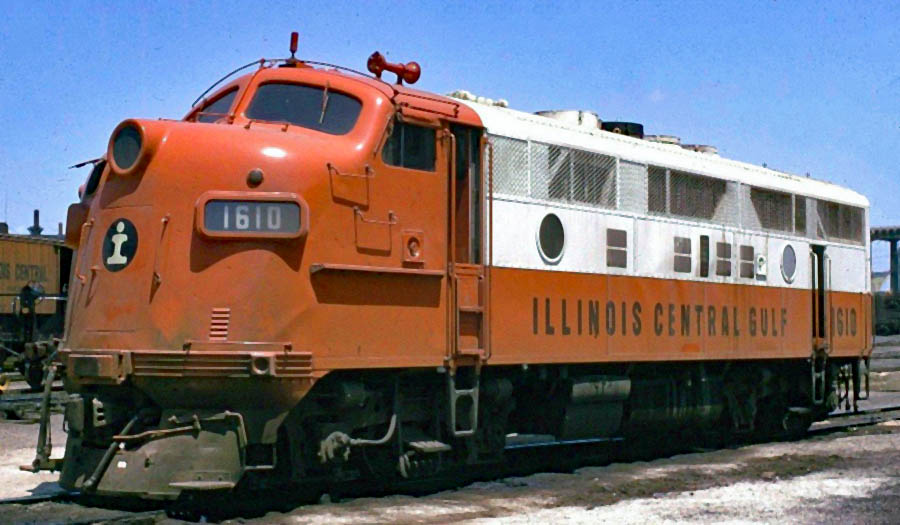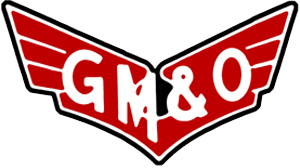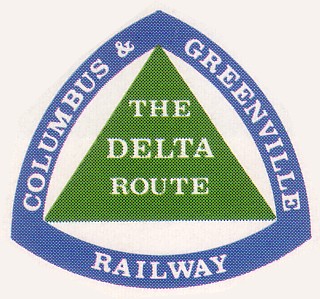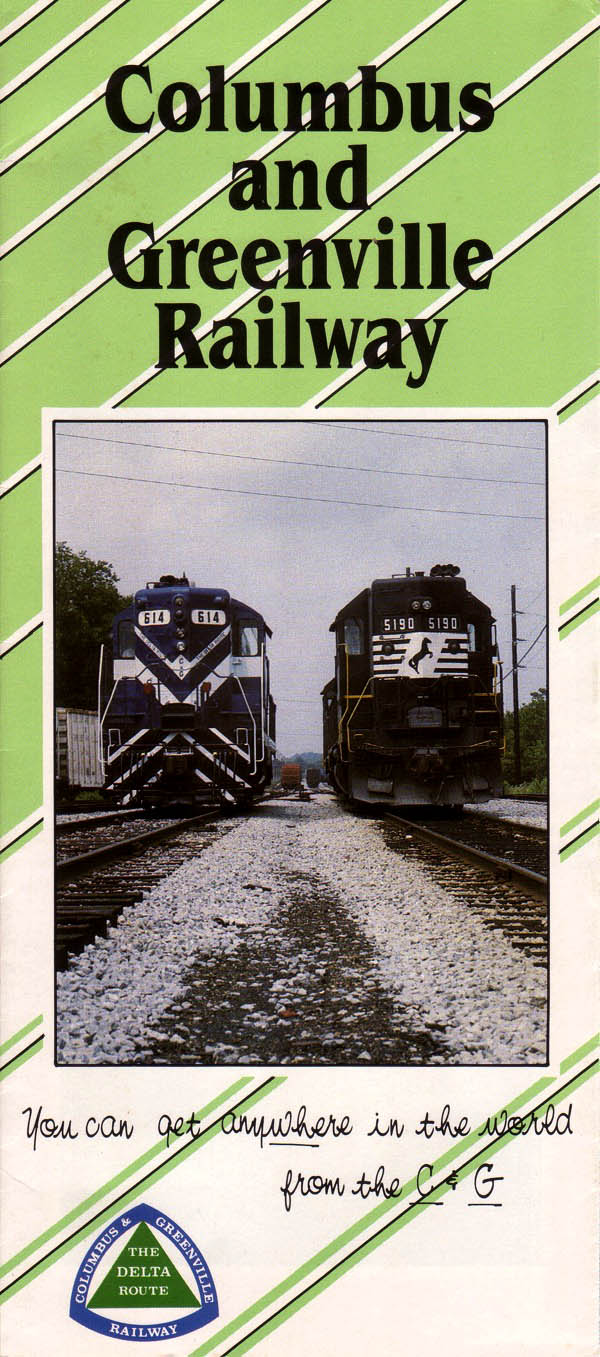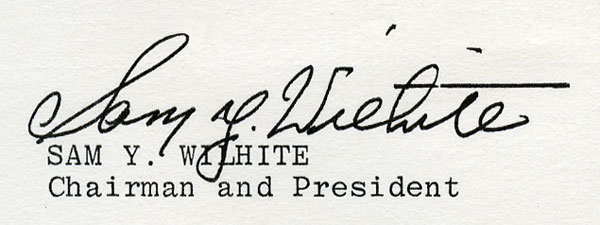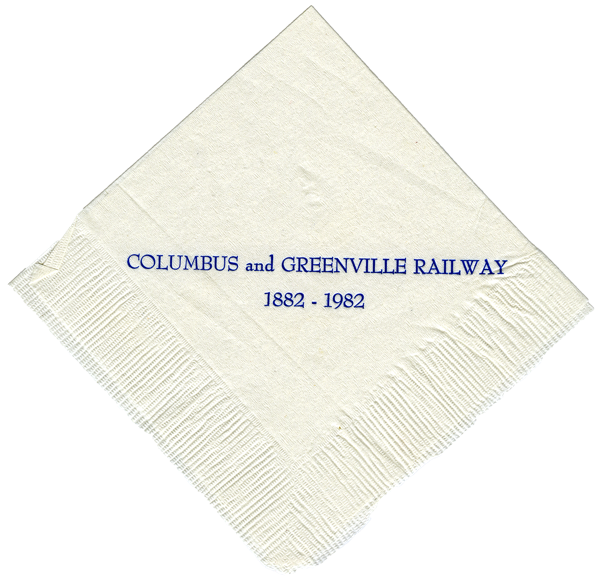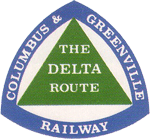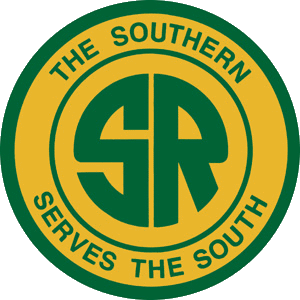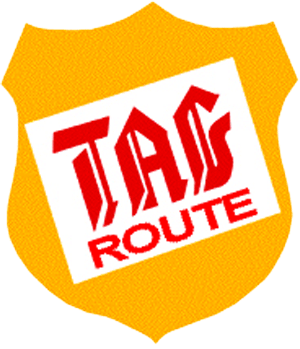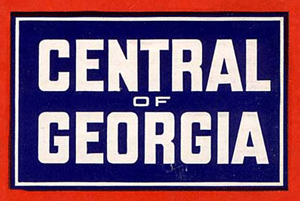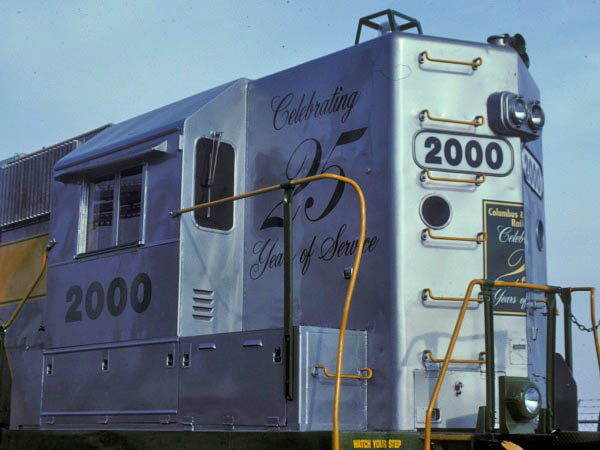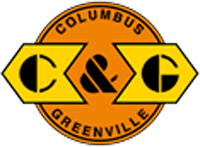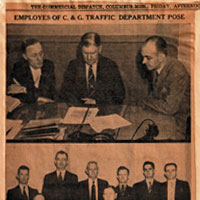 |
Columbus & Greenville Railway Historical Timeline |

 The student of shortline railroads might well note that the people of Mississippi again control fortunes of the Columbus & Greenville. Interested local management has been responsible for the railroad surviving abandonment twice in the last sixty years.
To a great extent the little railroad known to Henry T. Ireys, John Brown Gordon, and A.T. Stovall is gone. No longer does ten-wheeler No. 178 try to get two cars of passengers and a car of mail from Columbus to Greenville in five hours on a train called the Deltan. Still, the classic roundhouse in Columbus is active as it has been since 1908, and C&G's first diesel locomotive, wearing a new paint scheme, still regularly switches Columbus yard. C&G boxcars no longer proclaim the slogan "Thru the Heart of Dixie." There is a new slogan for the company now, which may explain its survival: "The Railroad that Cares."
The student of shortline railroads might well note that the people of Mississippi again control fortunes of the Columbus & Greenville. Interested local management has been responsible for the railroad surviving abandonment twice in the last sixty years.
To a great extent the little railroad known to Henry T. Ireys, John Brown Gordon, and A.T. Stovall is gone. No longer does ten-wheeler No. 178 try to get two cars of passengers and a car of mail from Columbus to Greenville in five hours on a train called the Deltan. Still, the classic roundhouse in Columbus is active as it has been since 1908, and C&G's first diesel locomotive, wearing a new paint scheme, still regularly switches Columbus yard. C&G boxcars no longer proclaim the slogan "Thru the Heart of Dixie." There is a new slogan for the company now, which may explain its survival: "The Railroad that Cares."
Louis R. Saillard - Delta Route: A History of the Columbus & Greenville - 1981
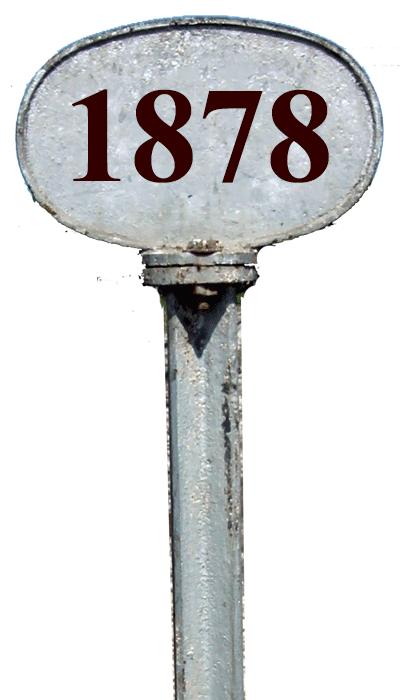 Greenville, Columbus & Birmingham Railroad
Greenville, Columbus & Birmingham Railroad
Chartered in 1872, the first tracks of the 10-mile long Greenville, Columbus & Birmingham Railroad were laid in 1878, connecting Greenville on the Mississippi River with Stoneville to the east. By 1881 the line reached through Indianola to Johnsonville. This 36" narrow gauge right of way would become the western anchor of the subsequent Greenville to Columbus overland route.
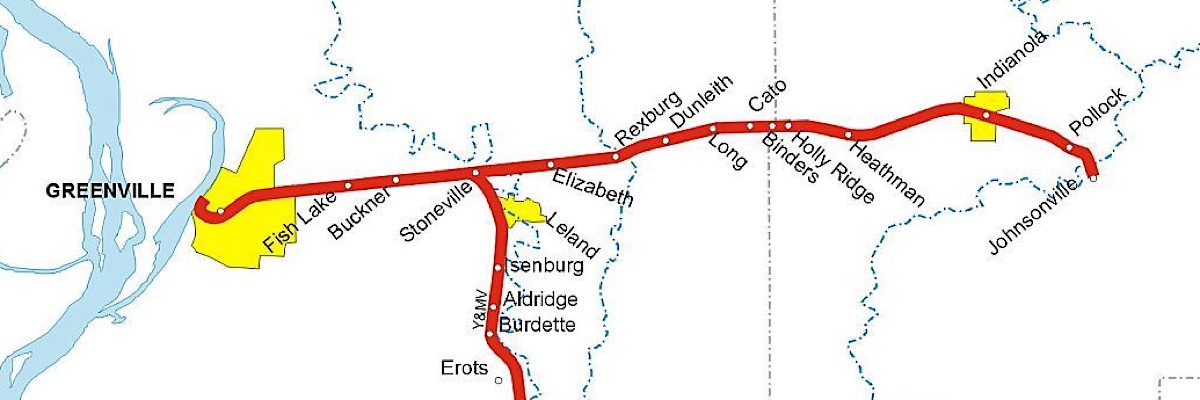
GC&B route map / Mississippi Rails

1878 Official Guide ad / collection
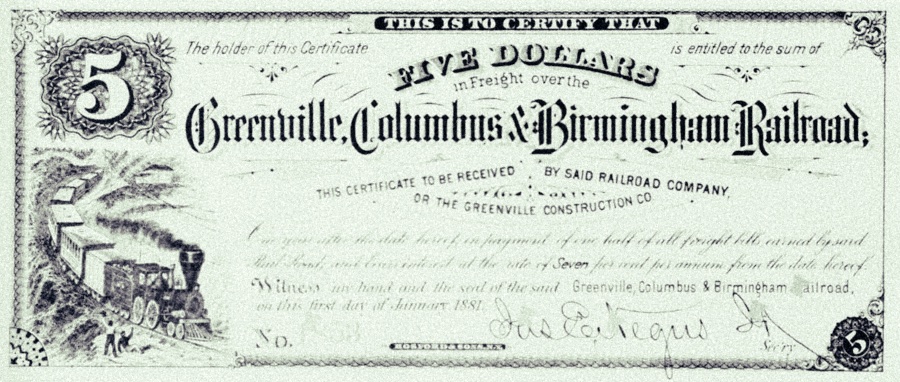
from The Delta Route: A History of the C&G Railway
— Louis Saillard / collection
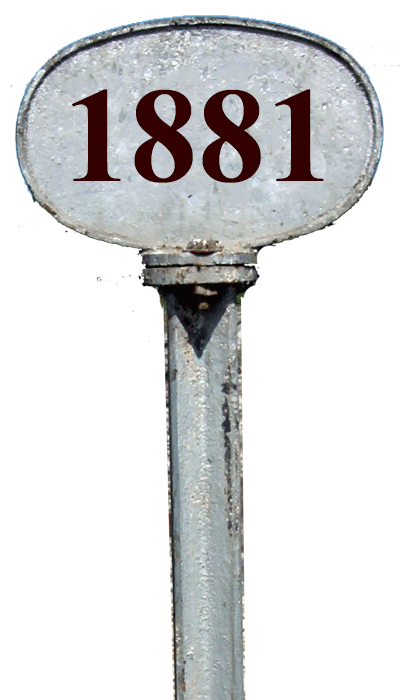 John Brown Gordon
John Brown Gordon
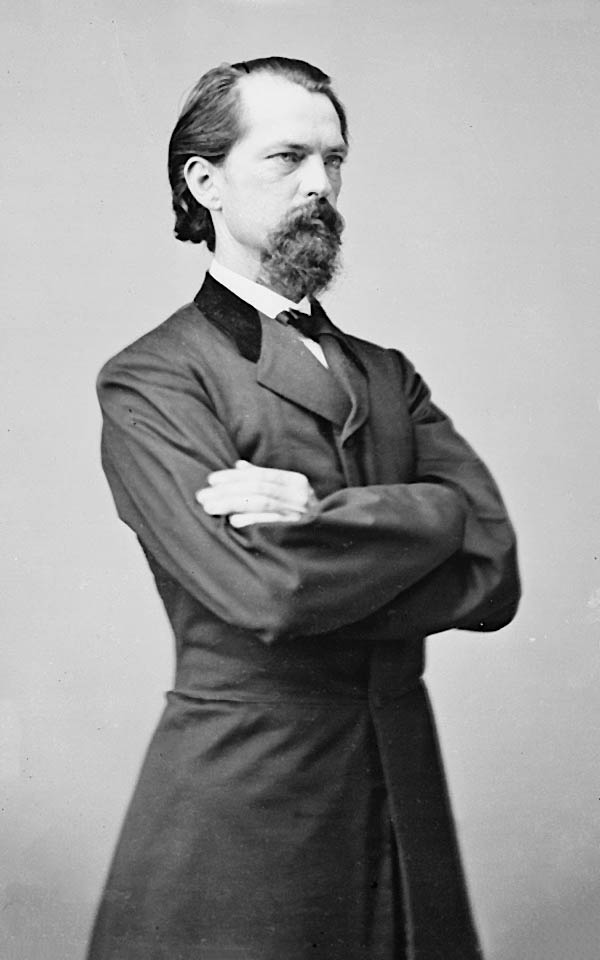
John Brown Gordon / collection
John Brown Gordon (Feb 1832 – Jan 1904) was an attorney, a plantation owner, general in the Confederate States Army, postwar politician, and late-career railroader. In 1880, he resigned as U.S. Senator from Georgia to buy in 1881 the charter of the Georgia Western Railroad, predecessor to the Georgia Pacific Railway that would purchase the Greenville, Columbus & Birmingham Railroad and connect to it from the east.

General John Brown Gordon was a valiant and distinguished soldier, an eminent statesman, a great orator, an author of merit, and a public-spirited and useful citizen. He was born in Upson County, Georgia, February 6, 1832. His father was the Rev. Zachary Herndon Gordon. The family was of Scotch extraction, and its members fought in the Revolutionary War. He received his education at the university of his native State, and by profession was a lawyer.
Stephen D. Lee — introduction to
Reminiscences of the Civil War — 1904
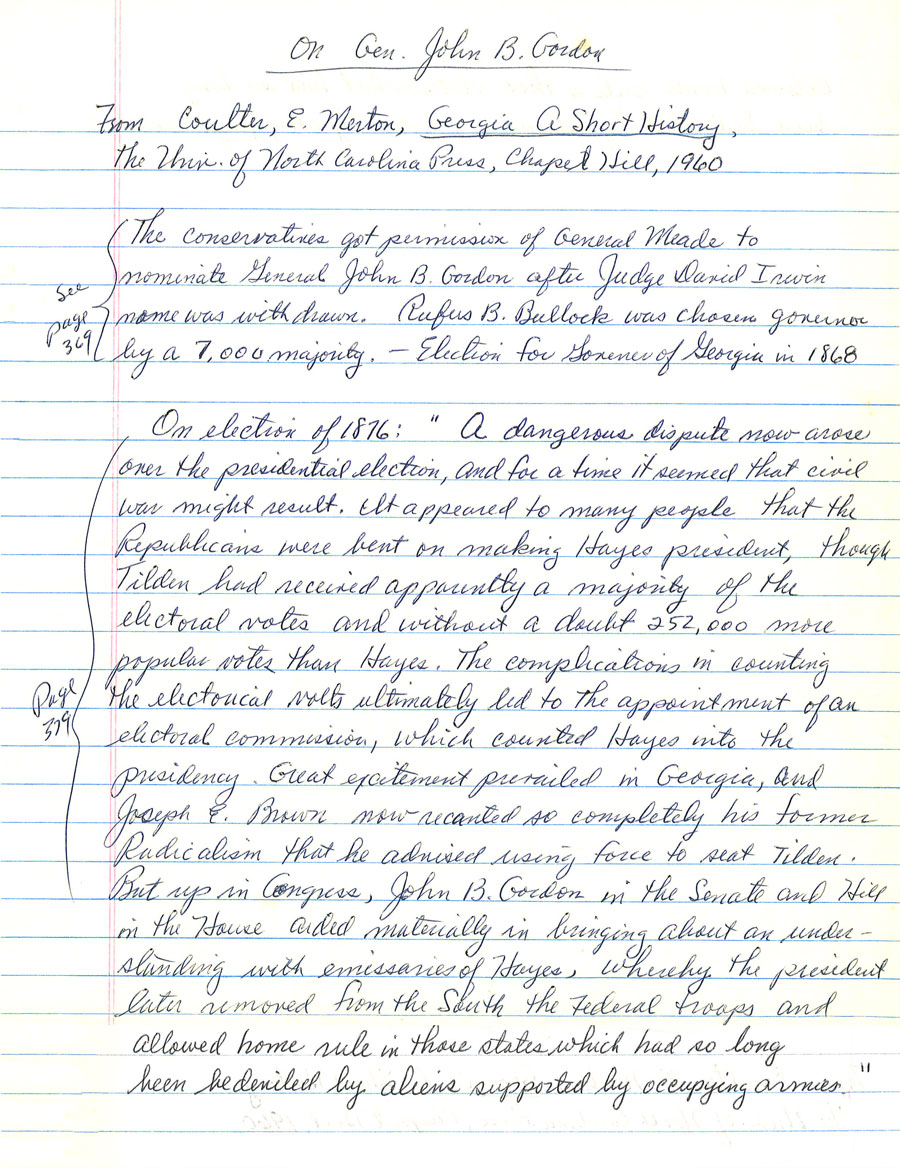
notes on John Brown Gordon / JCH
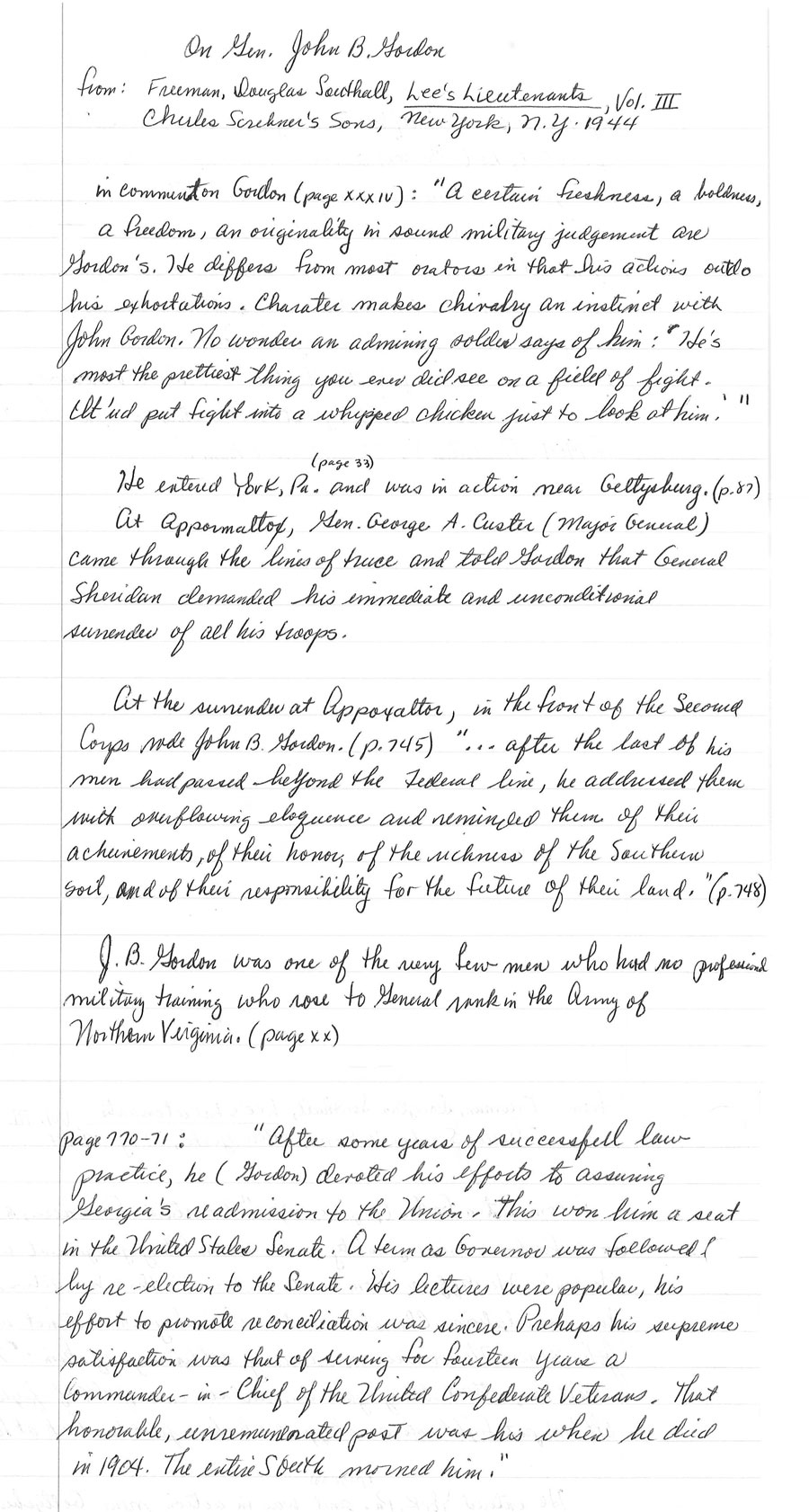
notes on John Brown Gordon / JCH
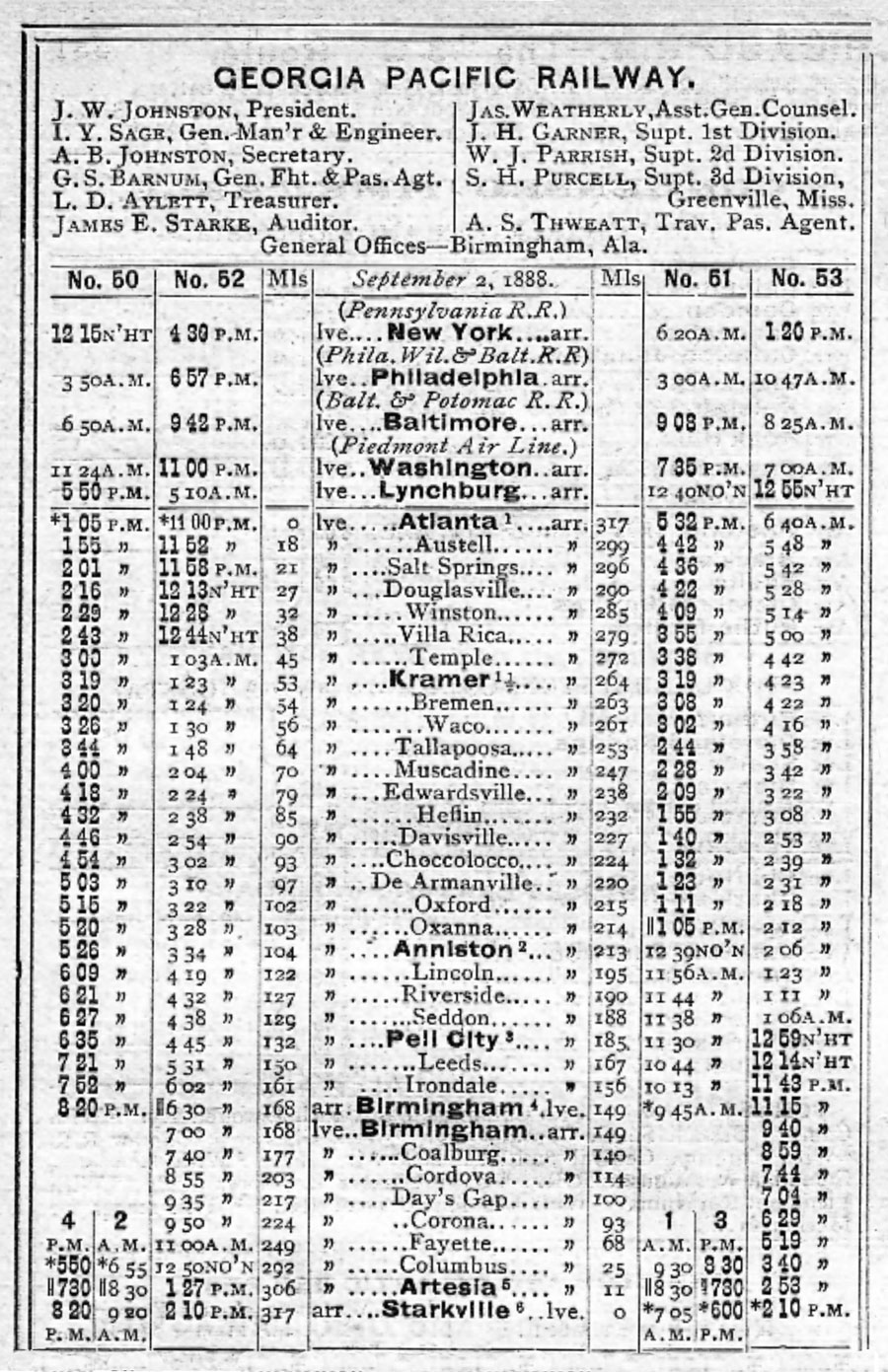
1889 Official Guide ad / collection
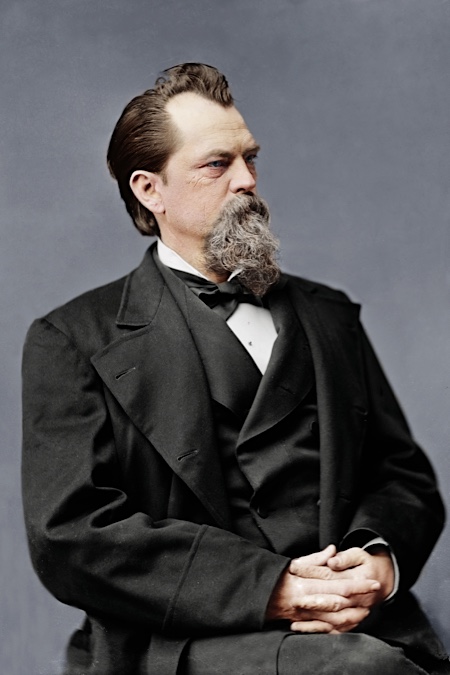
John Brown Gordon / collection
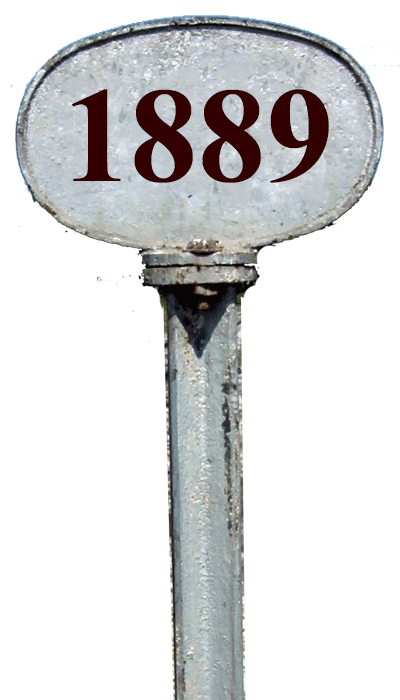 Georgia Pacific Railway
Georgia Pacific Railway
After many fits, starts, and setbacks, by 1889 the mainline of the Georgia Pacific Railway was completed from Atlanta, Georgia, to Greenville, Missisippi. The GP's investors had hoped to capitalize on vision a transcontinental route based in the South, but it would not come to pass. Instead, the westward expansion of rail made it only as far as the Mississippi River.

 The Georgia Pacific Railway was formed in 1881 to build a railroad from Atlanta, GA through Birmingham and Columbus, MS to Greenville, MS and eventually on to Texarkana. From the beginning it was under the control of Southern Railway predecessors East Tennessee Virginia & Georgia and Richmond & Danville. Georgia Pacific bought the 36" gauge railroad of the Greenville Columbus & Birmingham RR in October 1881 and converted it to standard gauge a few years later and completed the line between Columbus and Greenville on June 18, 1889, completing the railroad from Atlanta to Greenville. As the Richmond & Danville was being reorganized in 1894, they formed a new company called Southern Railway in Mississippi to take over the former Georgia Pacific trackage in Mississippi on August 30, 1894.
The Georgia Pacific Railway was formed in 1881 to build a railroad from Atlanta, GA through Birmingham and Columbus, MS to Greenville, MS and eventually on to Texarkana. From the beginning it was under the control of Southern Railway predecessors East Tennessee Virginia & Georgia and Richmond & Danville. Georgia Pacific bought the 36" gauge railroad of the Greenville Columbus & Birmingham RR in October 1881 and converted it to standard gauge a few years later and completed the line between Columbus and Greenville on June 18, 1889, completing the railroad from Atlanta to Greenville. As the Richmond & Danville was being reorganized in 1894, they formed a new company called Southern Railway in Mississippi to take over the former Georgia Pacific trackage in Mississippi on August 30, 1894.
Tony Howe — Mississippi Rails

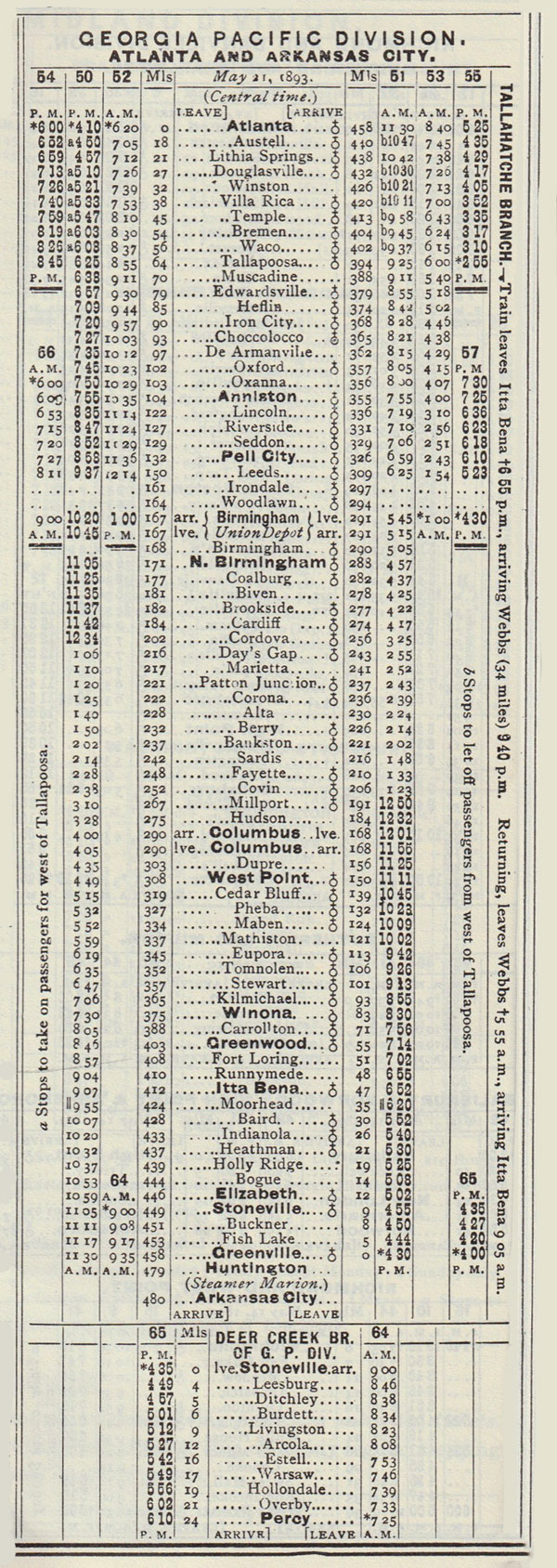
1893 Official Guide ad / collection
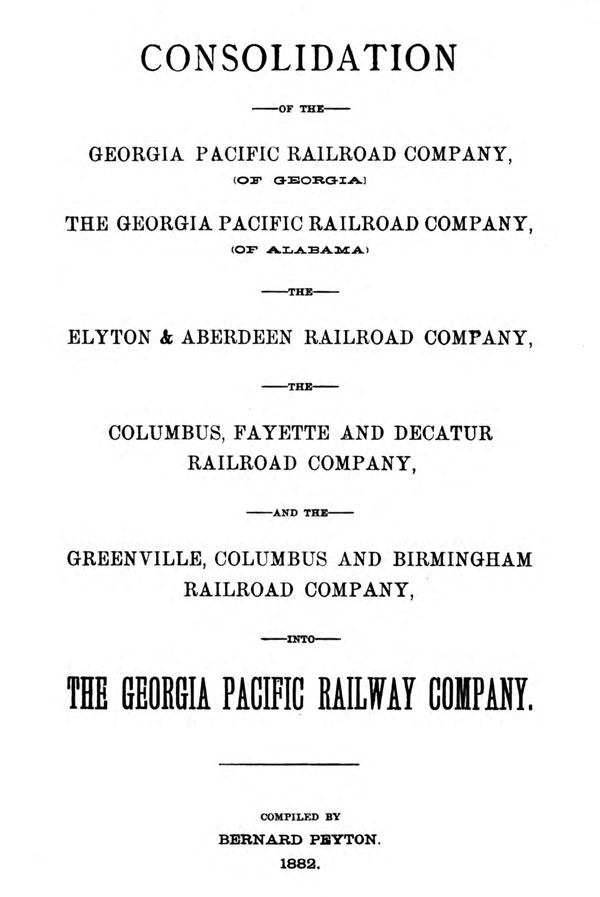
collection
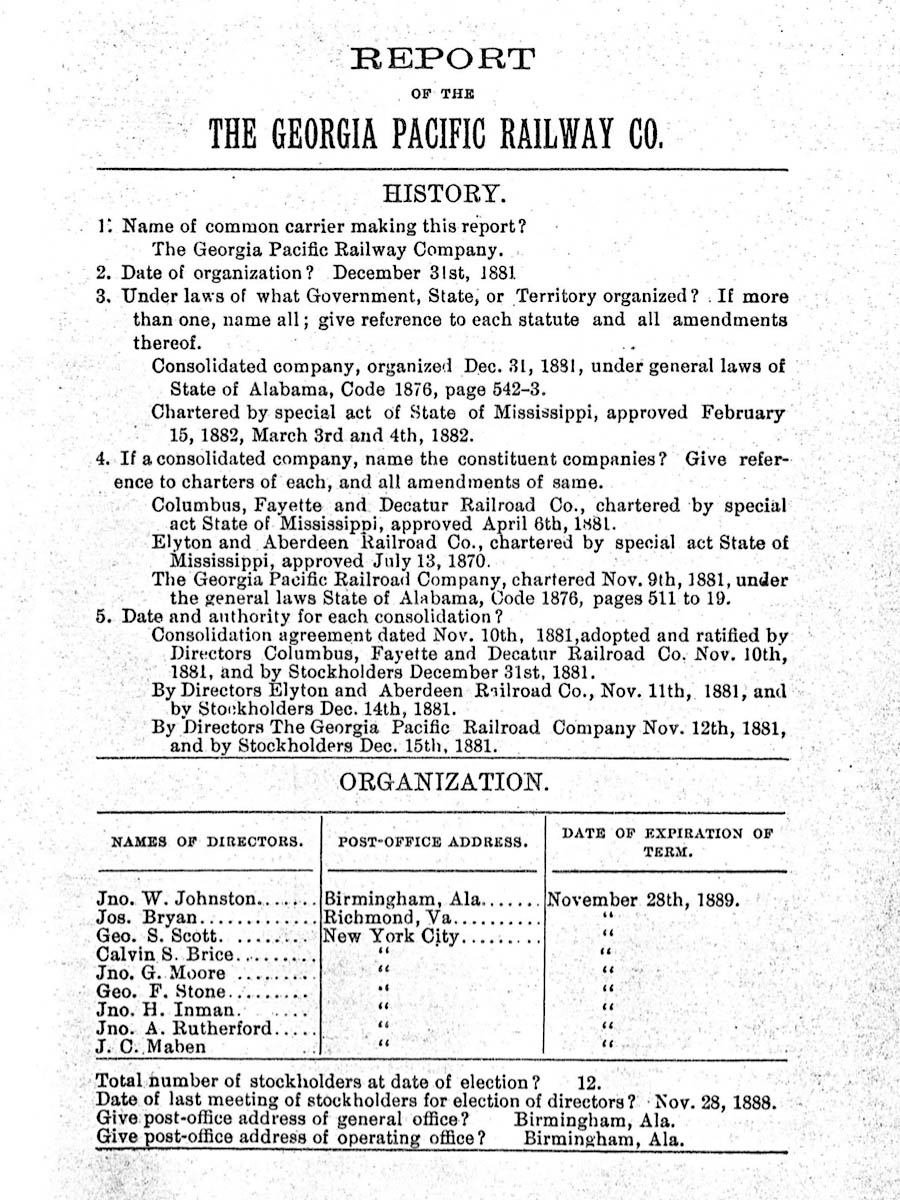
1889 Alabama Railroad Commission Report / collection
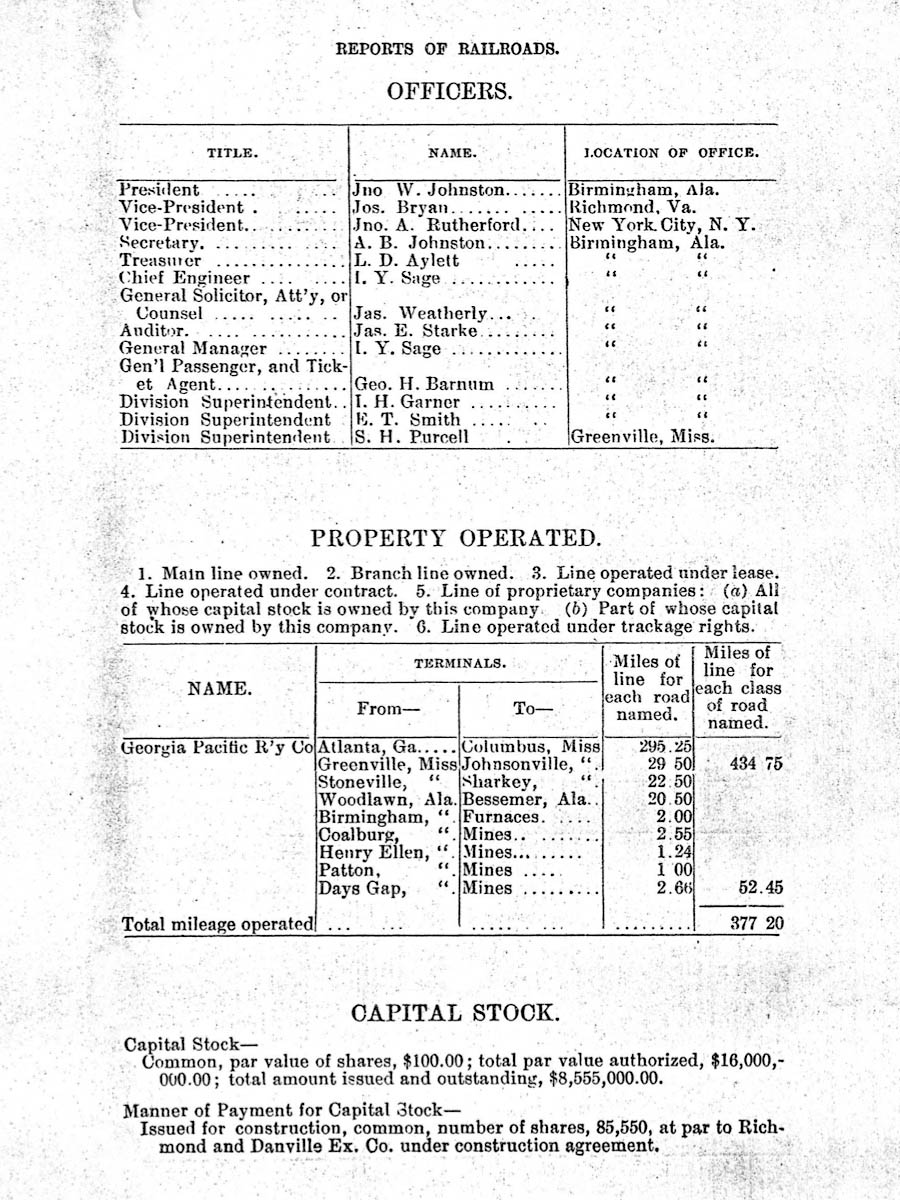
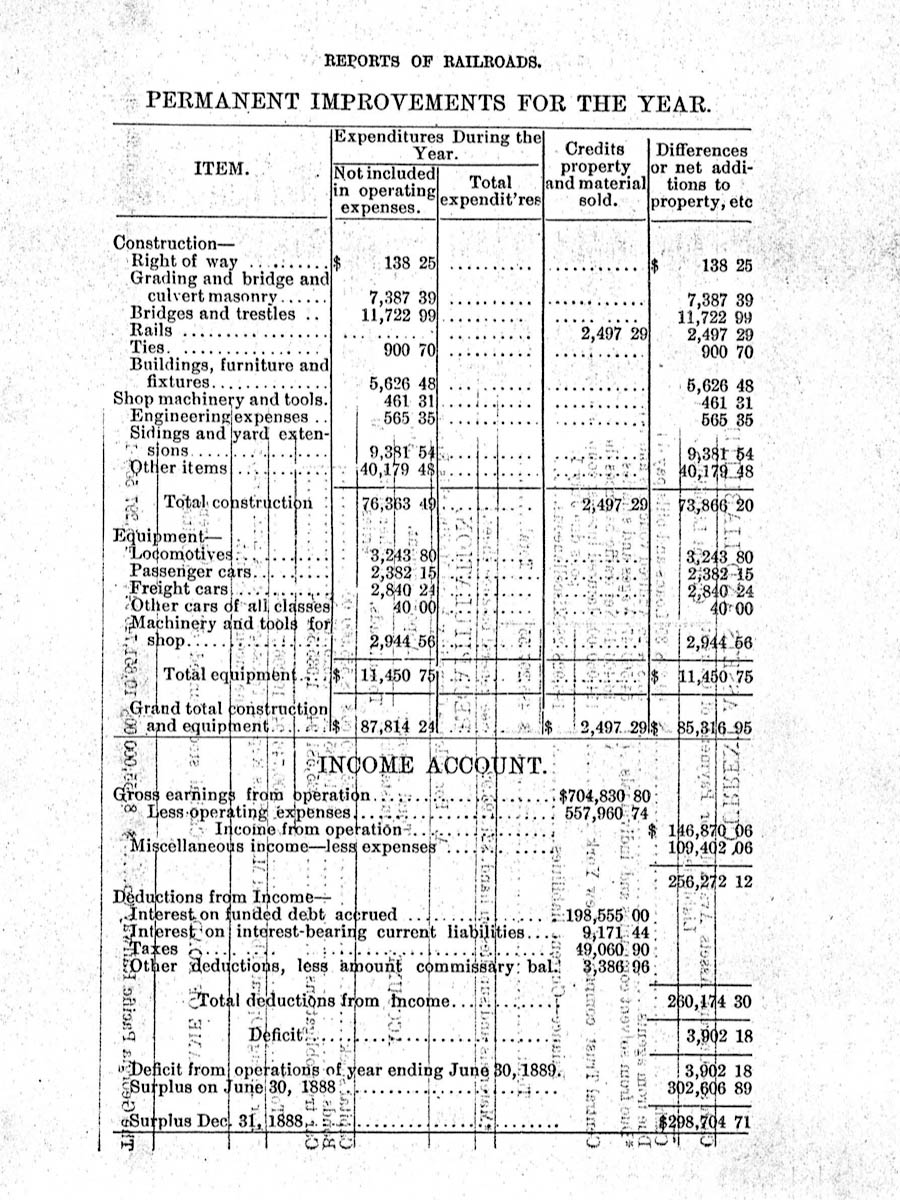
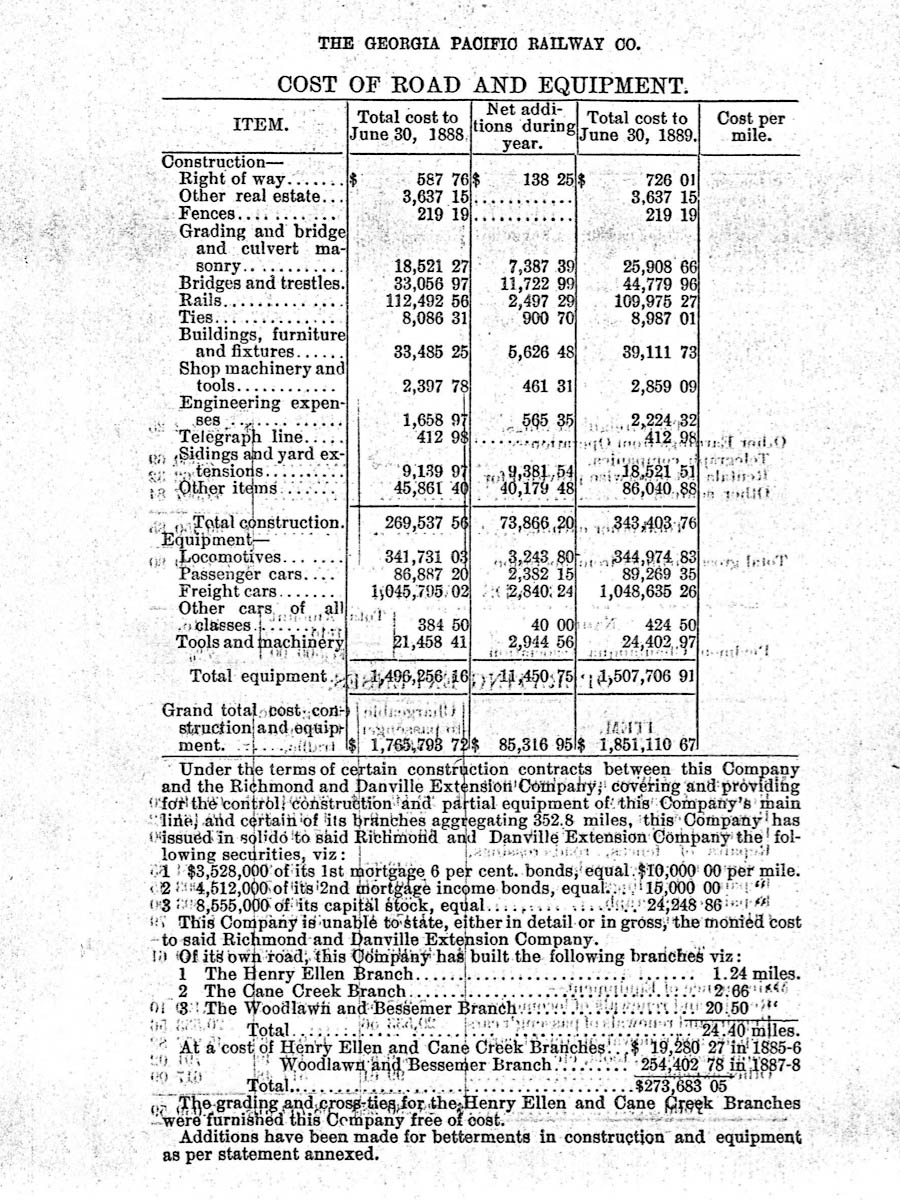
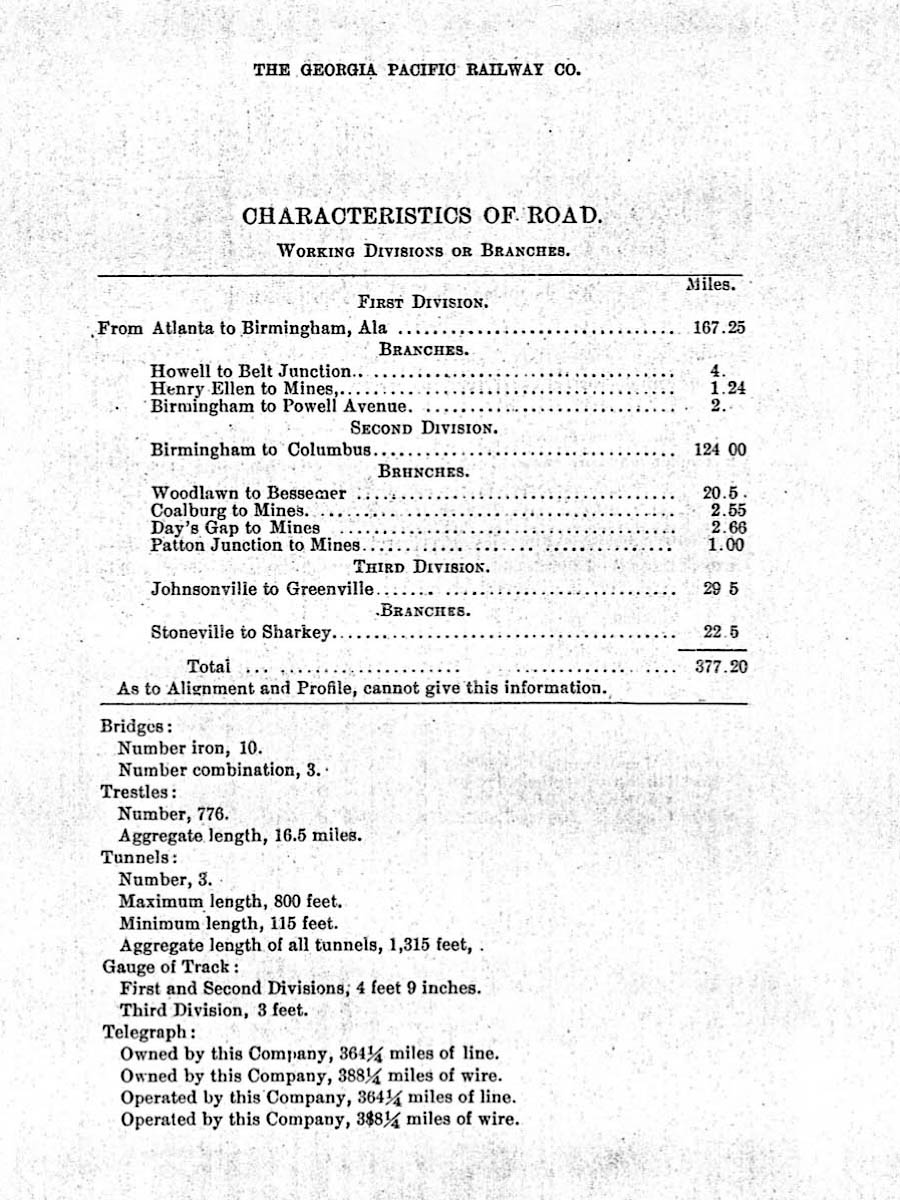

About this time a definite revival set in throughout the South as the long-drawn-out period of depression following the war came to an end. Railroad activity revived, and both the East Tennessee, Virginia & Georgia and the Richmond & Danville roads passed into the hands of new and more aggressive interests. The new owners constructed the Georgia Pacific, which ultimately crossed Alabama and Mississippi. To finance this enterprise and to consolidate their interests, a new holding company — the Richmond & West Point Terminal Railway and Warehouse Company — was formed in 1881 with large powers and authority to acquire the stocks and bonds of railroad properties in many Southern States.
John Moody — The Railroad Builders — 1920
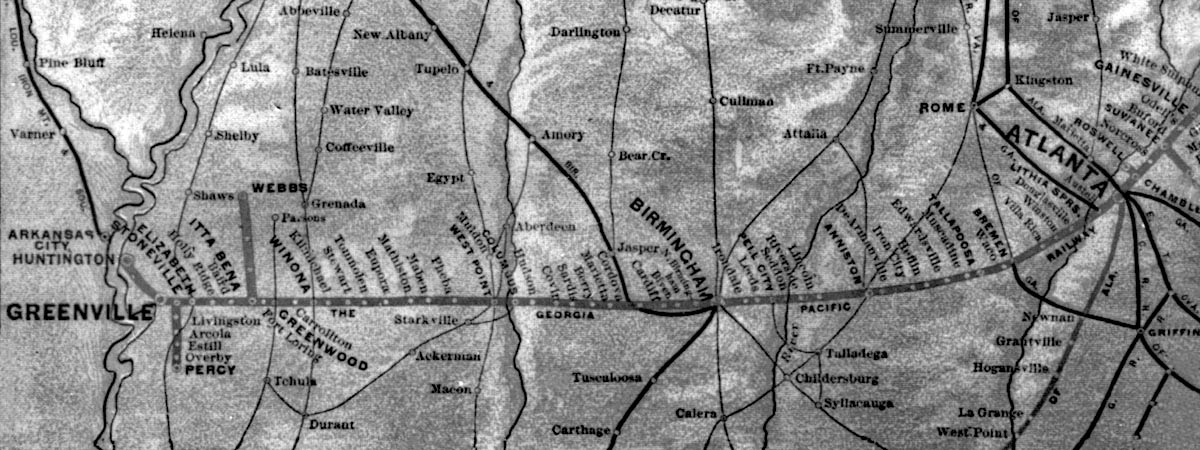
Georgia Pacific route map / collection
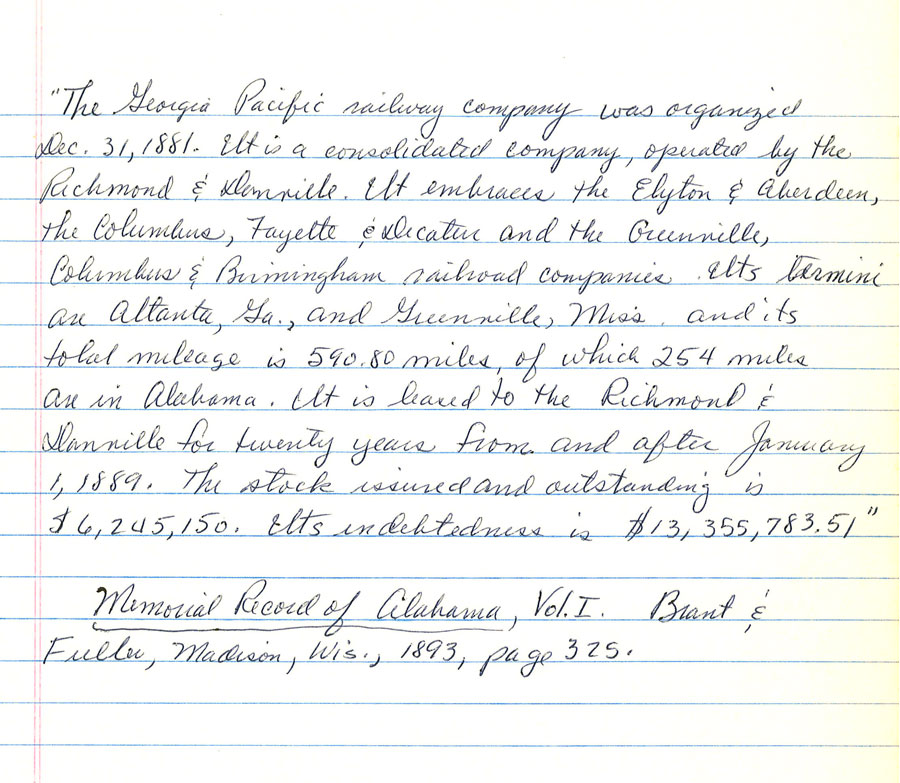
Georgia Pacific notes / JCH
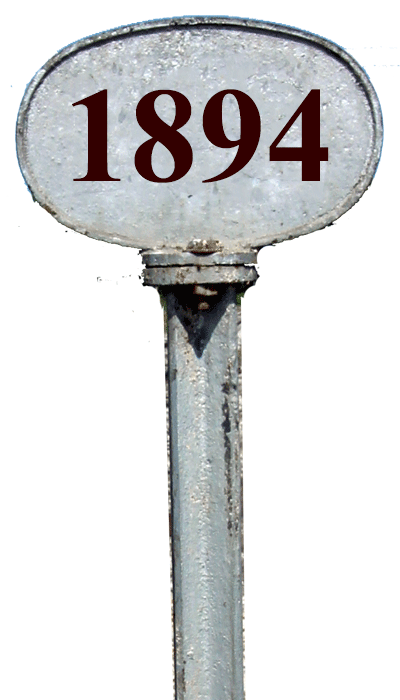 Southern Railway in Mississippi
Southern Railway in Mississippi
As the Richmond & Danville was being reorganized in 1894, the expanding system formed a new company called the Southern Railway Company in Mississippi to take over the former Georgia Pacific trackage in Mississippi on August 30 of that year. At that time, the state constitution required that all lines in Mississippi be owned by companies organized in the state. Meanwhile, the reorganized Richmond & Danville system would soon become the sprawling Southern Railway.
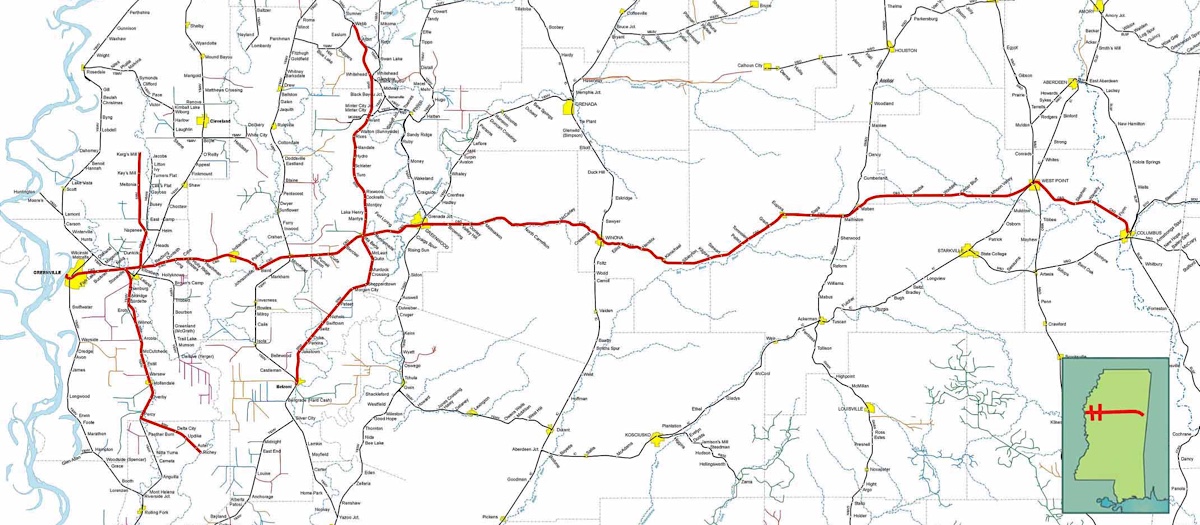
Southern Rwy in Mississippi map / Mississippi Rails
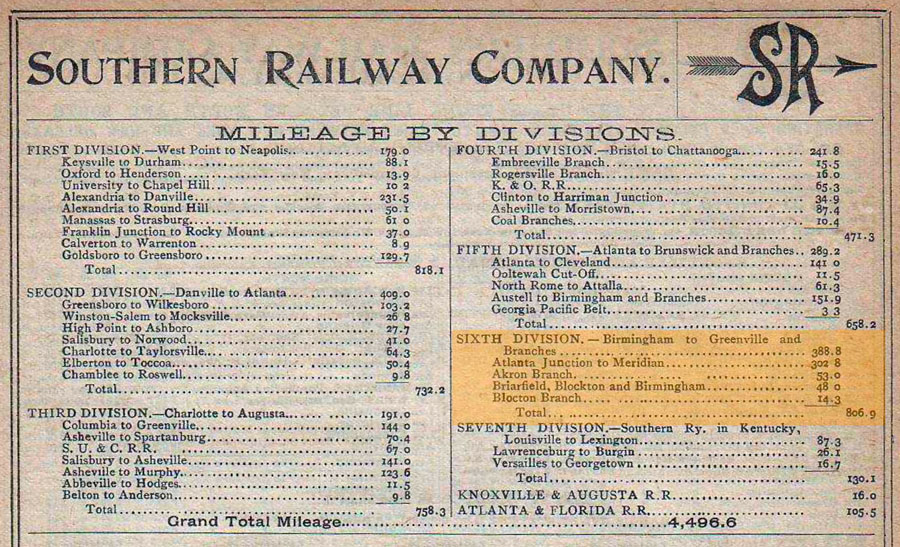
1895 Official Guide ad / collection
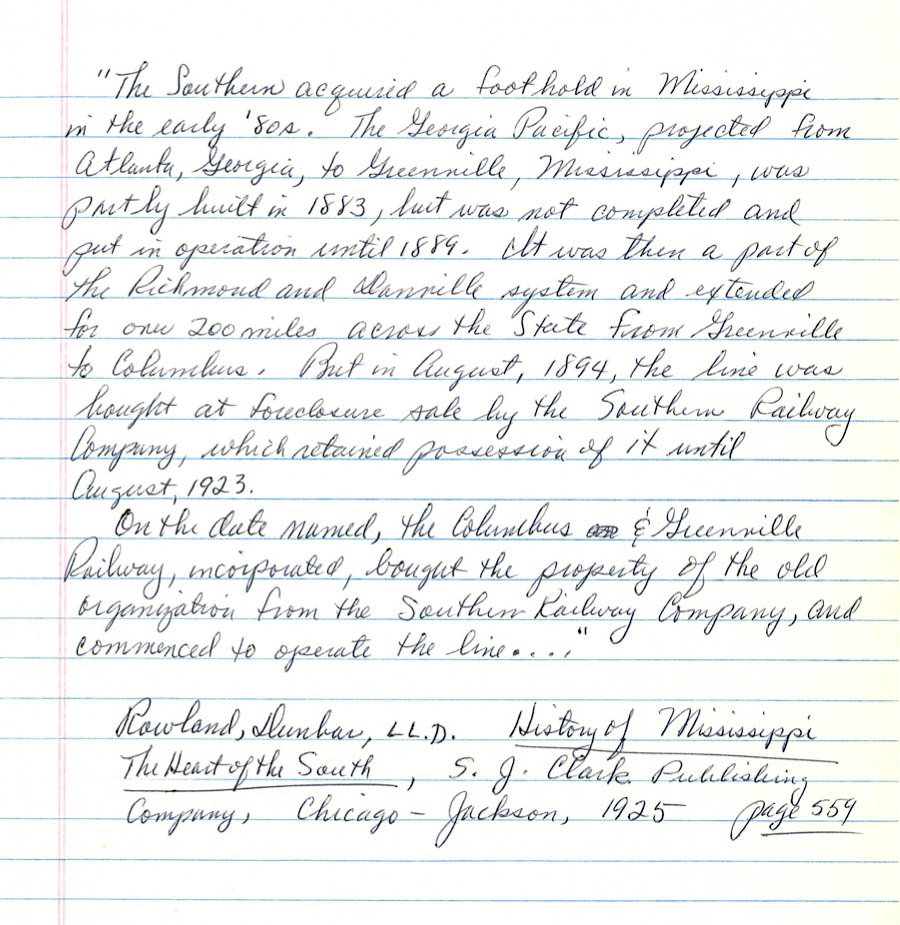
Southern Rwy in Mississippi notes / JCH

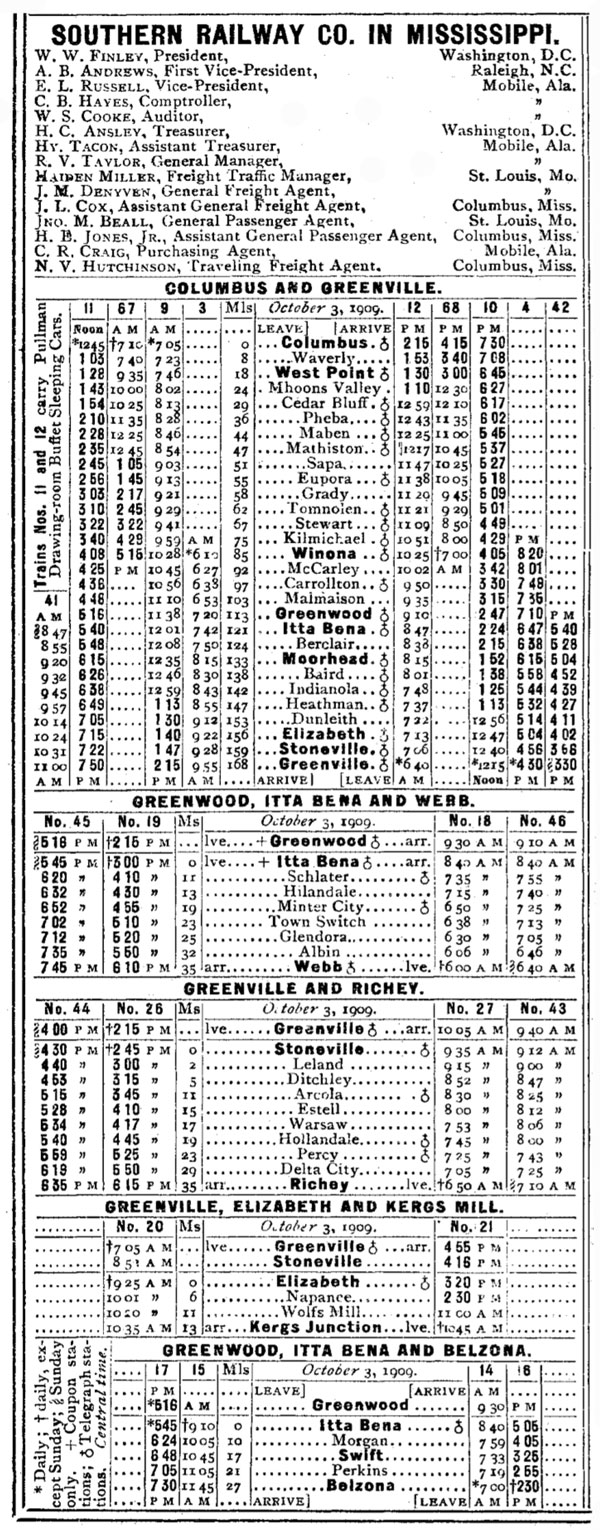
1910 Official Guide ad / collection
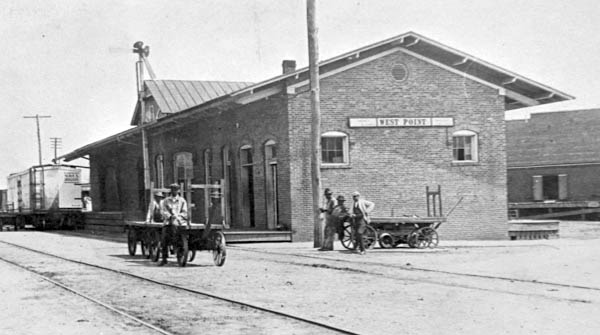
West Point, Ms / 1916 / collection
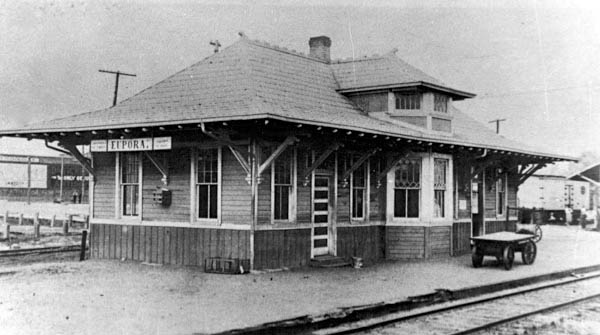
Eupora, Ms / 1916 / collection

Moorhead, Ms / 1916 / collection

Stoneville, Ms / 1916 / collection
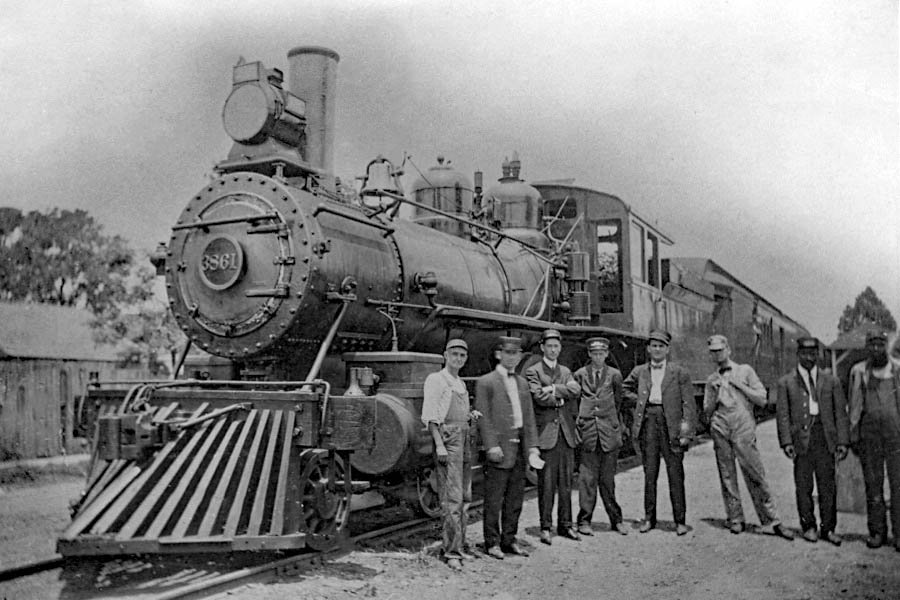
Greenville, Ms / 1917 / collection
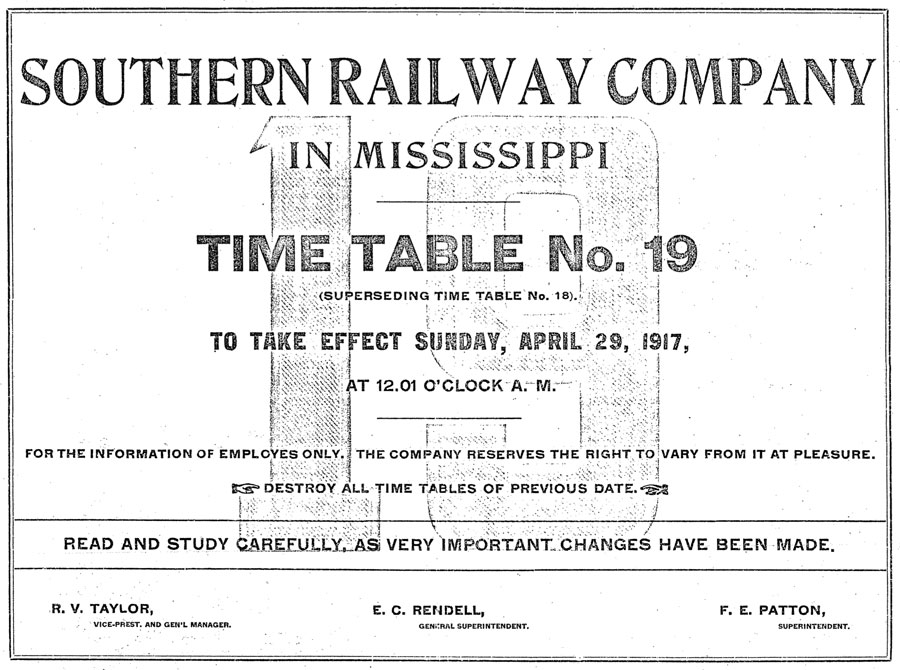
1917 SRM employee timetable cover / collection

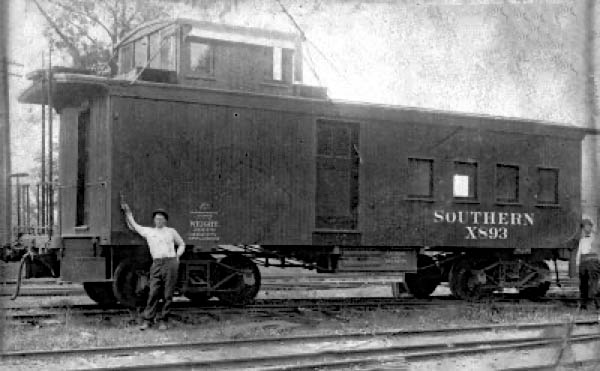
Columbus, Ms / 1915 / Mississippi Rails
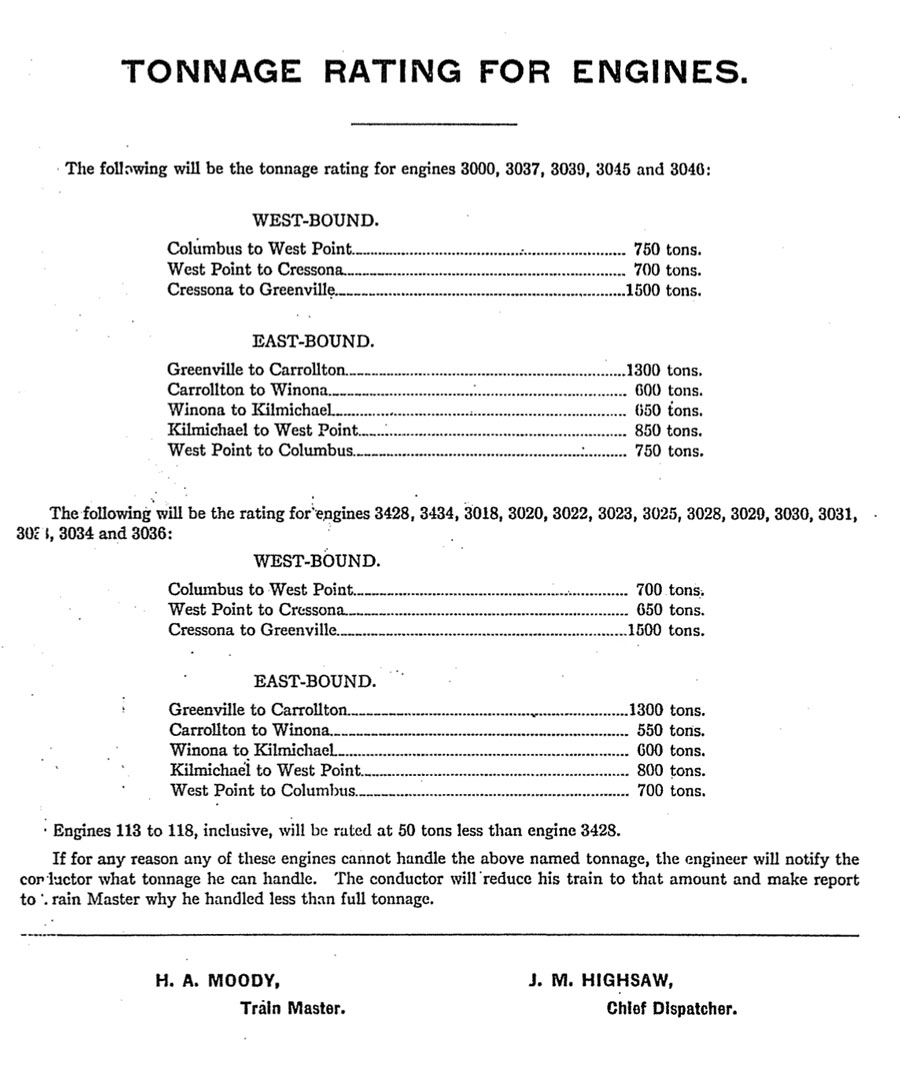
1917 tonnage table / collection

collection
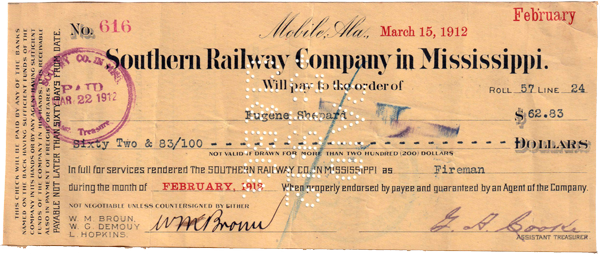
collection
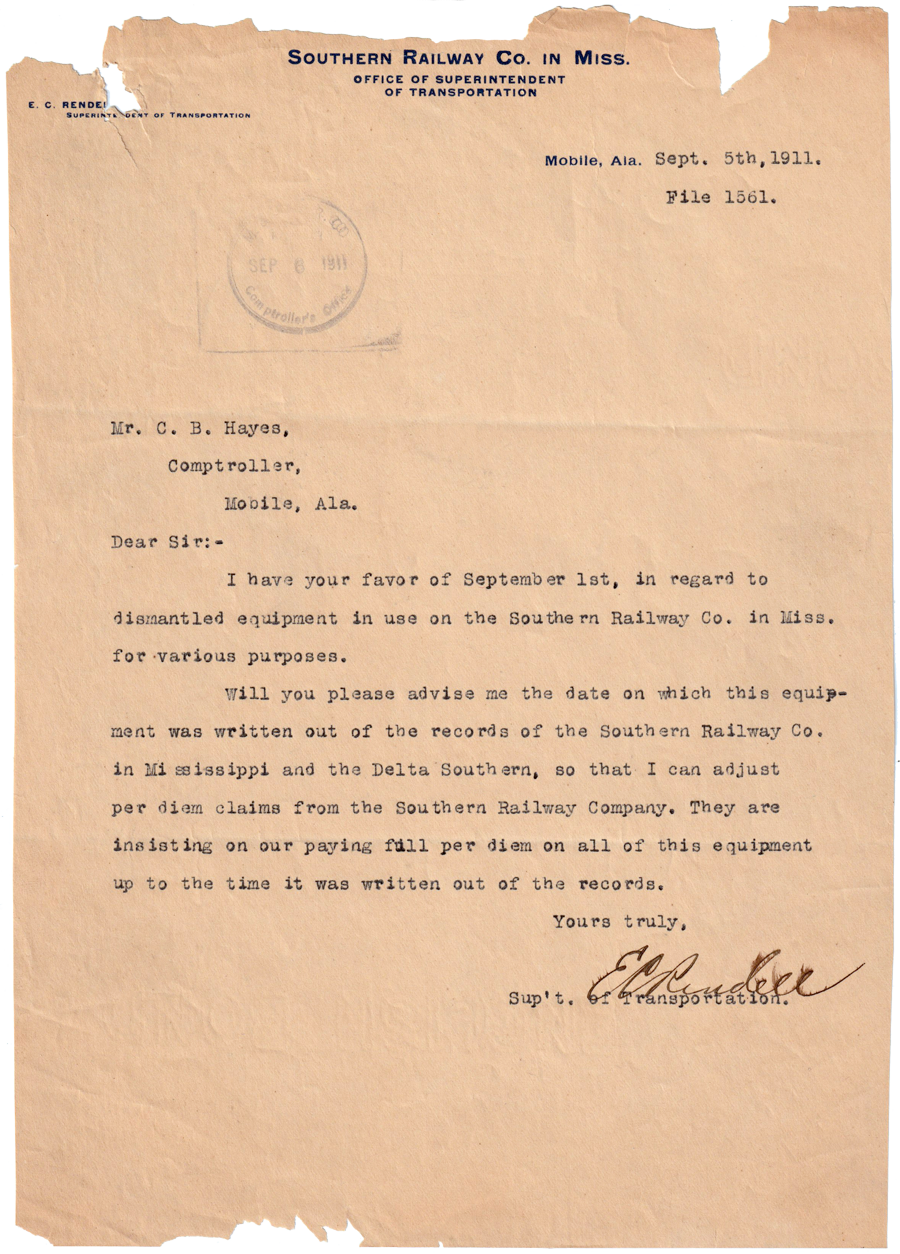
1911 SRM transportation letter / collection
 Columbus & Greenville Railroad
Columbus & Greenville Railroad
The charter of the struggling Southern Railway Company in Mississippi was amended in November of 1920 to change the name of the operation to the Columbus & Greenville Railroad. The new company was almost immediately placed in receivership.
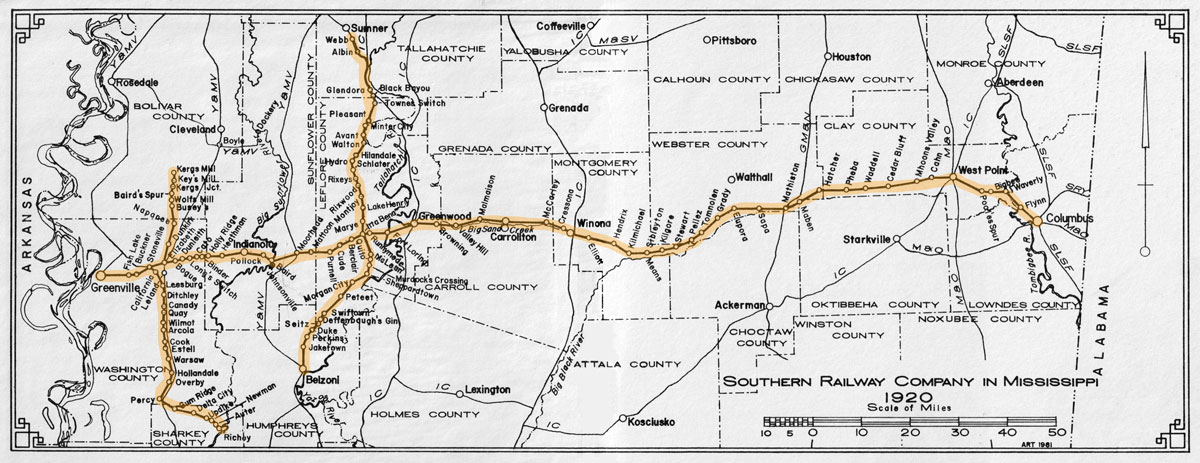
1920 route map / Art Richardson / collection
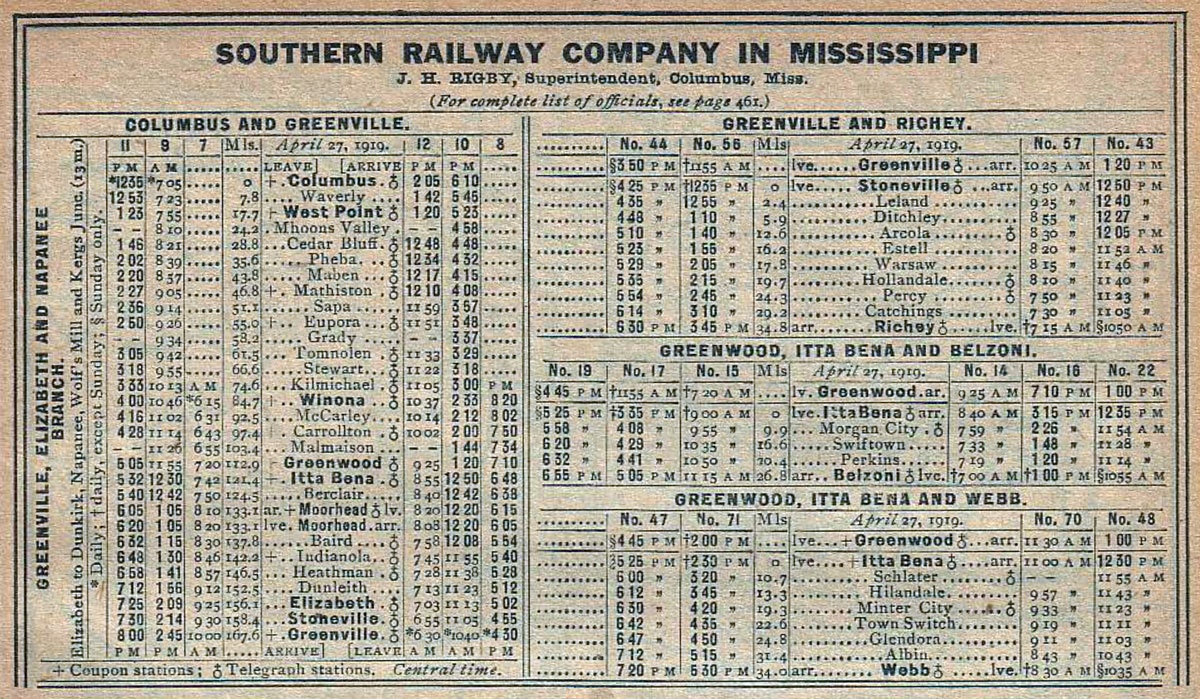
1920 Official Guide ad / collection
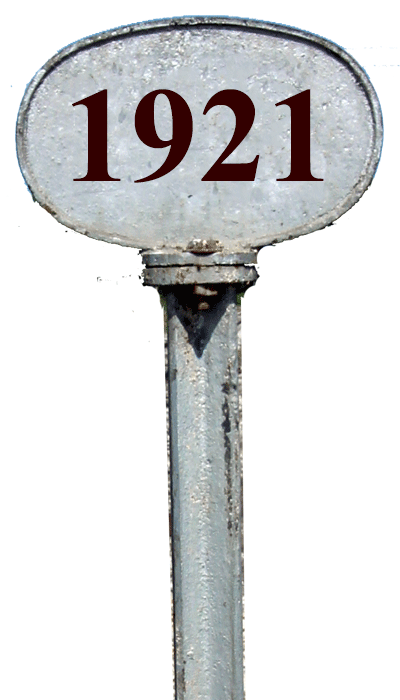 Adam Tonquin Stovall
Adam Tonquin Stovall
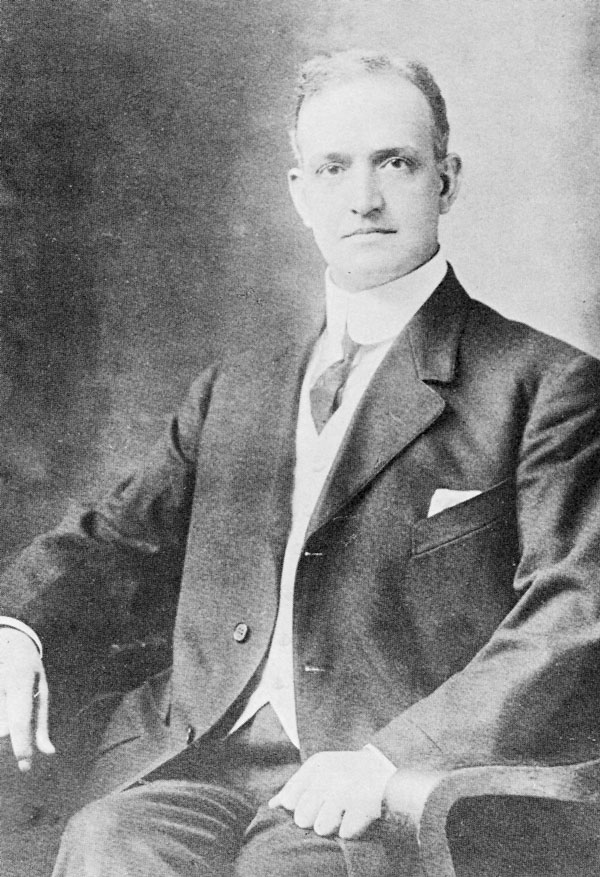
collection
In June of 1921, Adam Tonquin Stovall (1868-1938) was named receiver of the beleaguered Columbus & Greenville Railroad. Born and reared in Okolona, Mississippi, northwest of Columbus, Stovall was educated for law and practiced it in his hometown after studies at Virginia Military Institute and the University of Mississippi. In 1890 he become the local attorney for the Mobile & Ohio Railroad, whose mainline ran through the area. He held the position until 1921, when he retired from law to begin rehabilitation of the C&G Railroad. Stovall was a devout Baptist, active in humanitarian causes, and a leader in efforts to provide education and opportunities for citizens of color.

He was a man of fine social qualities. His kindly nature and the democracy of his spirit drew people to him, and he enjoyed their companionship. He was just, kind, loving, and generous, and his sympathies were not restricted by race or creed, but where were need and suffering he was ready to serve. He gave much to charity, and perhaps no destitute person, no spokesman for a worthy cause, ever appealed to him in vain. He asked no questions of those who appealed to him for aid, but recognized a fellow-being in distress, and needing assistance with some vexatious problems, that he would do unto others as in like circumstances he would have others do unto him.
Mattie Lee Buchanan
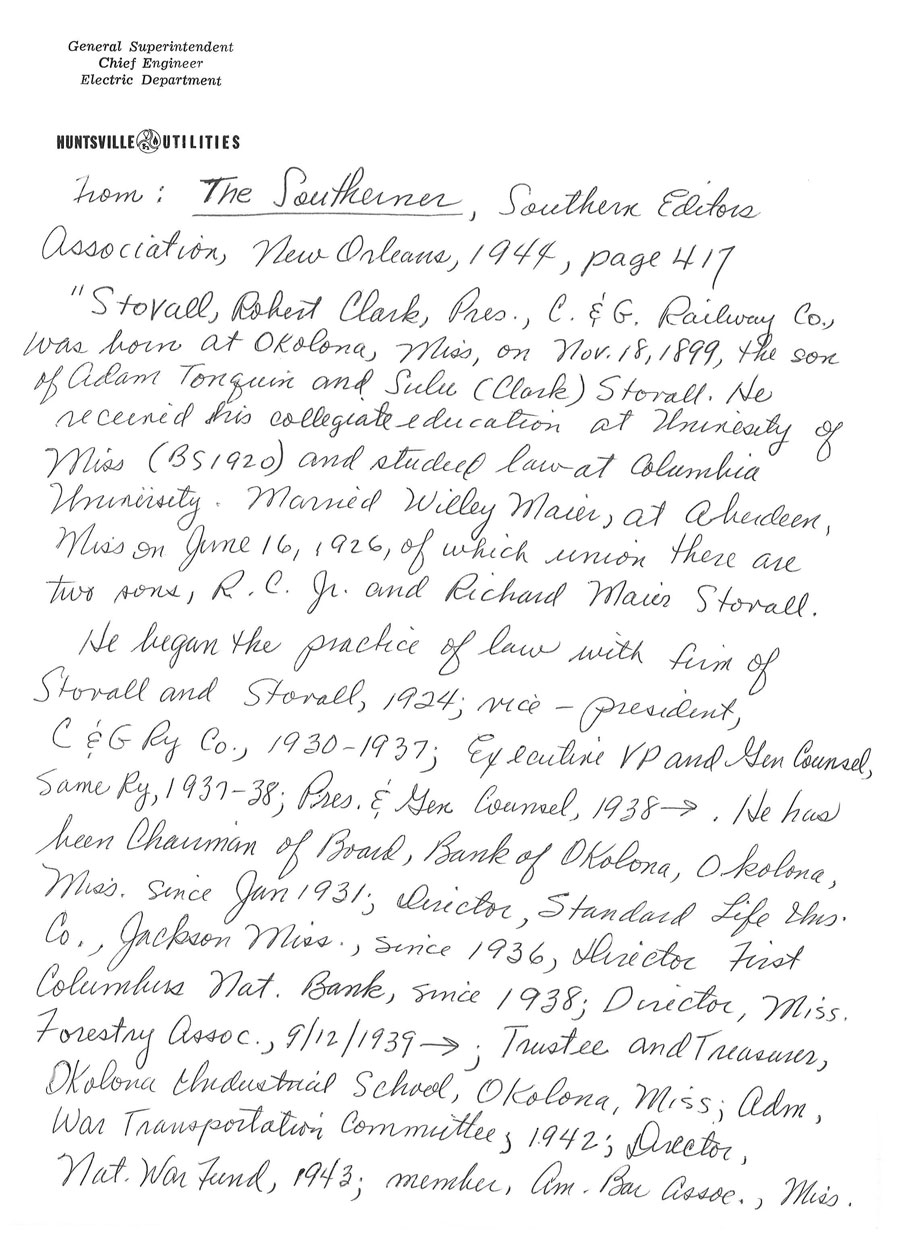
Adam Stovall notes / JCH
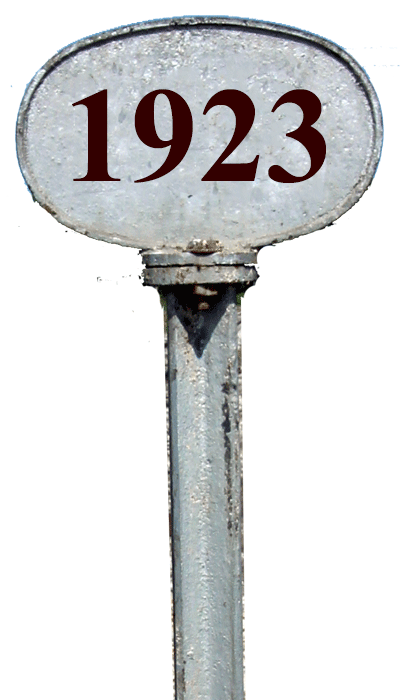 Columbus & Greenville Railway
Columbus & Greenville Railway

After two years in receivership, the railroad was sold to local interests at a receiver's sale on August 6, 1923 — thus severing ties with its corporate parent Southern Railway and its several predecessors after nearly half a century. The shortline was renamed the Columbus & Greenville Railway, and Adam Tonquin Stovall was elected president. Under his leadership, and relying heavily on secondhand motive power and rolling stock, rehabilitation of the physical plant and financial standing of the company was begun in earnest.

Columbus, Ms / collection
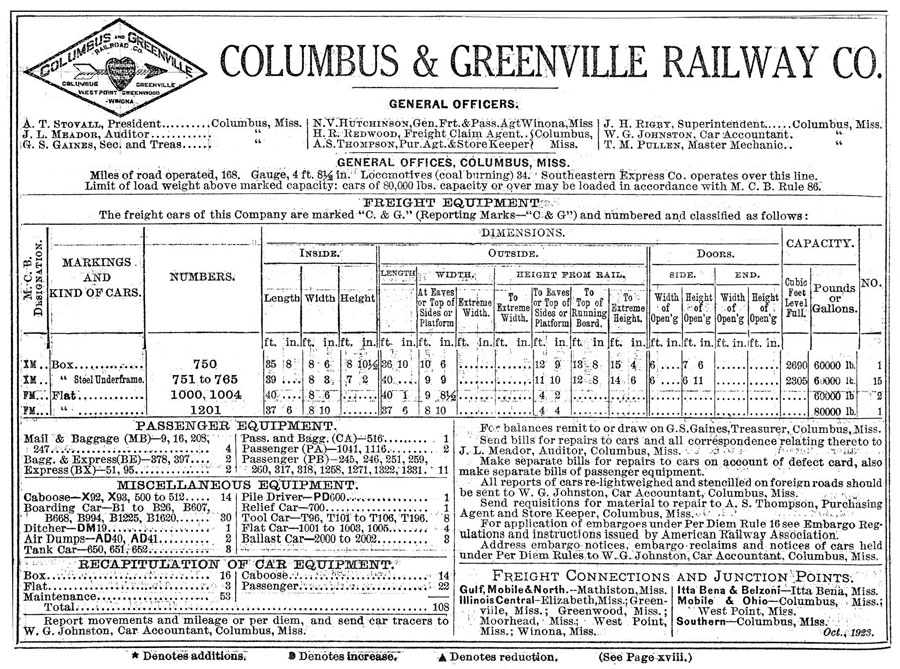
1923 Official Railway Equipment Register / collection
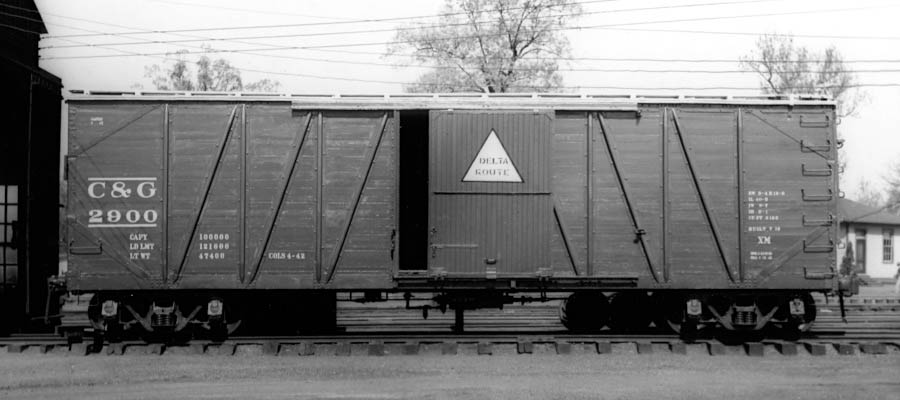
collection
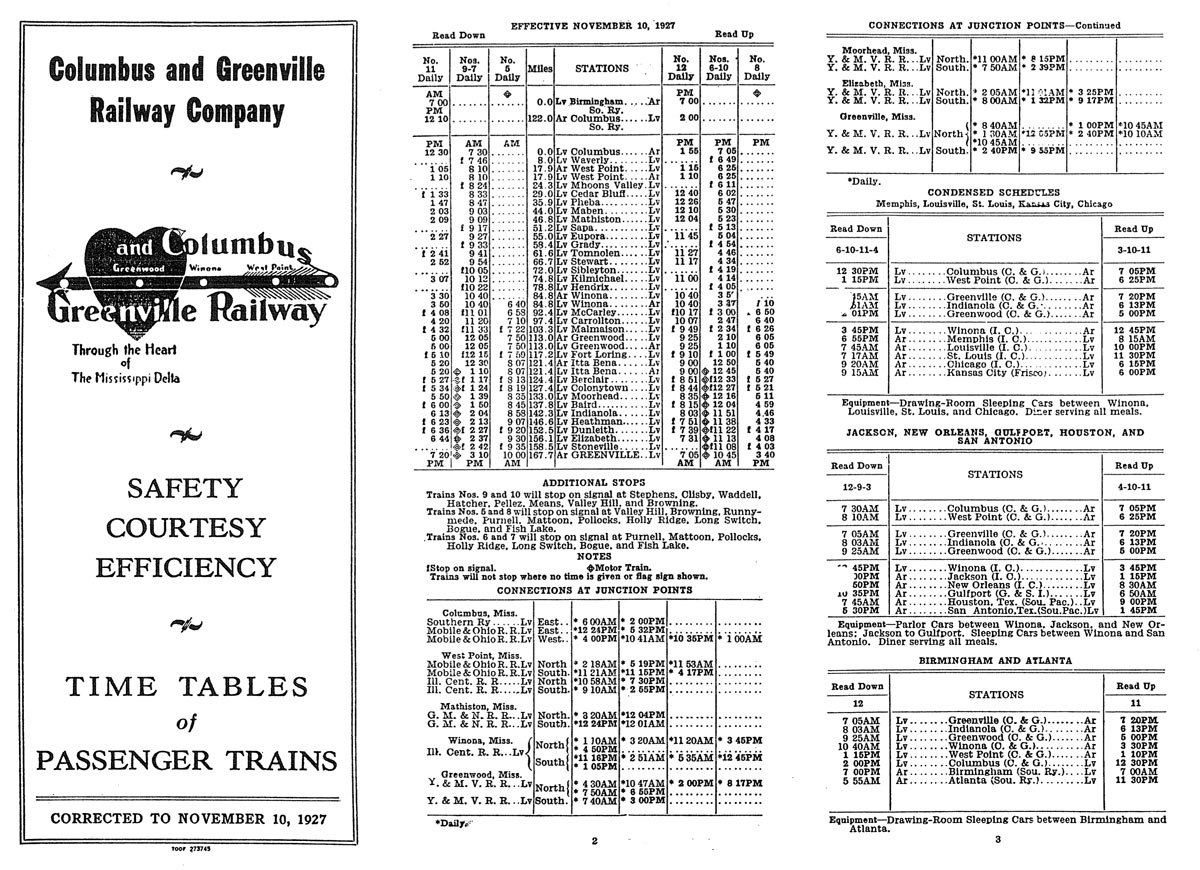
1927 timetable / collection
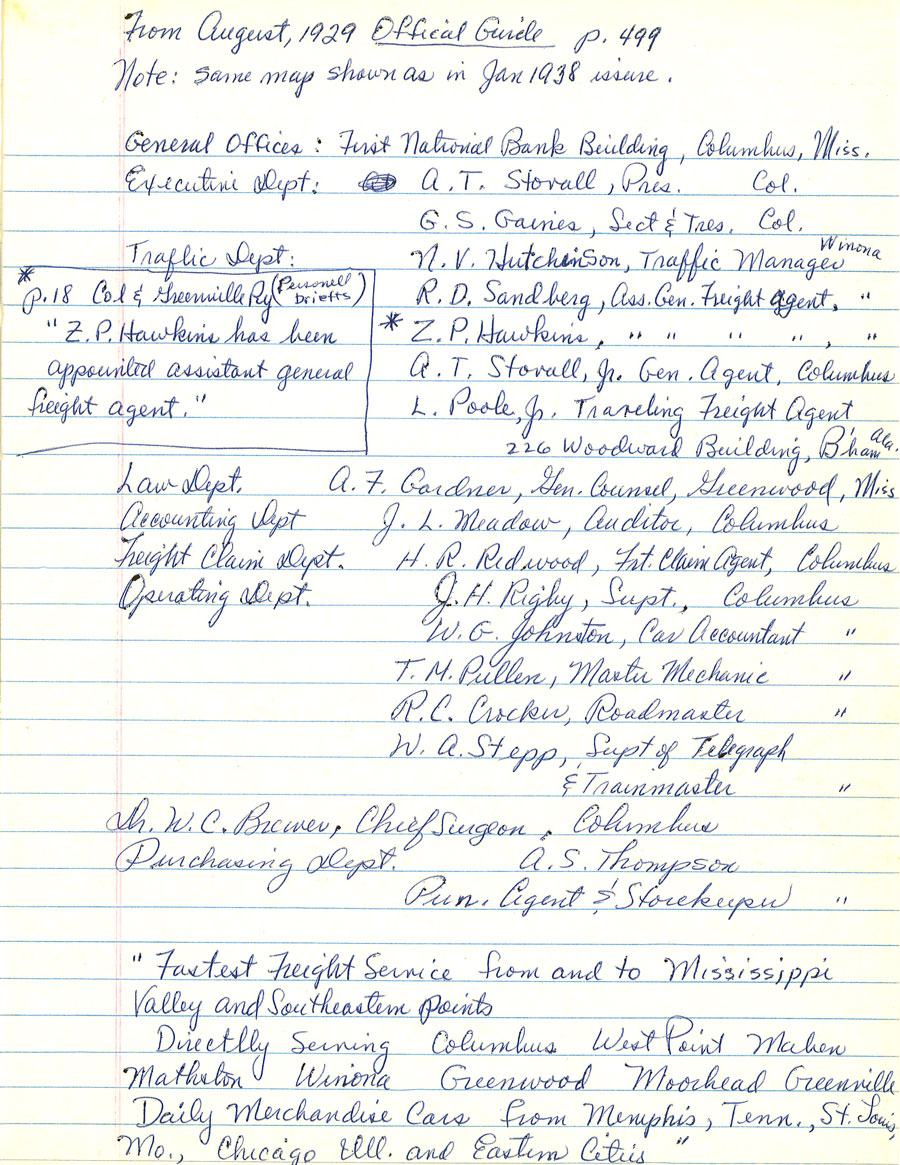
1929 Official Guide notes / JCH

1929 Official Guide notes / JCH
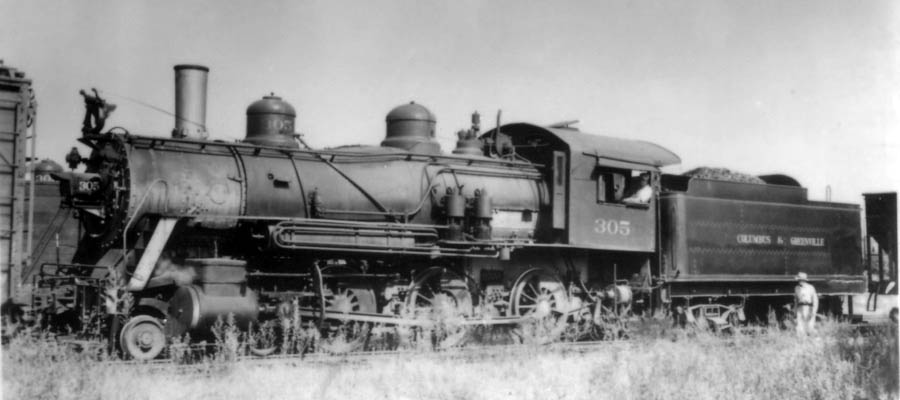
collection
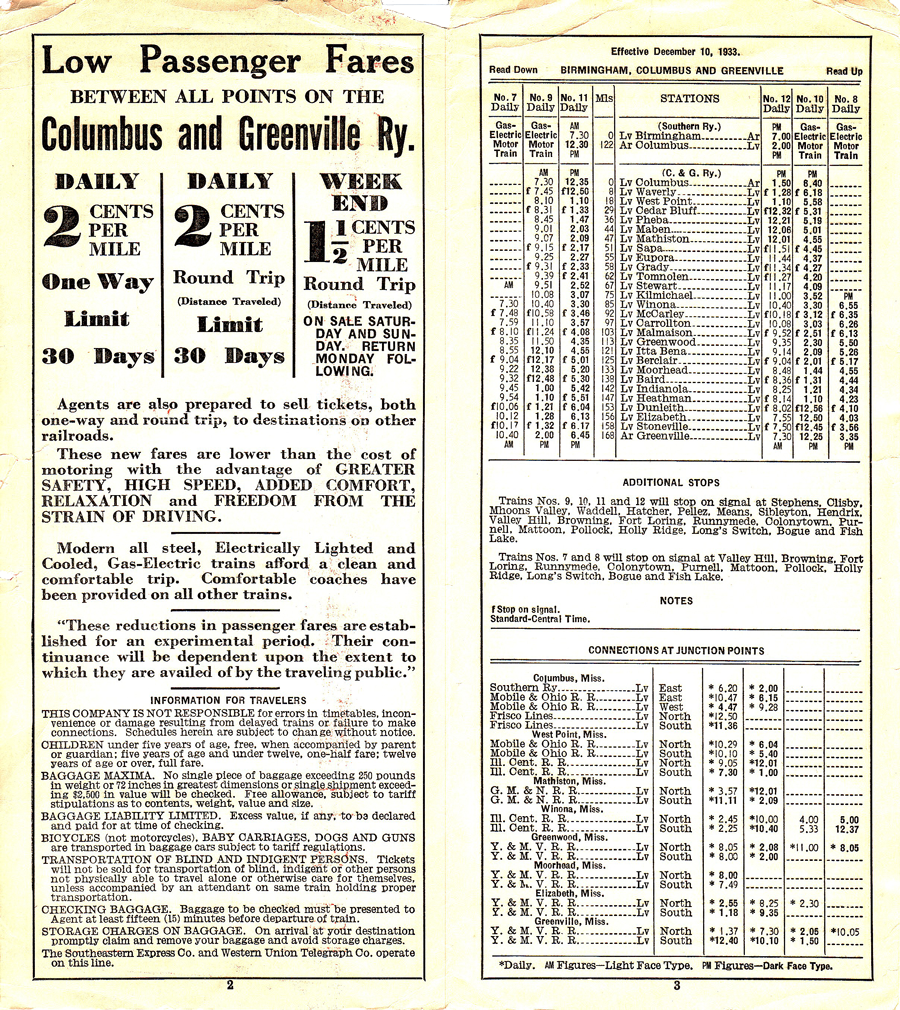

1930 Official Guide ad / collection
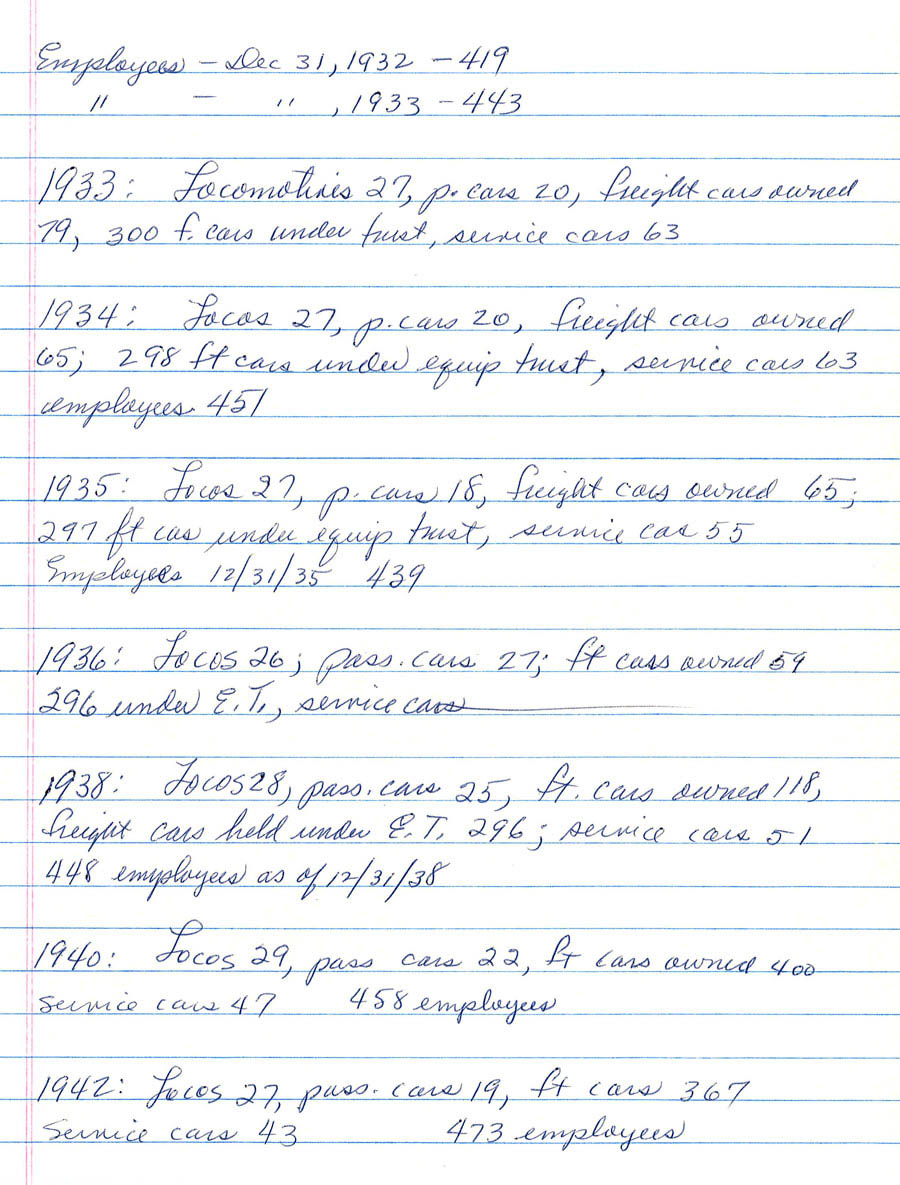
company summary notes / JCH
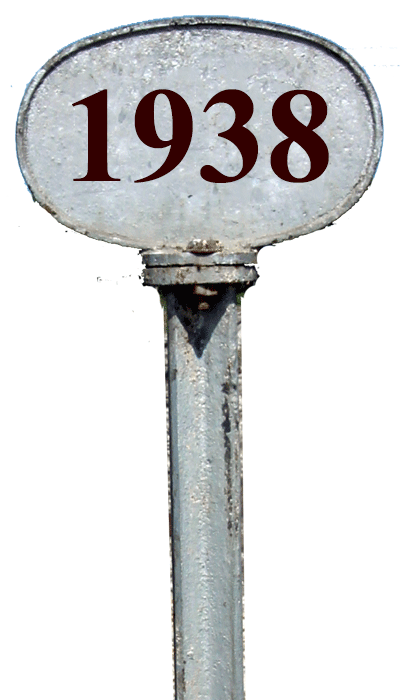 Adam Tonquin Stovall
Adam Tonquin Stovall
On March 1, 1939, A. T. Stovall died at age 70 after health issues. He served as the independent Columbus & Greenville Railway's first president up until his death, and was succeeded by his son, Robert Clark Stovall. R. C. Stovall was like his father, a lawyer by training, and had been serving as the railroad's executive vice president at the time of his father's death.
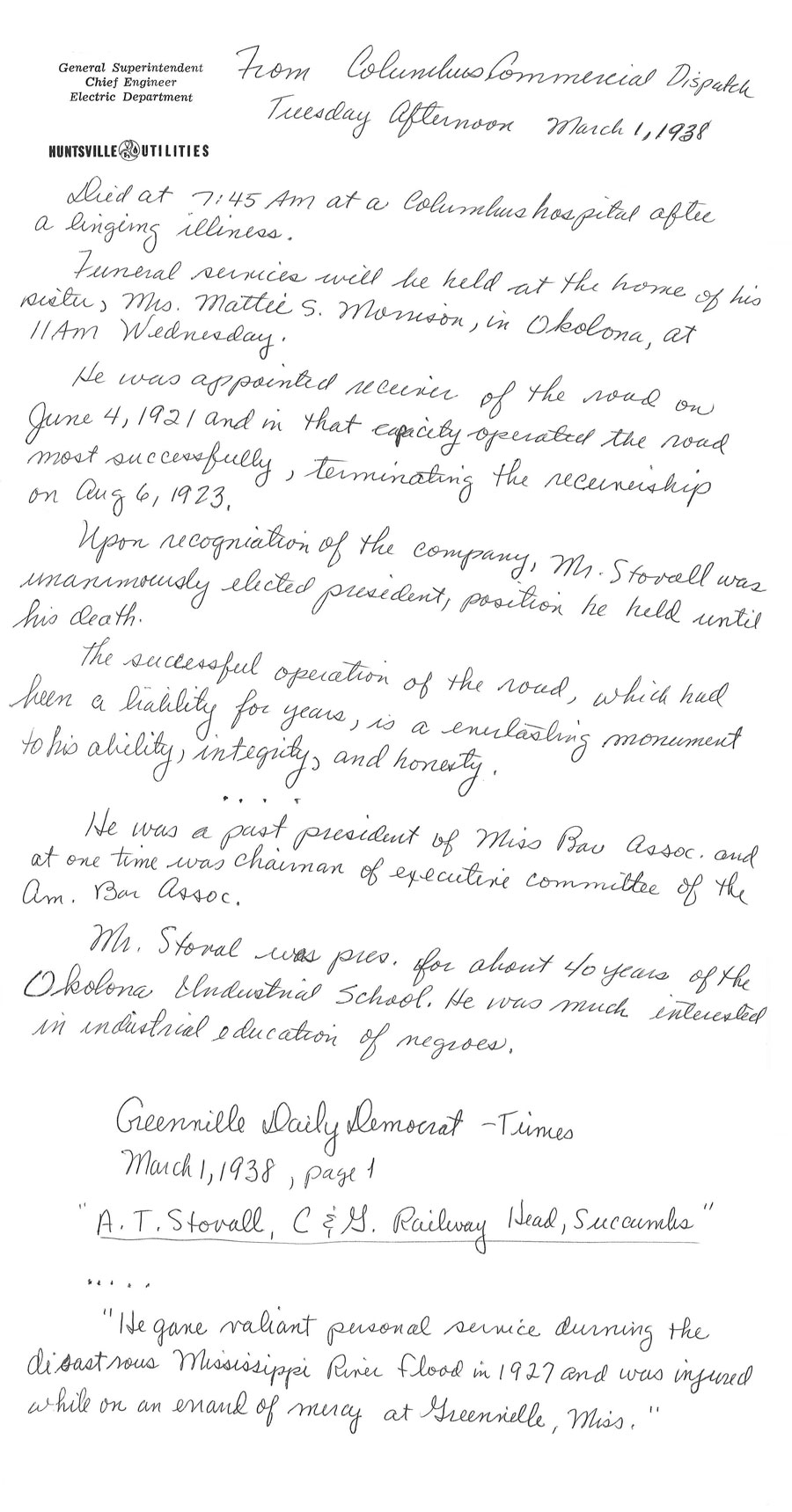
Adam Tonquin Stovall notes / JCH
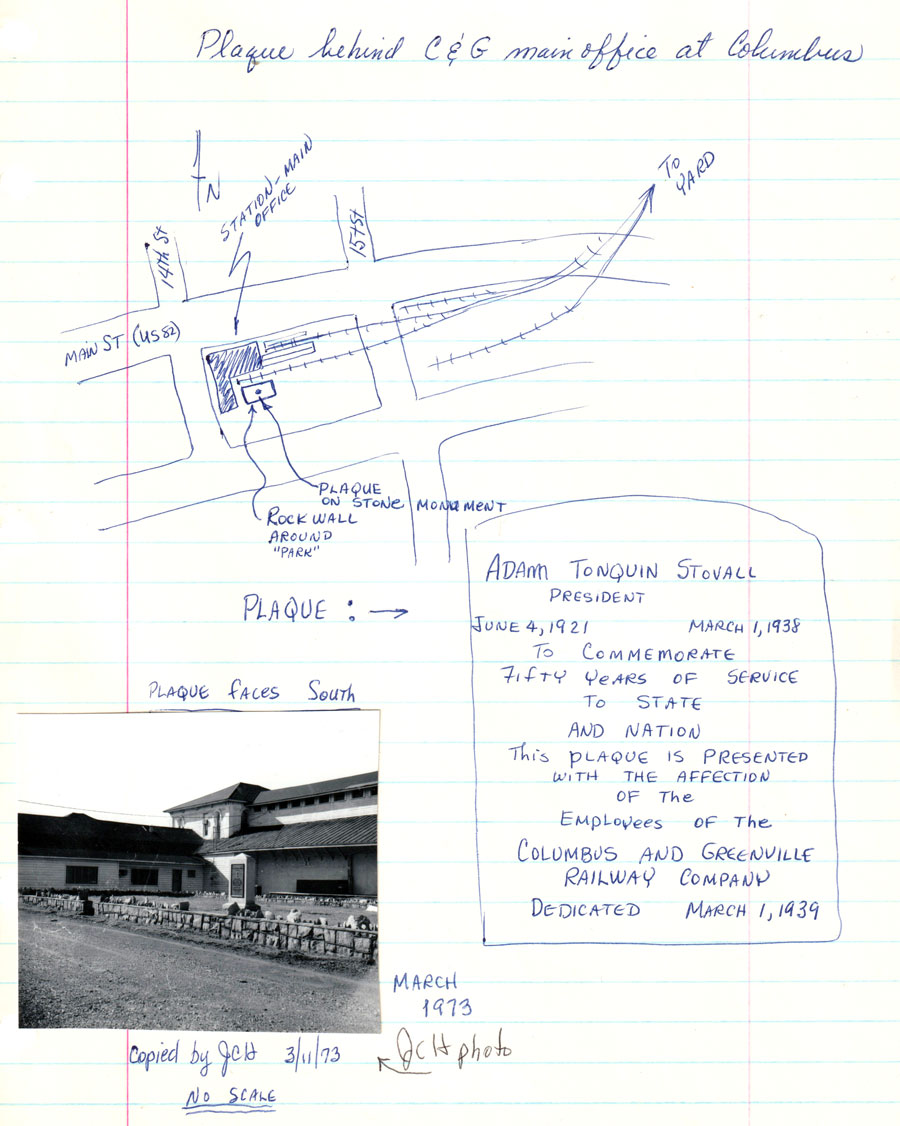
Stovall memorial notes / JCH

Columbus, Ms / Mar 1944 / collection

Columbus, Ms / Jun 2020 / RWH

Columbus, Miss., Feb. 27, 1939.
Employees of the Columbus & Greenville Railway Co. will gather here Wednesday for the unveiling of a monument to their late president, Adam Tonquin Stovall, who died on March 1, 1938.
In 1921 he was appointed receiver of the Columbus & Greenville Railroad, with headquarters at Columbus. When the receivership terminated in 1923, Mr. Stovall was elected president of the newly organized company. He guided the C. & G. through crisis after crisis with the hand of a genius. In all problems he considered employes, communities served by the line, and, finally, the road itself. No finer mutual accord ever existed in the field of employer-employee relationship than that which existed between Mr. Stovall and those associated with him in the operation of the C. & G. He considered them all his partners in the enterprise. Because of his interest in and regard for those who worked with him, the employes of the company, to a man, have contributed one day's pay to the purchase and erection of the memorial.
Commercial Appeal — Memphis, Tenn. — Feb. 28, 1939.

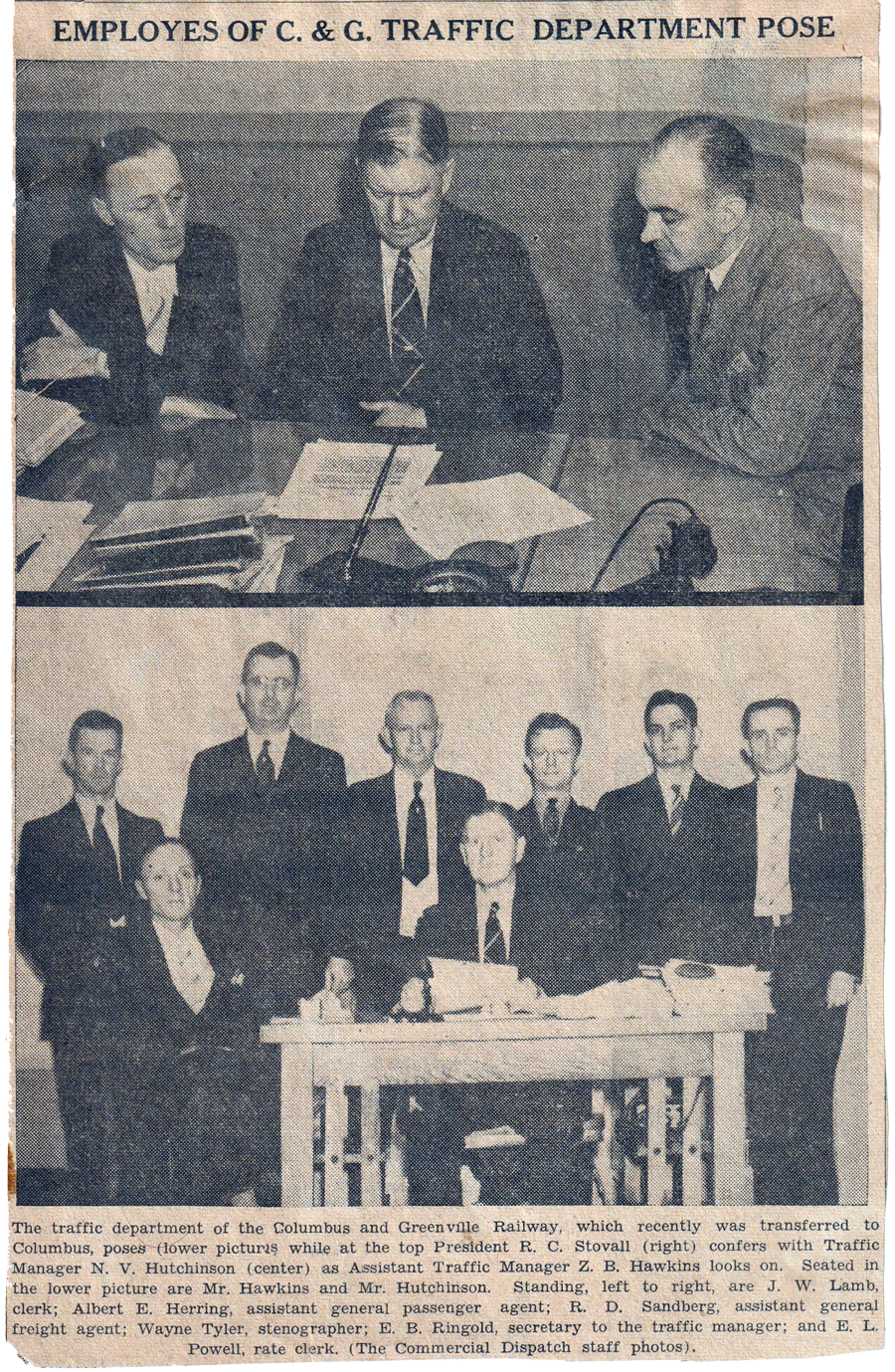
Columbus Commercial Dispatch — Jun 1938 / collection
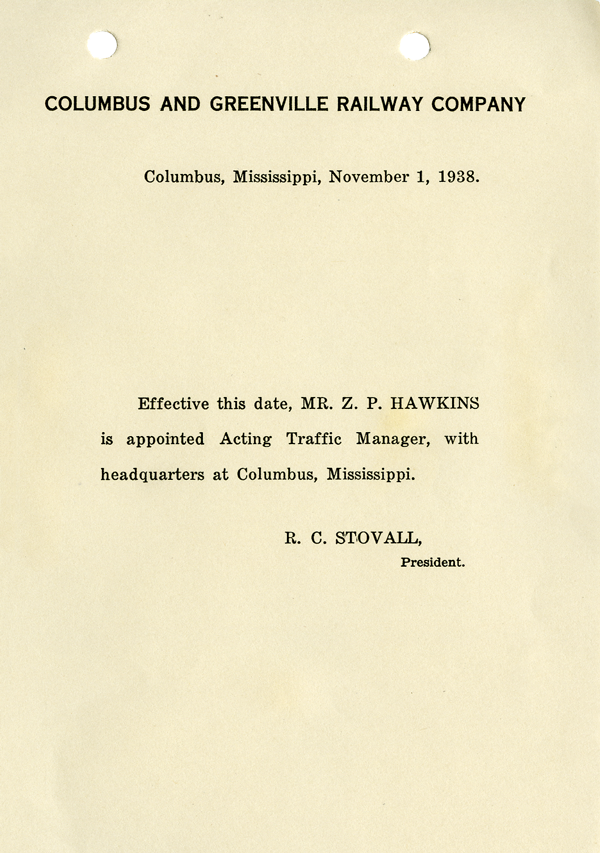
1938 presidential memo / collection

1939 presidential memo / collection
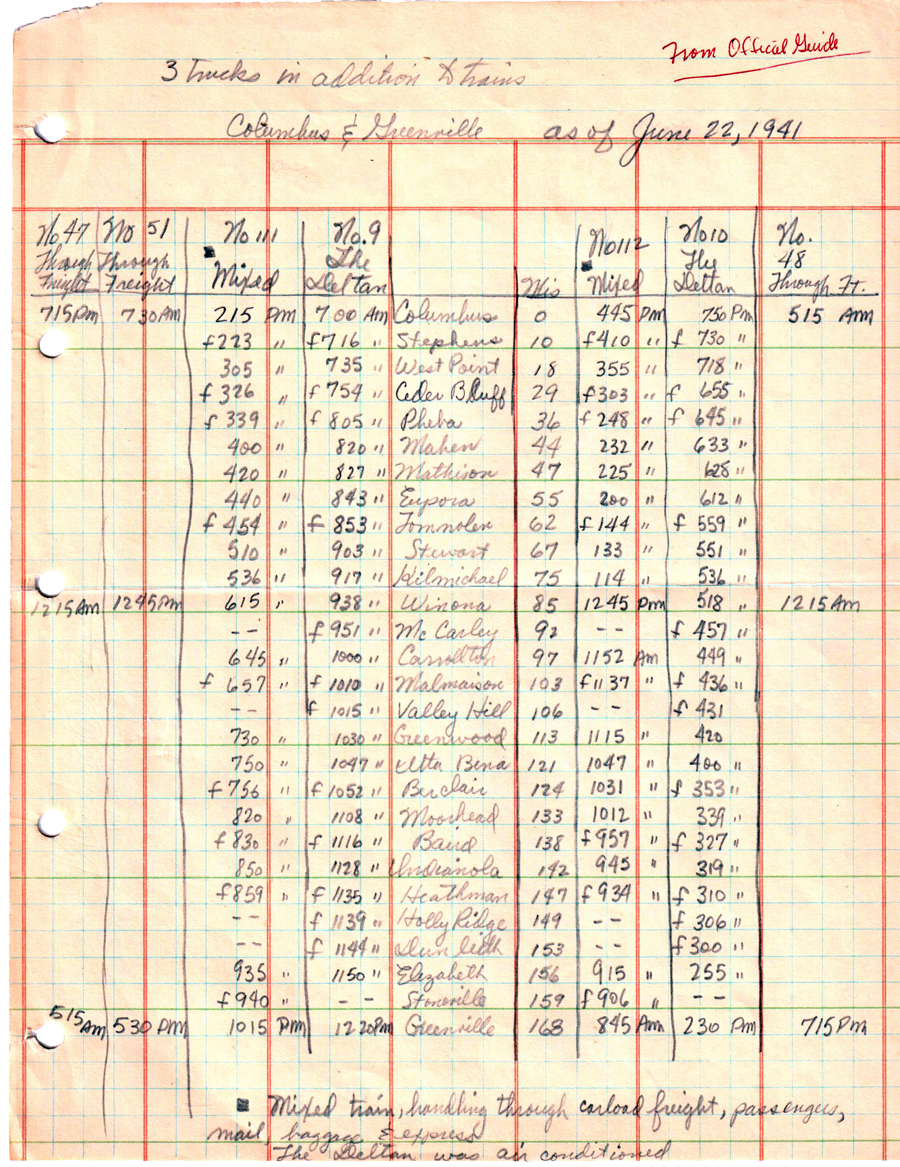
1941 Official Guide notes / JCH


1942 timetable / collection
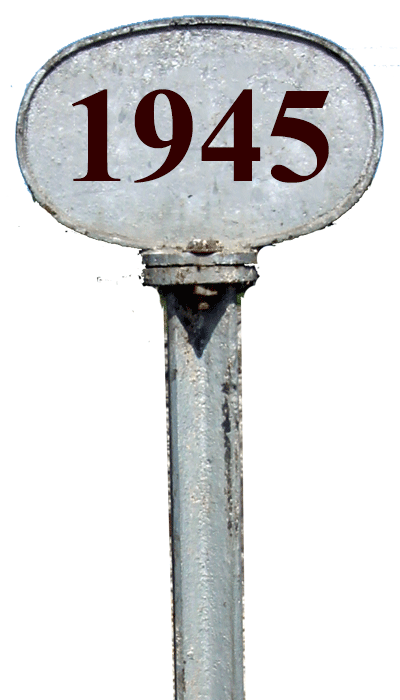 C&G orders first diesel-electric locomotives
C&G orders first diesel-electric locomotives
Only 17 days after the Japanese surrender and the end of World War II, the Columbus & Greenville took steps to solve its glaring wartime motive power deficiencies by placing a historic order with the Baldwin Locomotive Works of Philadelphia. C & G's Master Mechanic W. A. Traylor Jr. submitted an order for 5 diesel-electric road switchers with much-needed horsepower balances with features particularly suited to the road's lightweight mainline. These Baldwins would be the first new motive power ever purchased by the shortline, would prompt the retirement for nearly all the road's aged steamers, and would be Baldwin's first road switchers placed in service to a domestic customer. The locomotives would go on to serve the Delta Route for nearly 40 years, and would secure for the postwar company a place in the annals of Southern shortlines as a railroad ahead of its time.
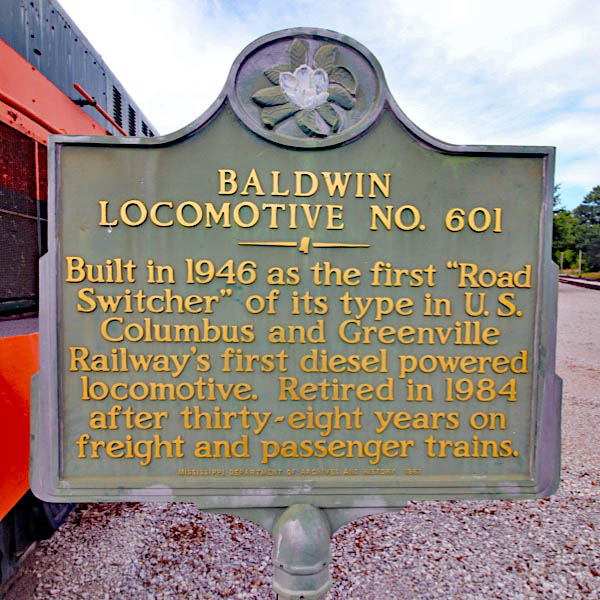
Jun 2020 / RWH
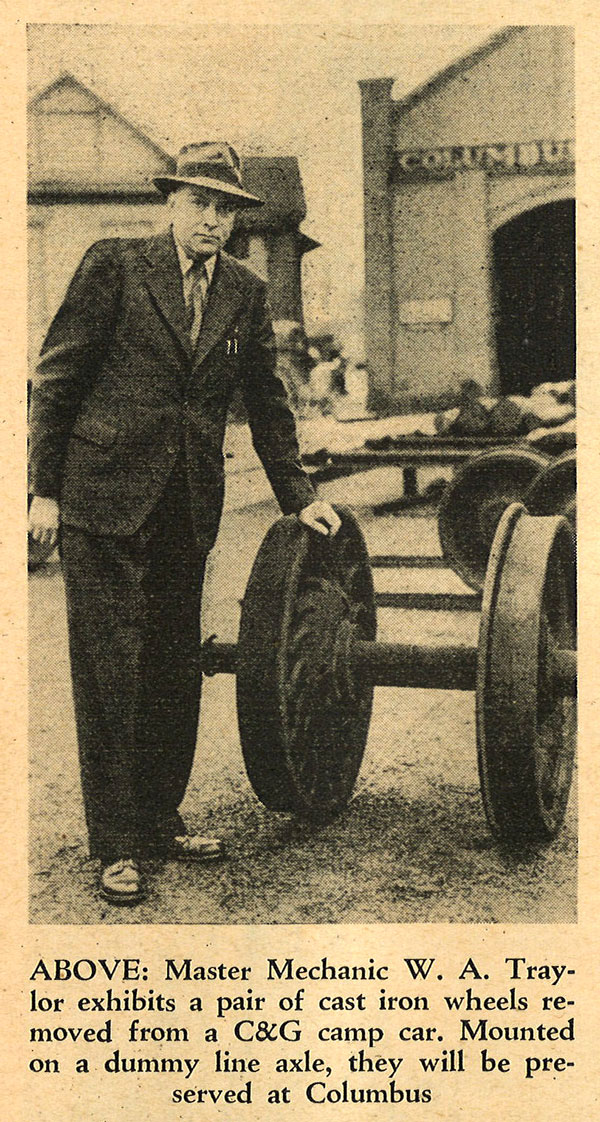
collection
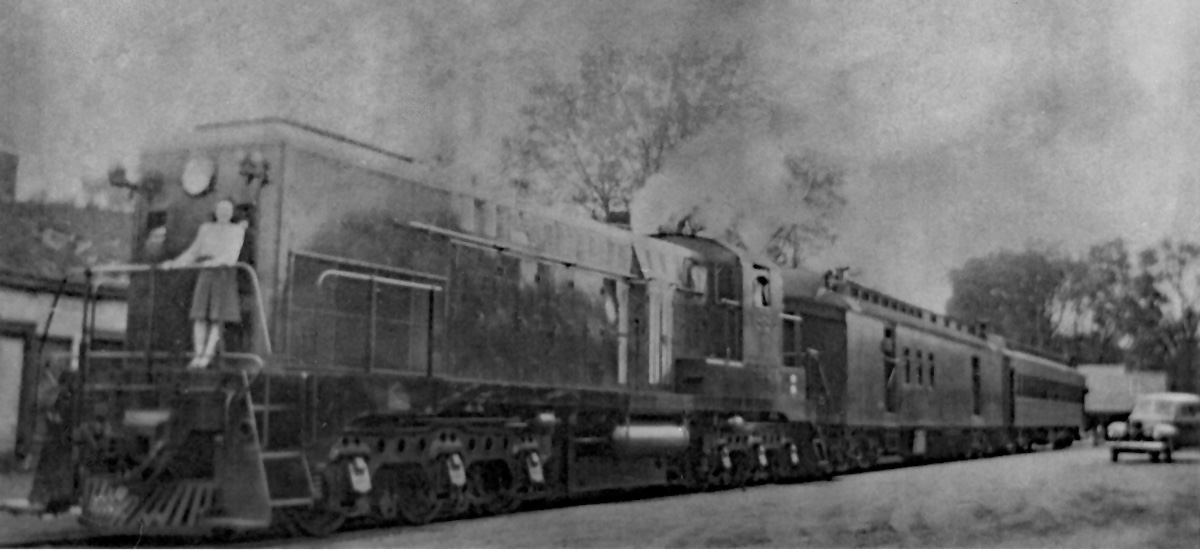
Columbus, Ms / 1946 / collection
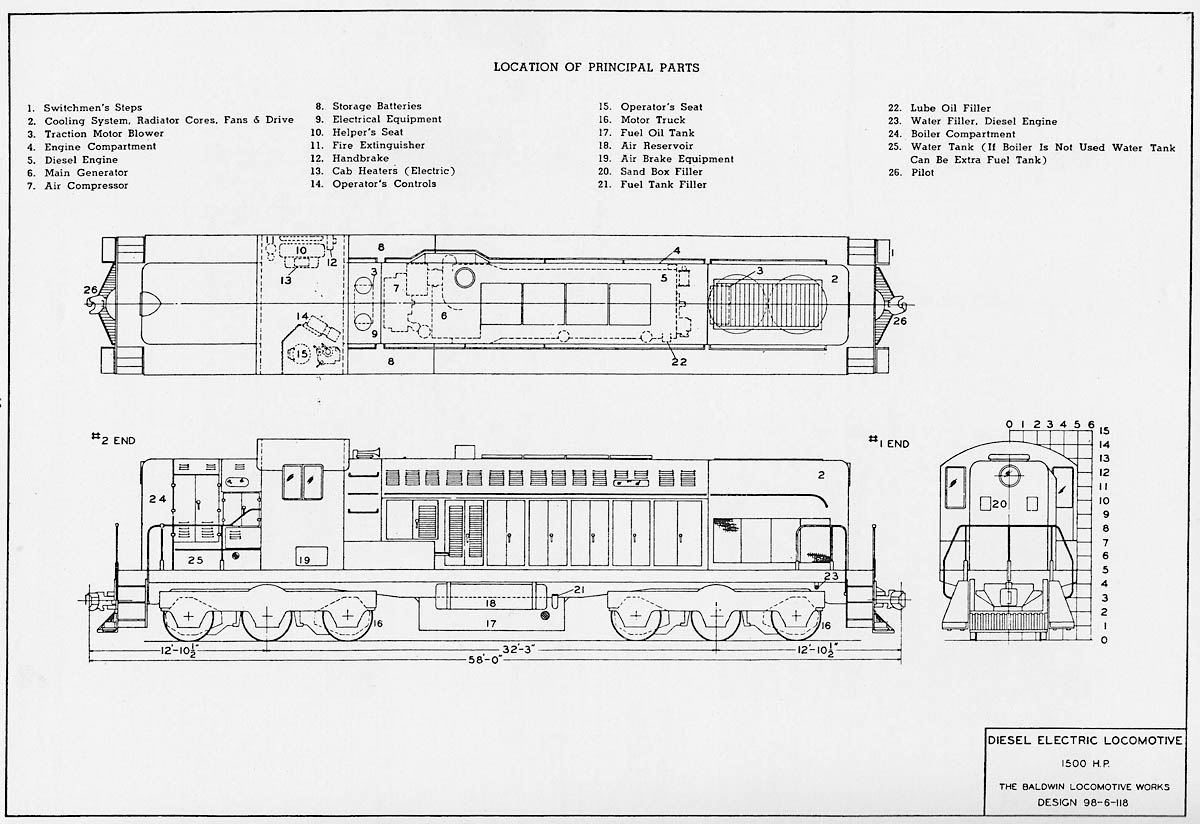
collection
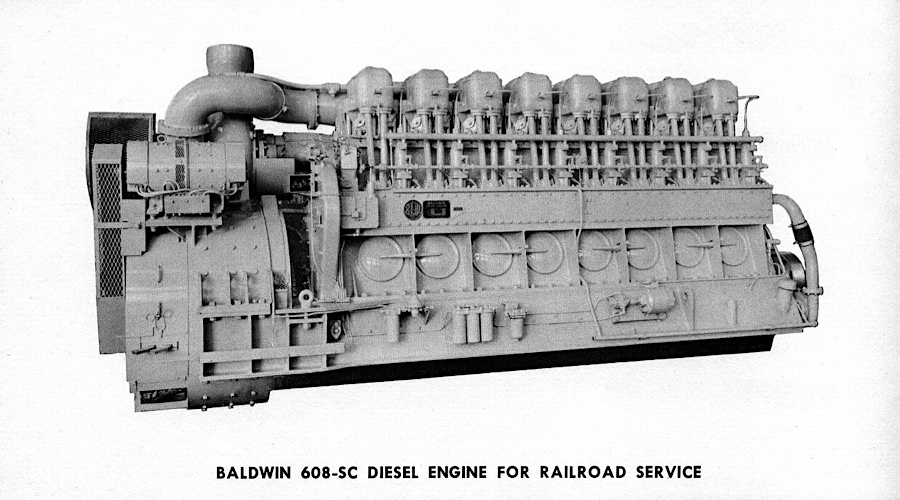
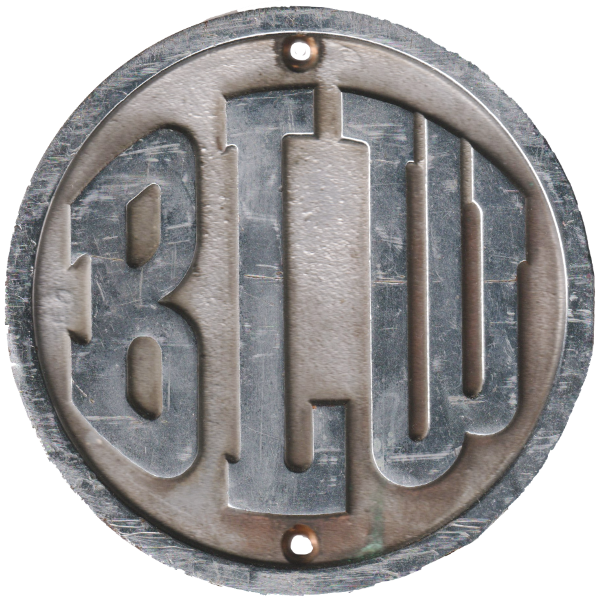
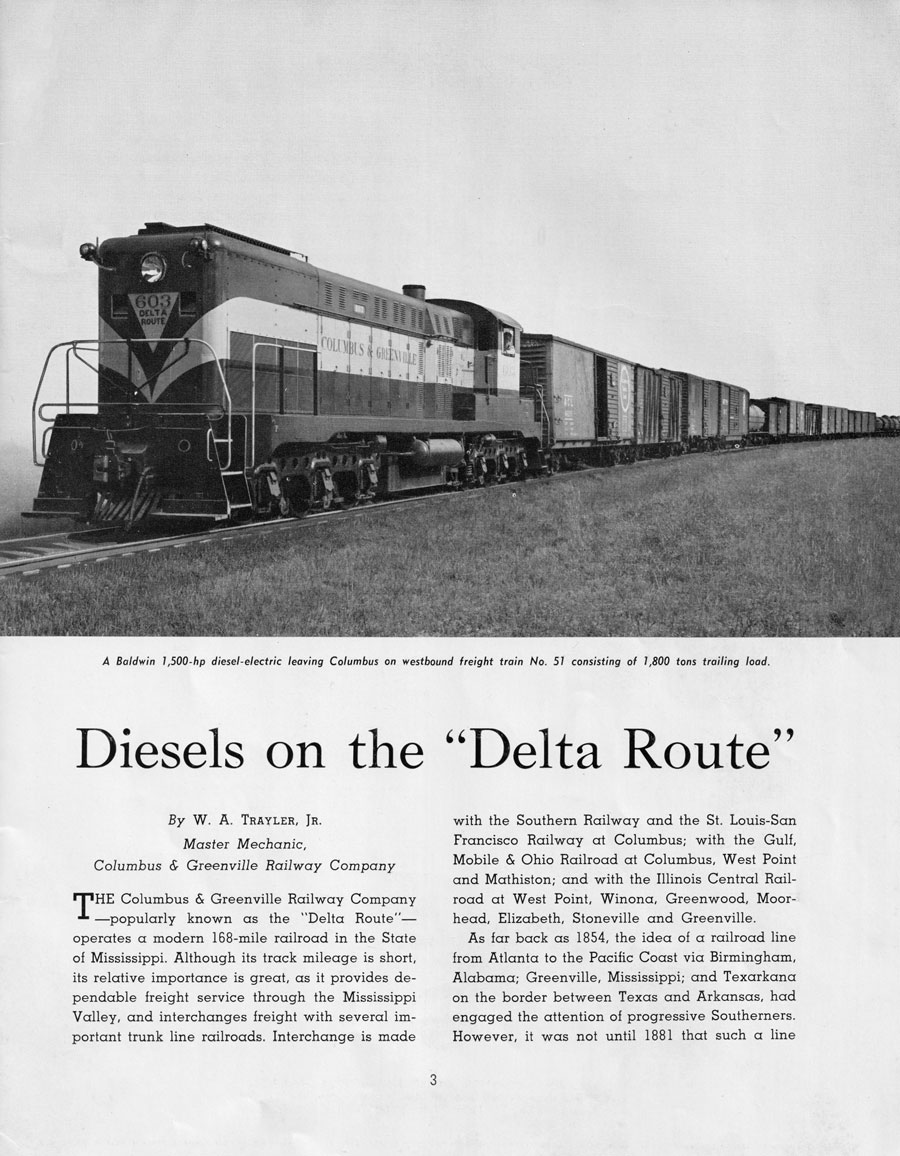
from Baldwin
magazine / collection
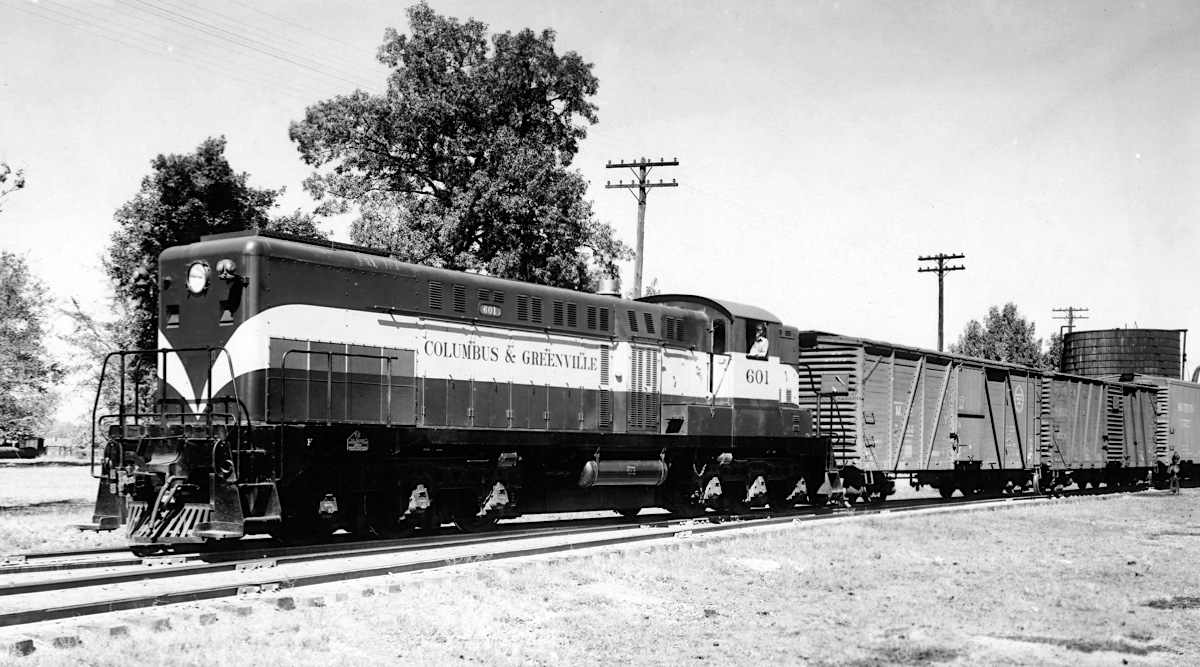
Baldwin publicity photo / collection
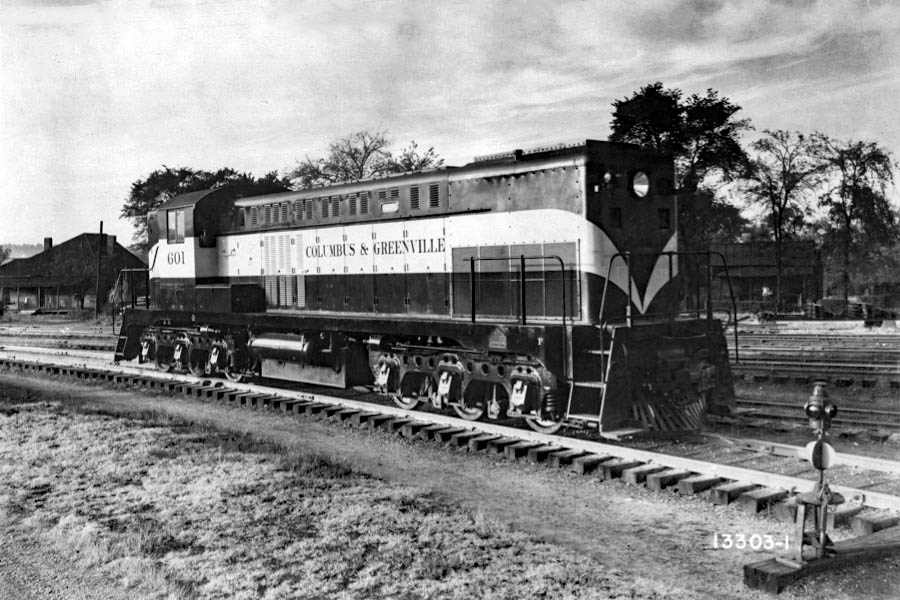
Baldwin builder's photo / collection
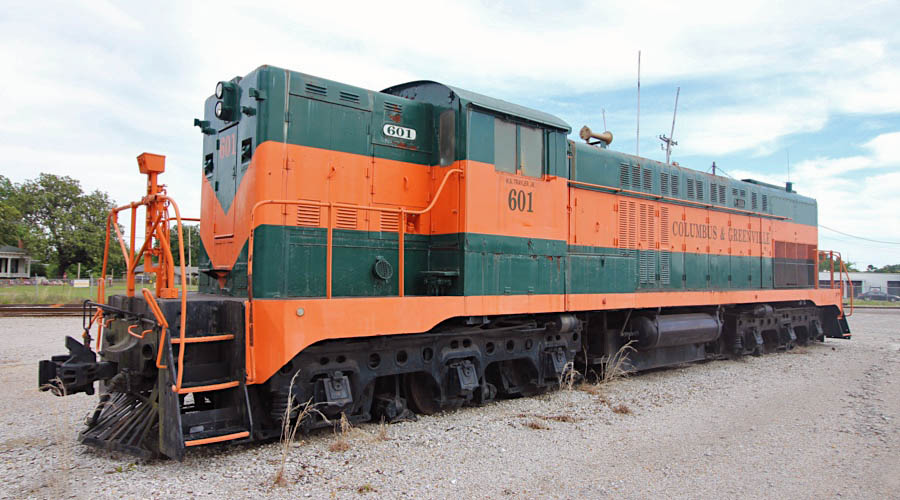
Columbus, Ms / Jun 2020 / RWH

1945 Official Guide header / collection
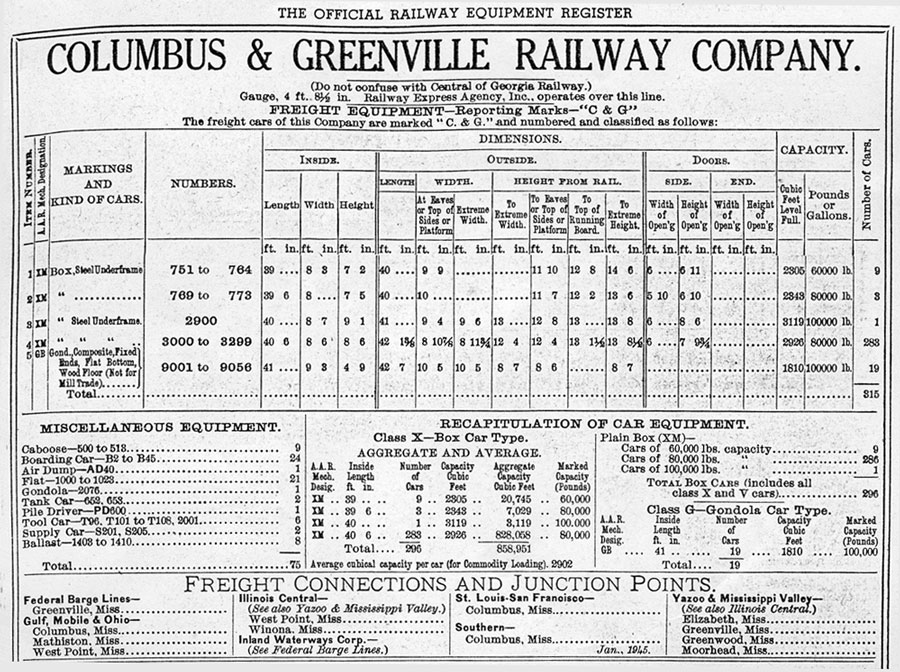
1945 Official Railway Equipment Register / collection
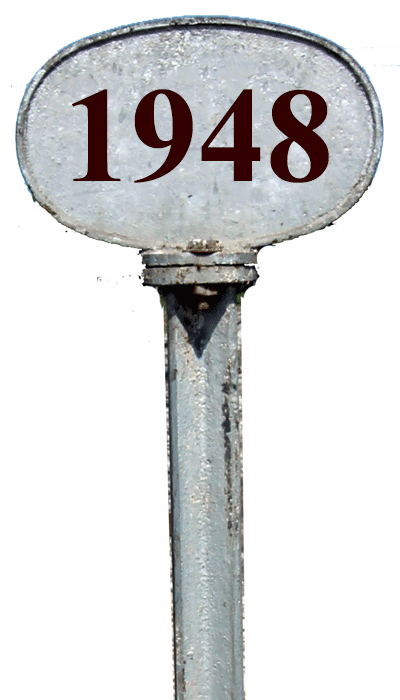 C&G ends passenger service
C&G ends passenger service
Feeling the effects of increased highway traffic, in 1947 the Columbus & Greenville eliminated its only named train, the daily "Deltan — trains #11 and #12 — between its namesake towns. Although mixed train service continued for several months, in 1948 the United States Post Office took its cross-state mail portage off the railroad and began to use trucks. The Delta Route scheduled its last passenger train on the day the Postal Service trucks went into operation.
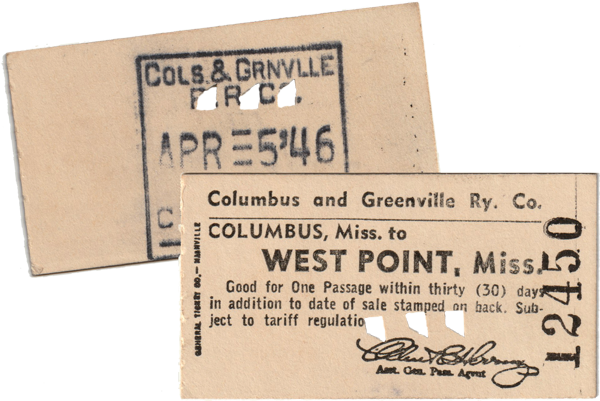
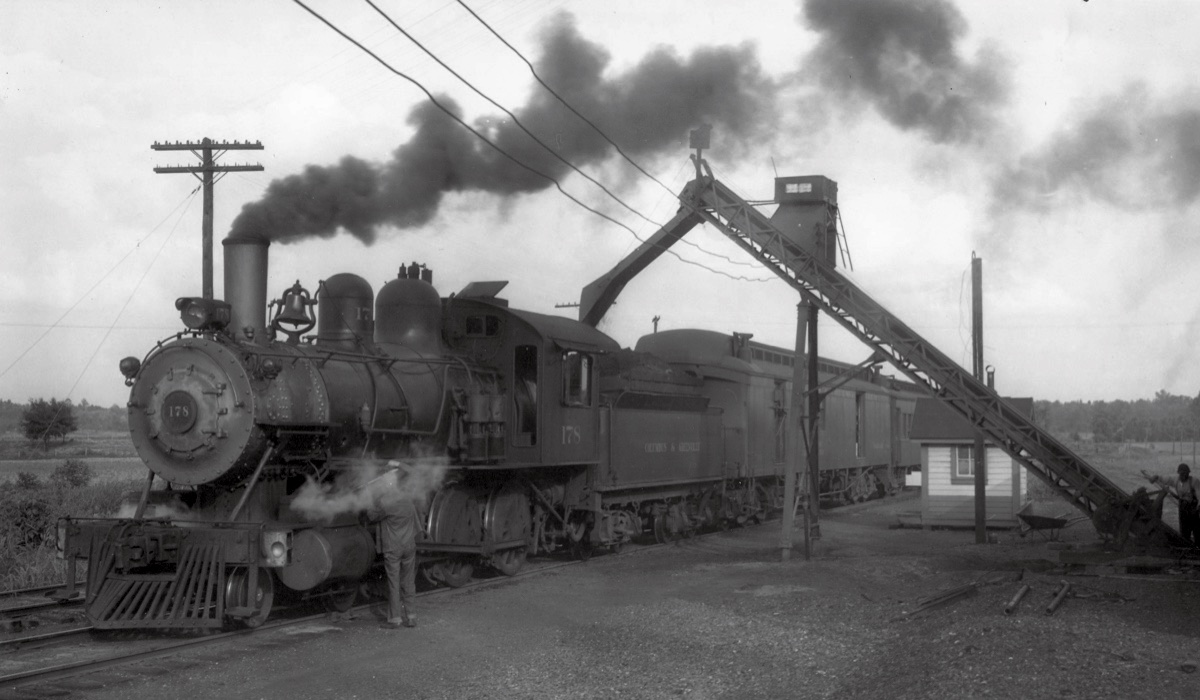
Winona, Ms / 1940 / collection

from Handbook of American Railroads
- 1950 edition / collection

Columbus, Ms / Sep 1969 / JCH
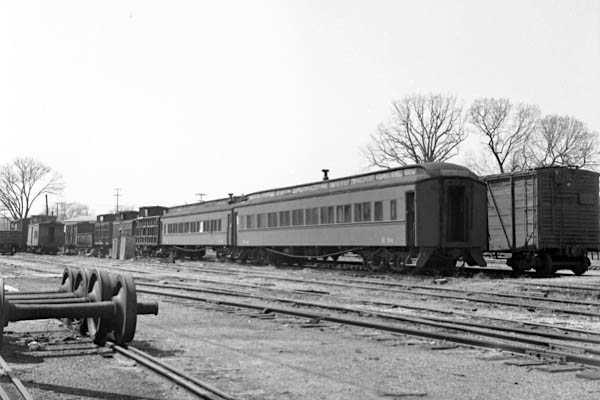
Columbus, Ms / Mar 1972 / JCH

Columbus, Ms / Mar 1973 / JCH

1951 brochure / collection
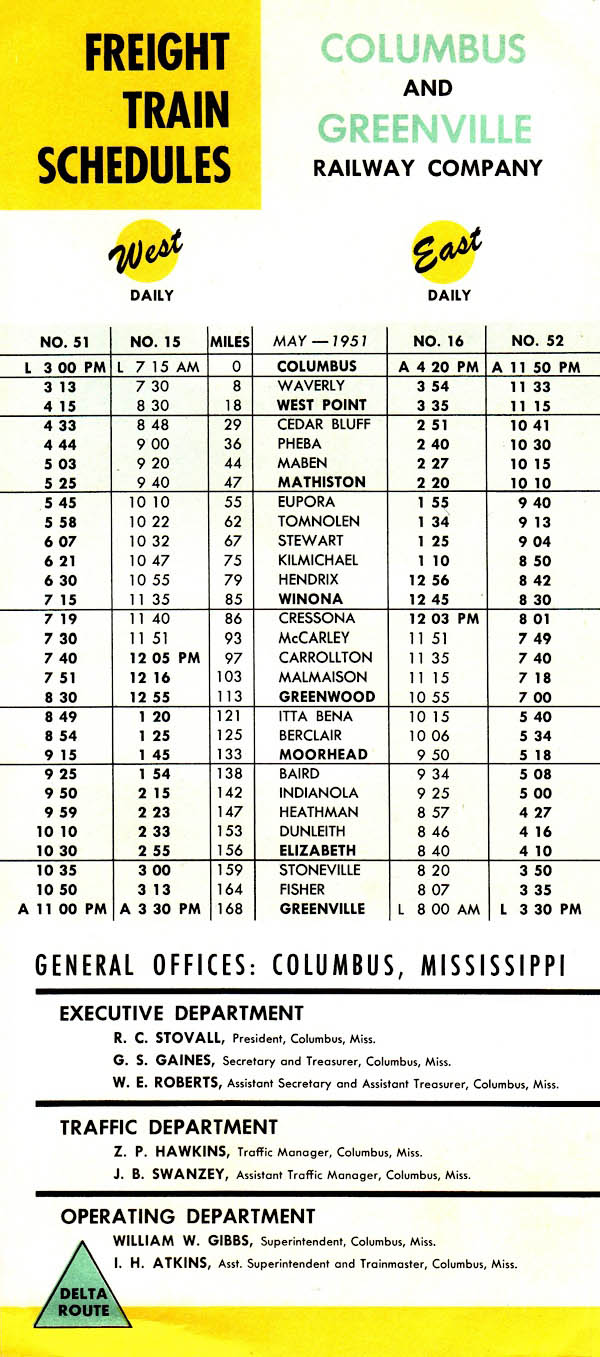
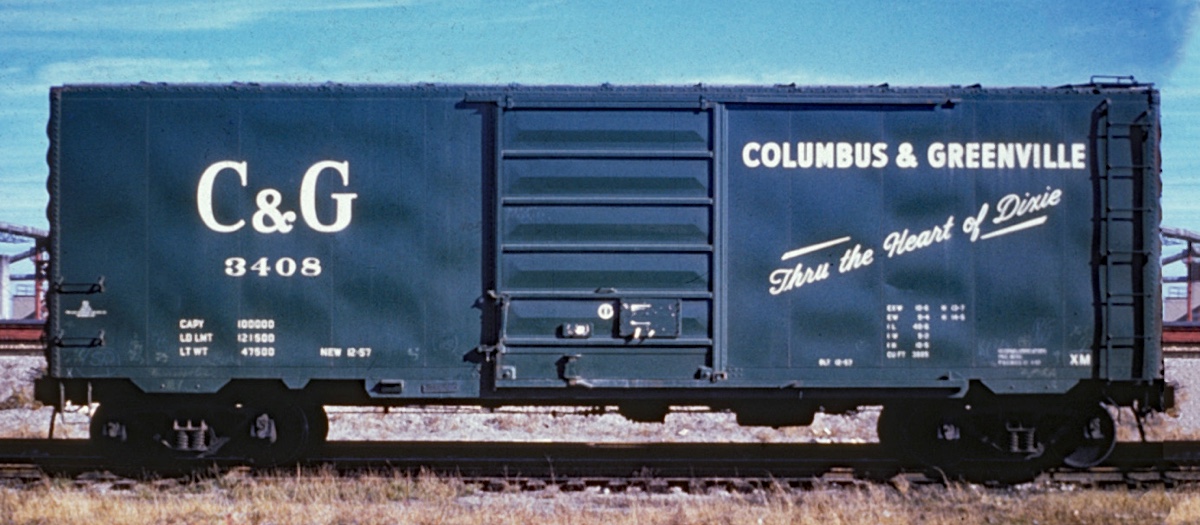
collection
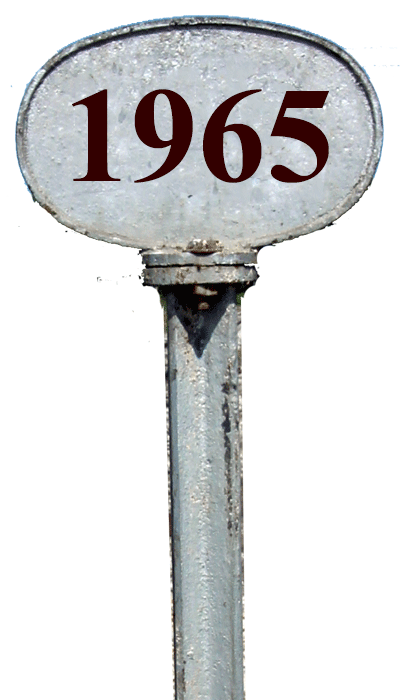 Electro-Motive Special Duty locomotives
Electro-Motive Special Duty locomotives
 In the fall of 1965, the Columbus & Greenville took delivery of two road switchers from General Motor's Electro-Motive Division. These SD28 models turned out to be 2 of only 6 ever produced, and would be the last new power the shortline would ever purchase. They were ordered with adaptations to suit the Delta Route's light trackage and provided immediate relief to the aging Baldwins. Unlike the Baldwins, however, their time in the Mississippi Delta would be comparatively brief: the coming Illinois Central Gulf absorption would take them elsewhere in less than a decade.
In the fall of 1965, the Columbus & Greenville took delivery of two road switchers from General Motor's Electro-Motive Division. These SD28 models turned out to be 2 of only 6 ever produced, and would be the last new power the shortline would ever purchase. They were ordered with adaptations to suit the Delta Route's light trackage and provided immediate relief to the aging Baldwins. Unlike the Baldwins, however, their time in the Mississippi Delta would be comparatively brief: the coming Illinois Central Gulf absorption would take them elsewhere in less than a decade.
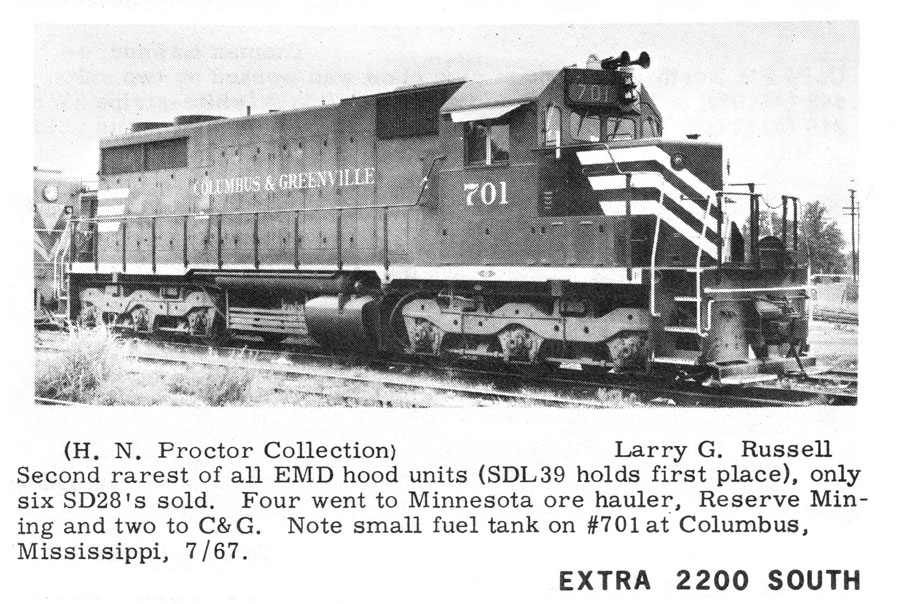
collection
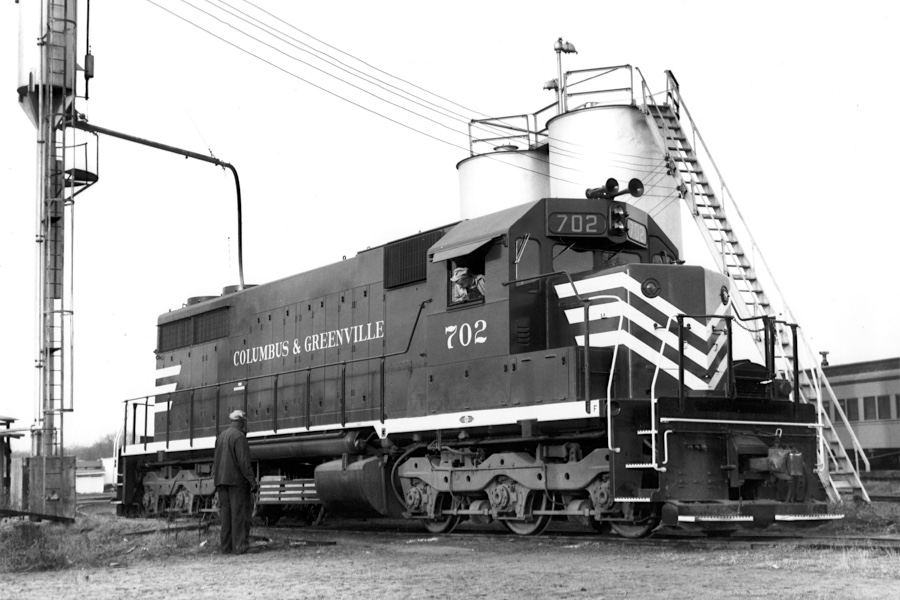
Columbus, Ms / Nov 1965 / collection
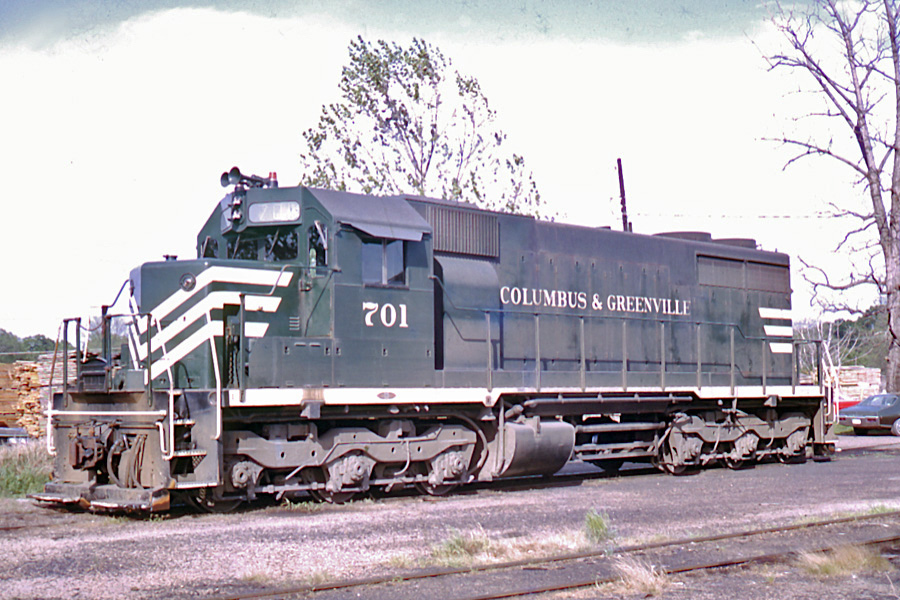
collection

collection
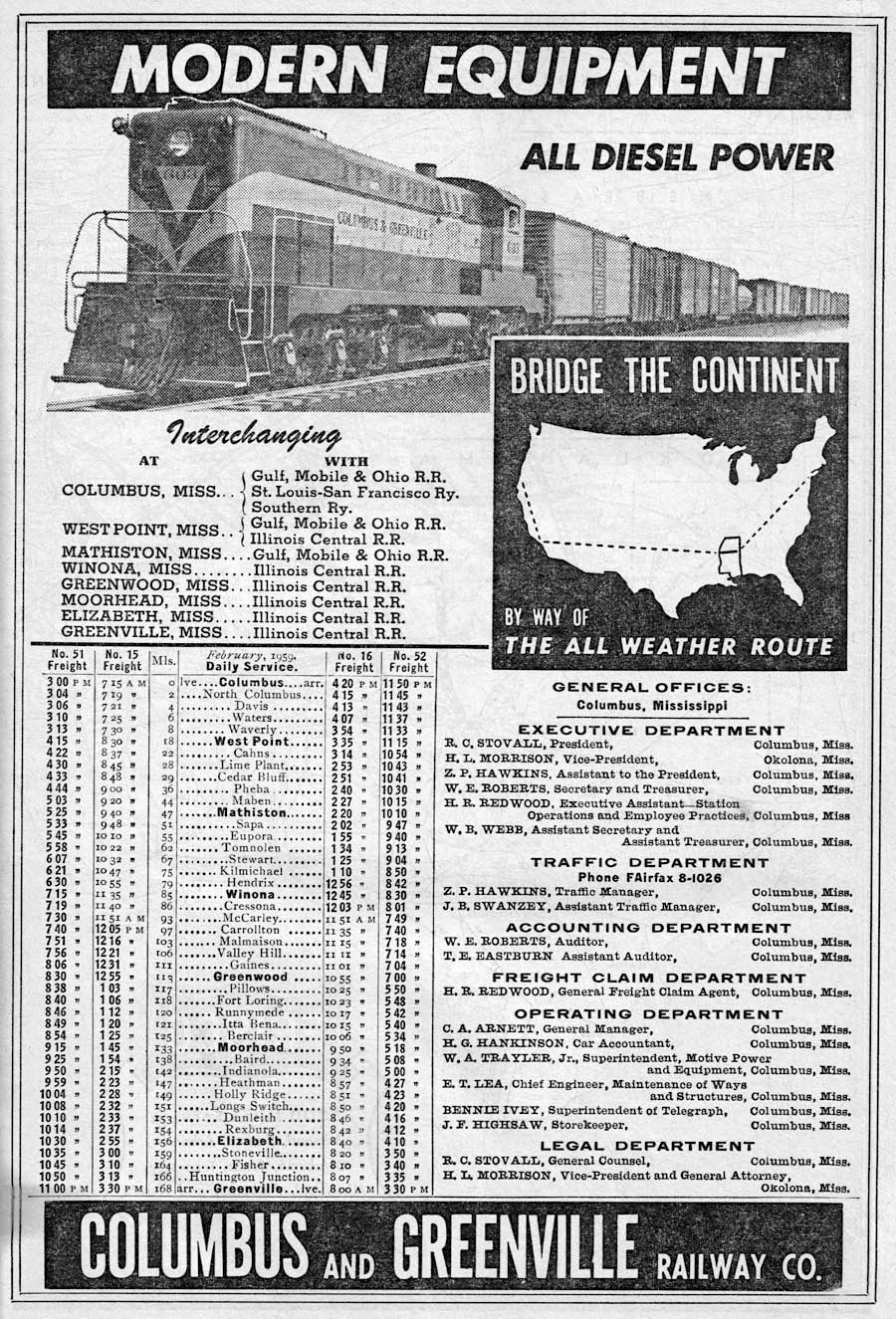
1965 Official Guide ad / collection
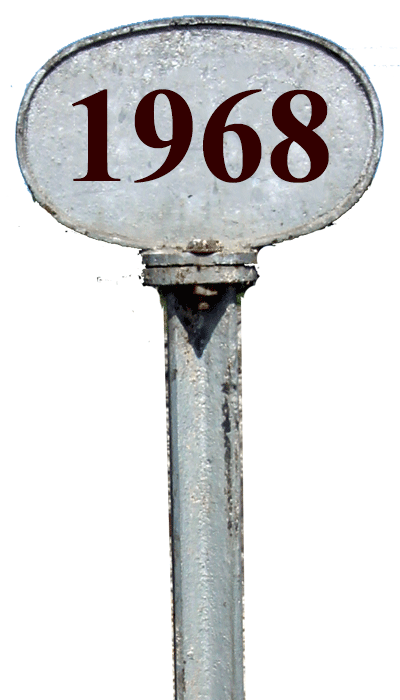 Illinois Central and Gulf Mobile & Ohio merger
Illinois Central and Gulf Mobile & Ohio merger
In May of 1968, parallel mainline railroads Illinois Central and Gulf, Mobile & Ohio announced their intention to merge. These two roads were the major north-south players in the Columbus & Greenville's east-west territory, making their proposed marriage a major threat to the Delta Route's standing as a connecting route. In addition to serving its many online customers, the C&G historically generated revenue by bidding for bridge traffic between the mainline carriers in the region. Given that the majority of the shortline's interchange points at the time were with either the IC or the GM&O, the proposed merger had devastating implications for the Delta Route's prospects in the 1970s. As such, the shortline petitioned the ICC to be a part of the proposed corporate marriage.

1973 Official Guide ad / collection
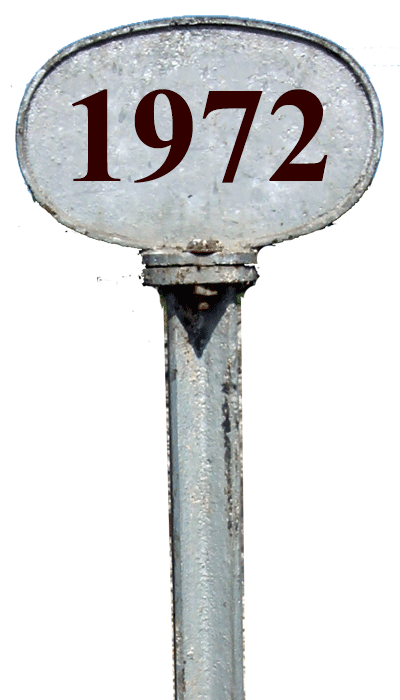 Columbus & Greenville sold to Illinois Central Gulf
Columbus & Greenville sold to Illinois Central Gulf
The Illinois Central Gulf Railroad became a corporate reality on August 10, 1972. On the 31st of that month the new company announced that the Fernwood, Columbia & Gulf and the Bonhomie & Hattiesburg Southern had been added to the system. According to its agreement worked out 1in 1969, the sale of the Columbus & Greenville Railway to the new ICG system became final on September 29th.

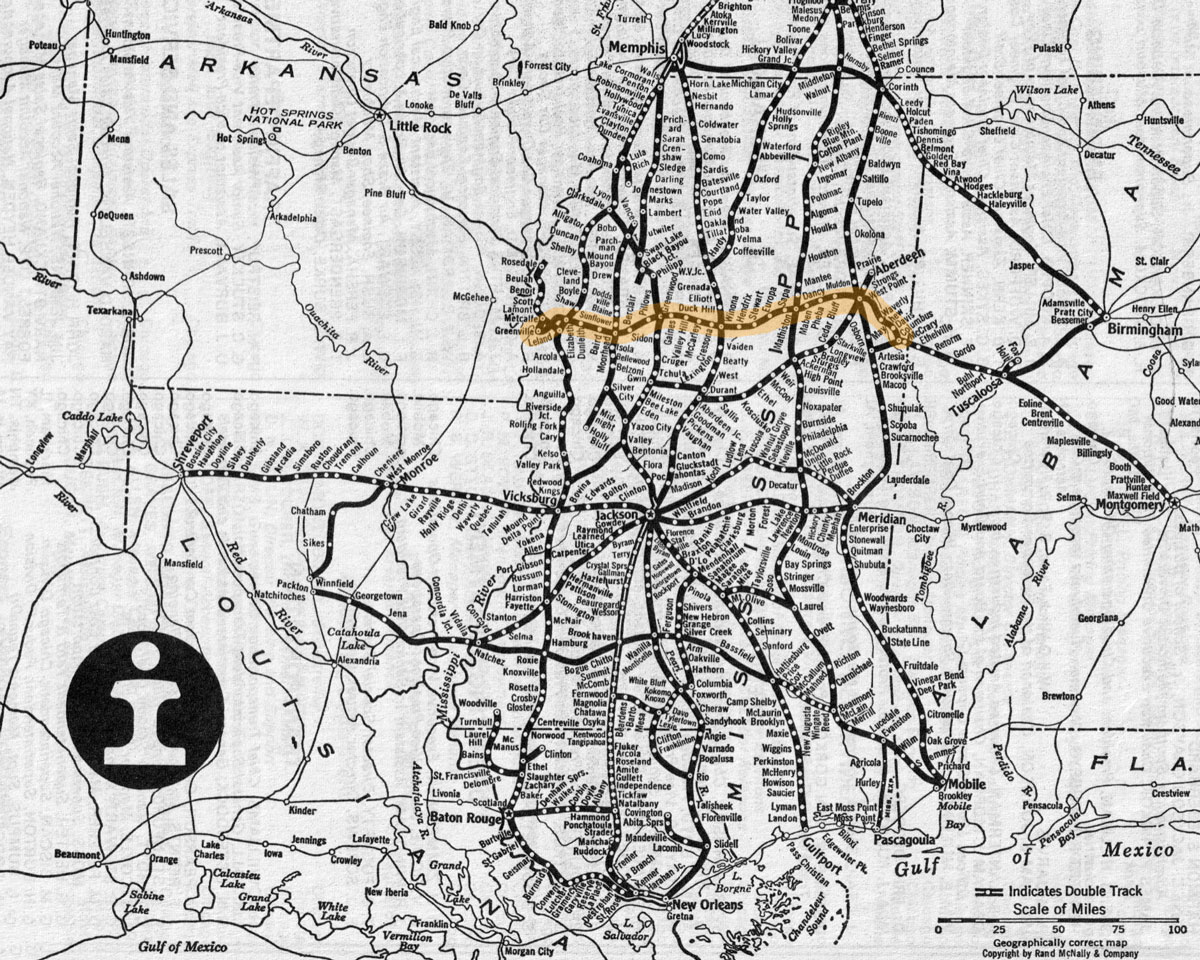
1974 Official Guide map showing C&G mainline / collection
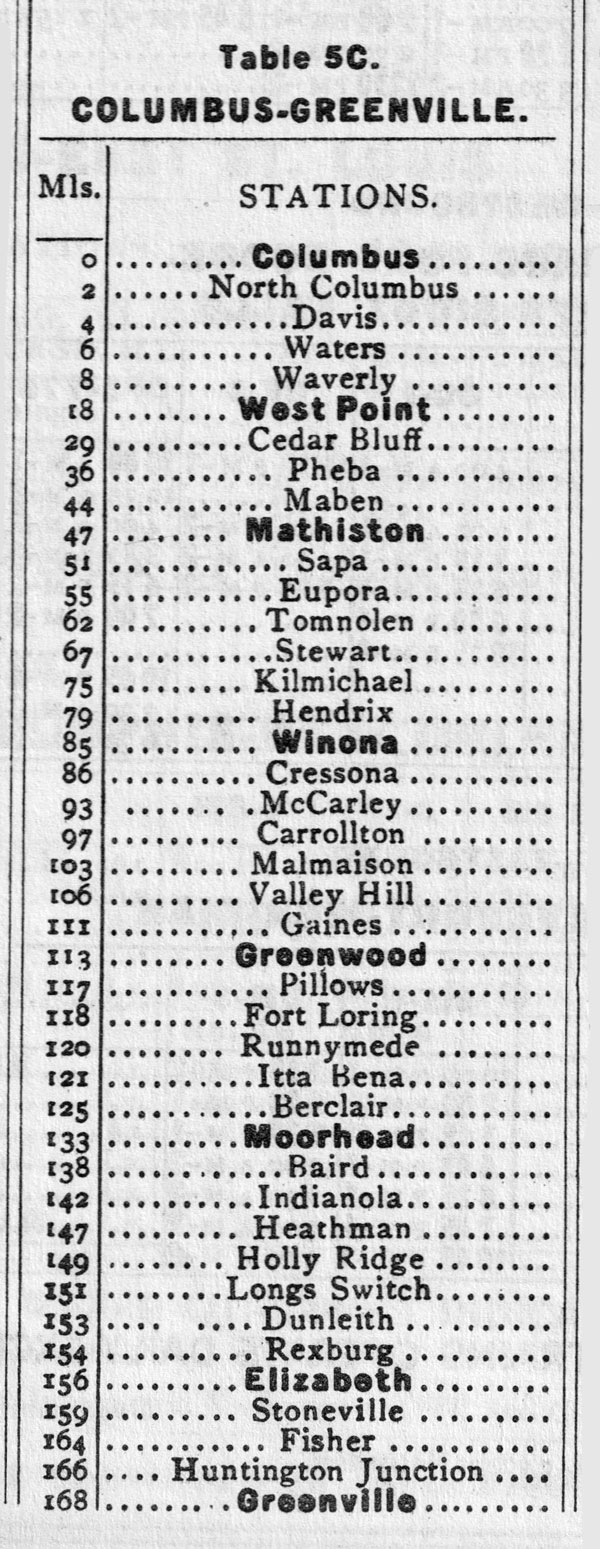
1974 ICG route table / collection
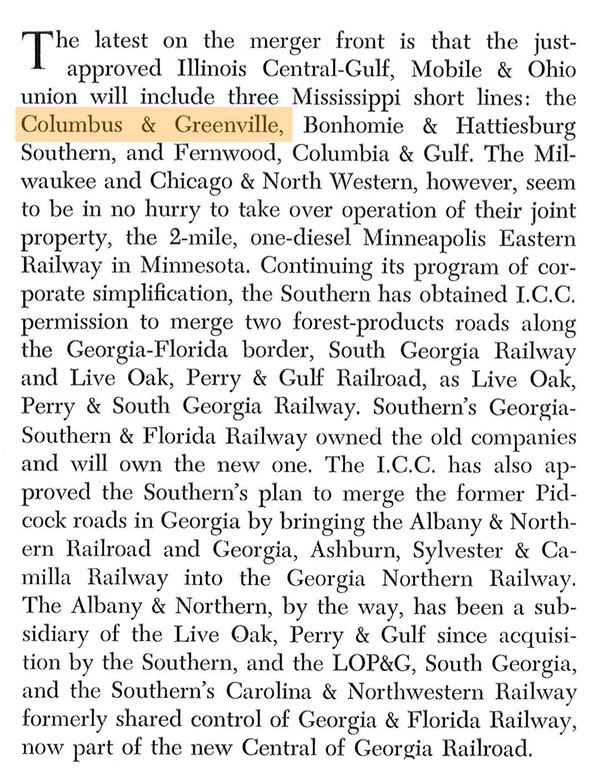
from Railroading
#41 - Dec 1971 / collection
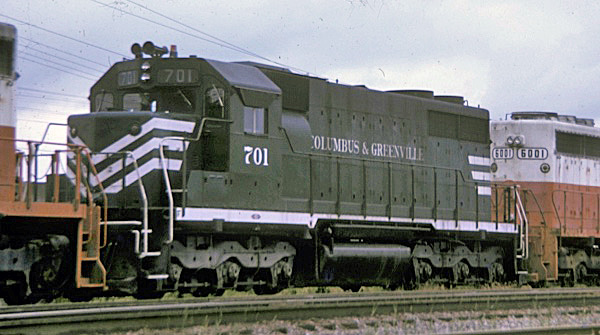
SD28 #701 in ICG service / collection
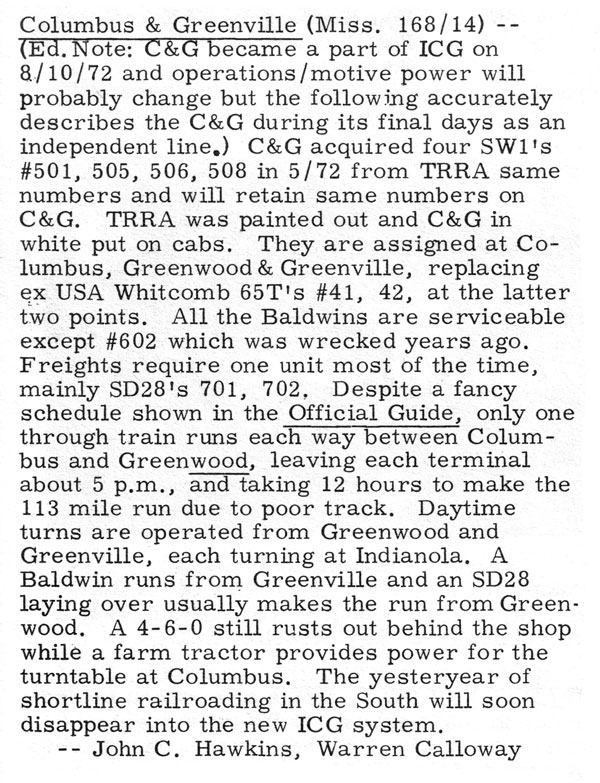
from Extra 2200 South
- Jul 1972 / collection
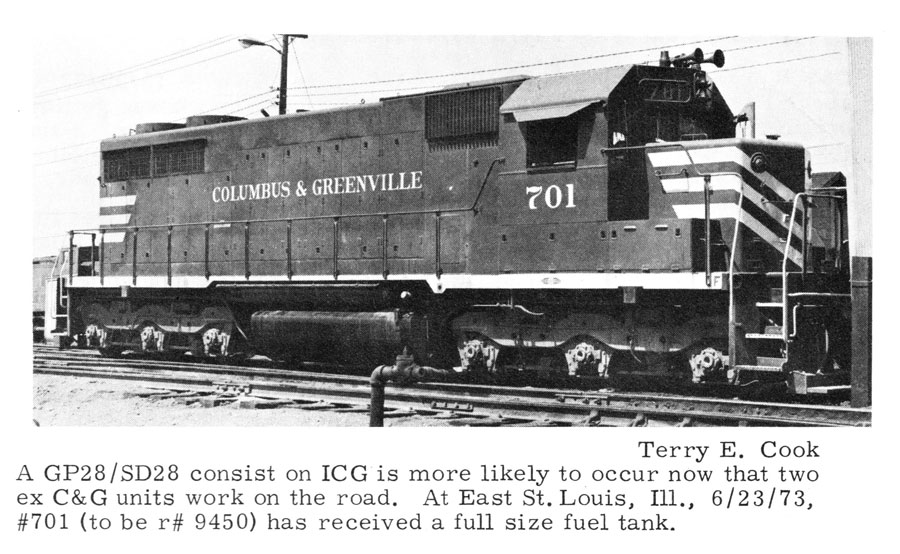
from Extra 2200 South
- May 1973 / collection
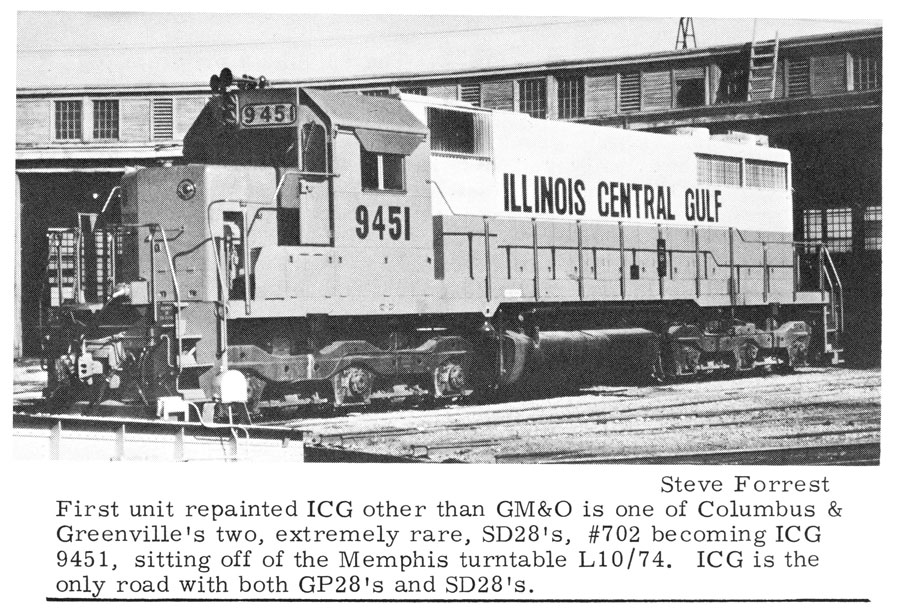
from Extra 2200 South
- Sep 1974 / collection
 new Columbus & Greenville charted
new Columbus & Greenville charted
The former Columbus & Greenville remained a part of the Illinois Central Gulf for only 37 months. Deteriorating right of way — and as a result deteriorating freight service — coupled with rumors that the ICG planned to abandon the route as a through line prompted at least two regional development groups to organize to insist that the ICG maintain adequate service to former C&G customers. As a result, the Mississippi Public Service Commission ordered the ICG to take steps necessary to reinstate all of the trains that were running at the time of the purchase. This prompted to ICG to offer the line at sale to local interests. A new corporation was chartered in August 1974 for that purpose.
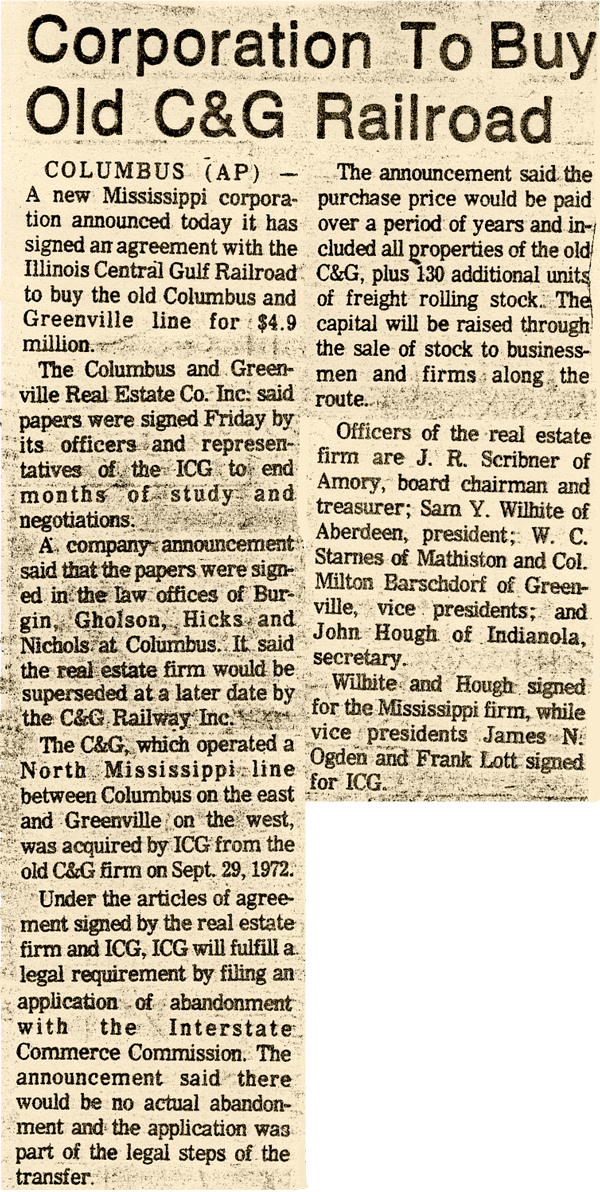
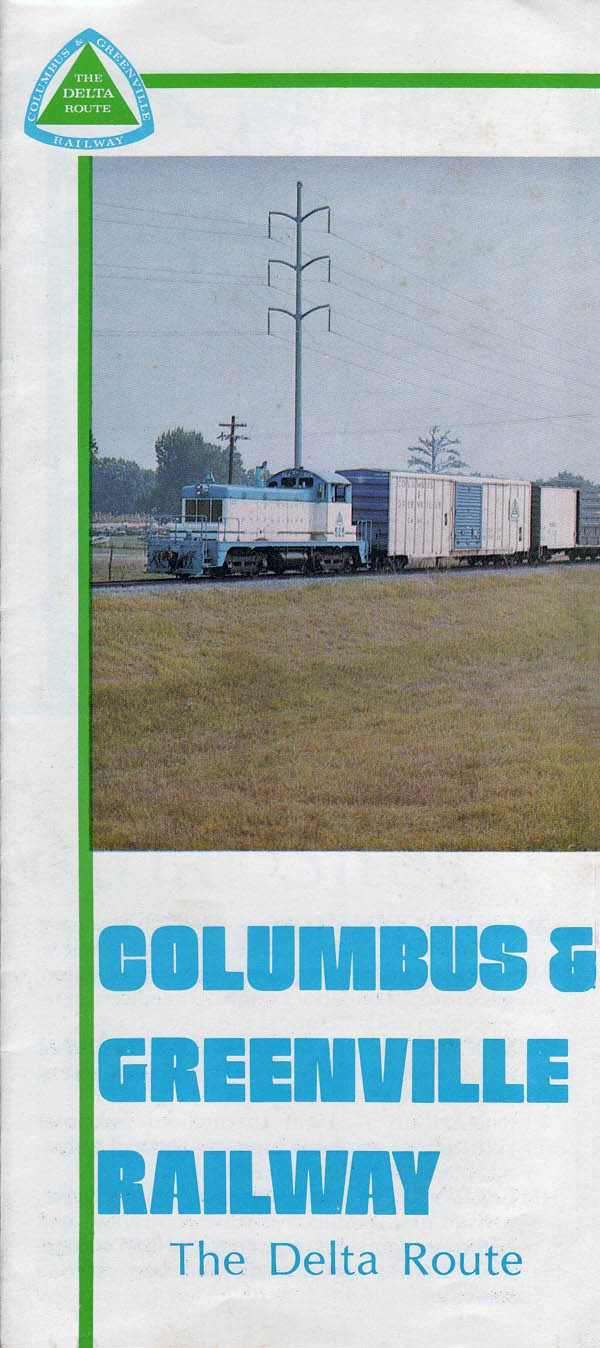
advertising brochure / collection
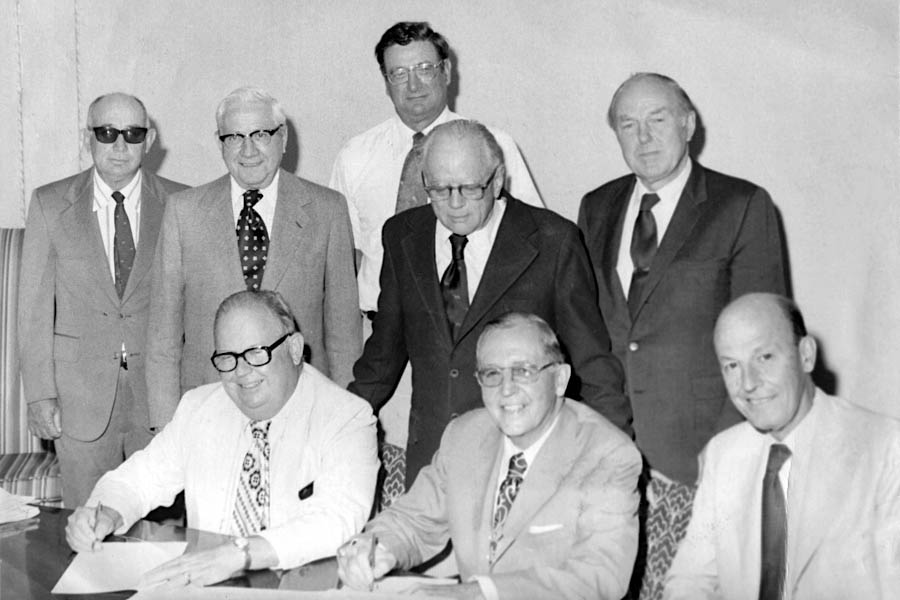
corporate signers / Aug 1974 / collection
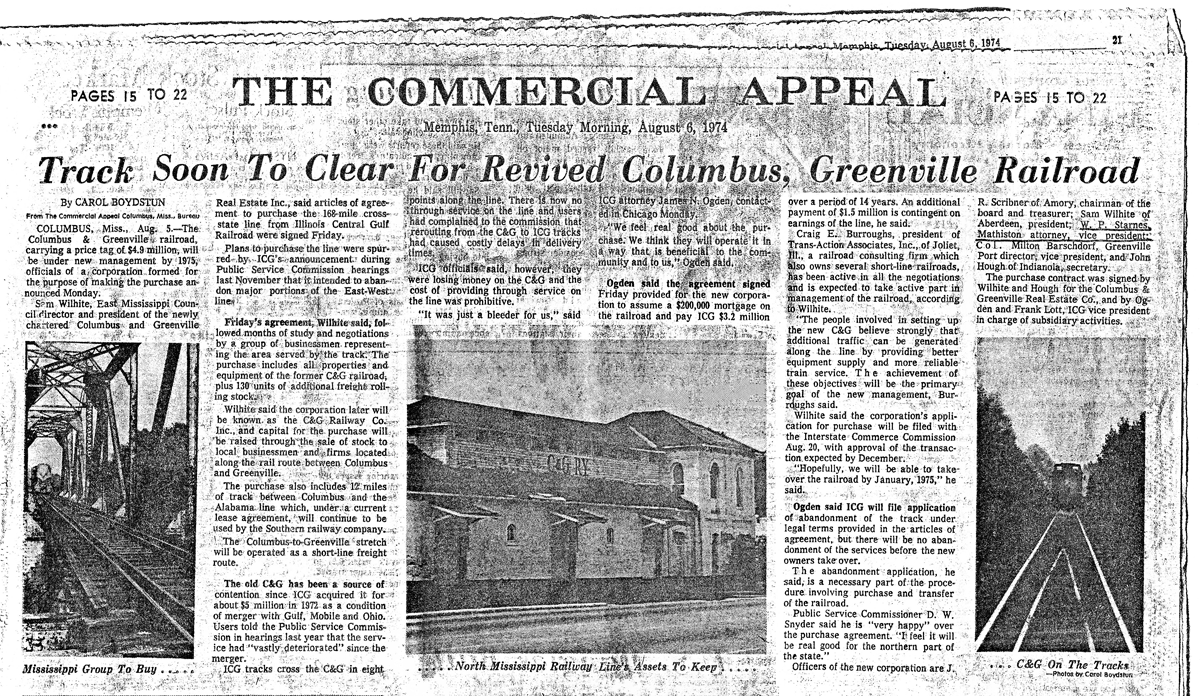
from Memphis Commercial Appeal - Aug 1974 / collection
 Columbus & Greenville purchased from Illinois Central Gulf
Columbus & Greenville purchased from Illinois Central Gulf
The new, locally-owned Columbus & Greenville began operations on October 30, 1975; the second time in the railroad's long history when it was in the care of local interests. The condition of the property was deplorable after three years of corporate neglect; the line between Heathman and Greenville had been out of service for more than two years. Nevertheless, under the leadership of president Craig Burroughs and chairman Sam Y. Wilhite, the new shortline made steady progress on stabilization and development of new traffic.
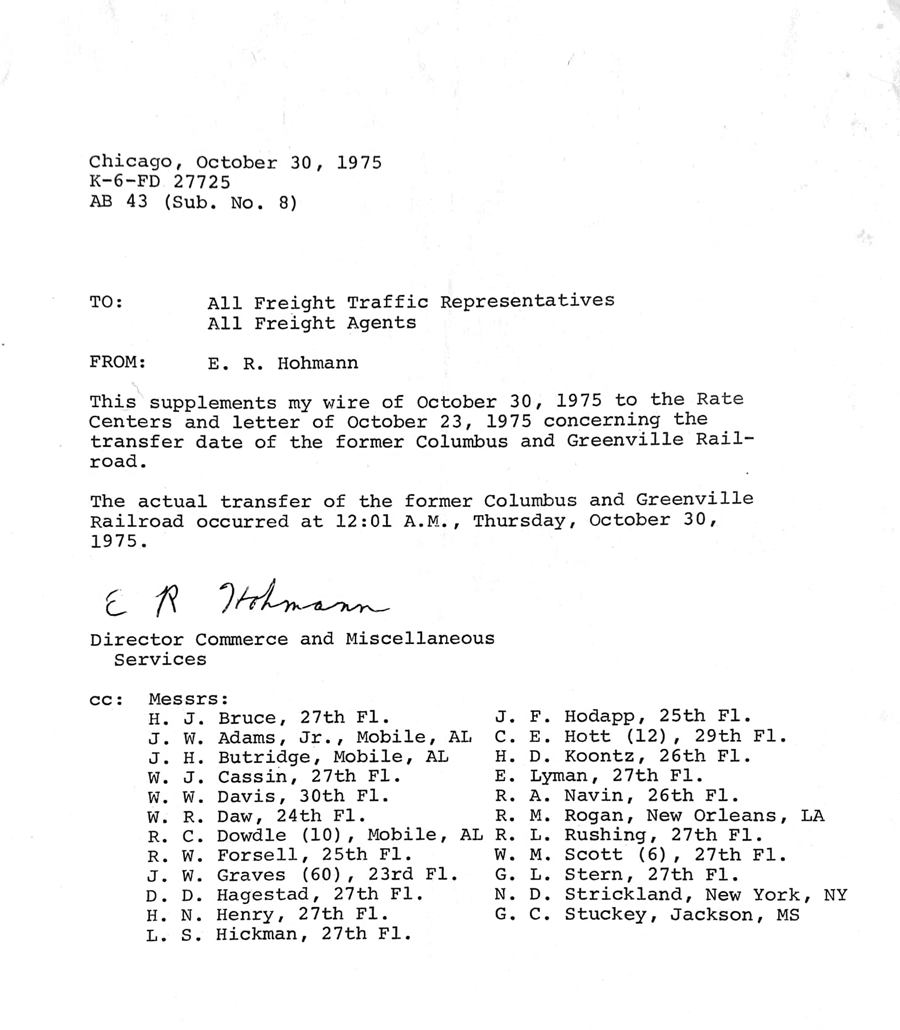
ICG memo regarding CAGY transfer - Oct 1975 / Joe Marascalco collection
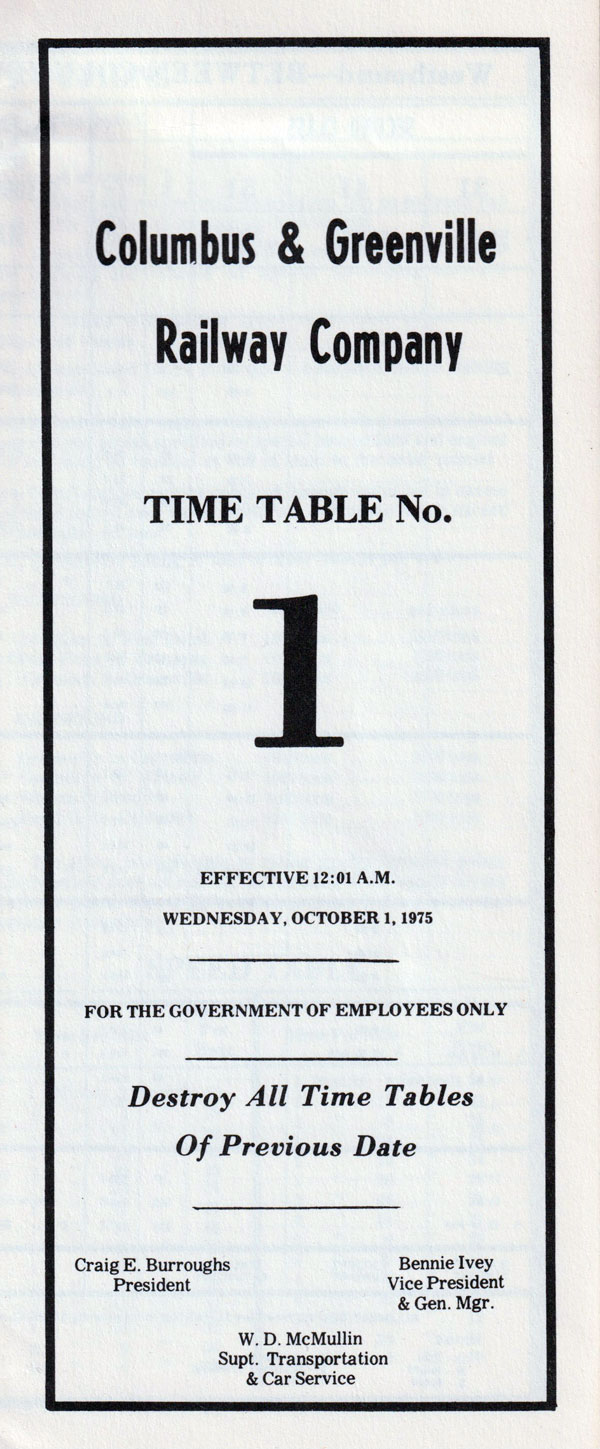
1975 employee timetable / collection

Columbus, Ms / 1977 / collection

Greenwood, Ms / Dec 1982 / collection
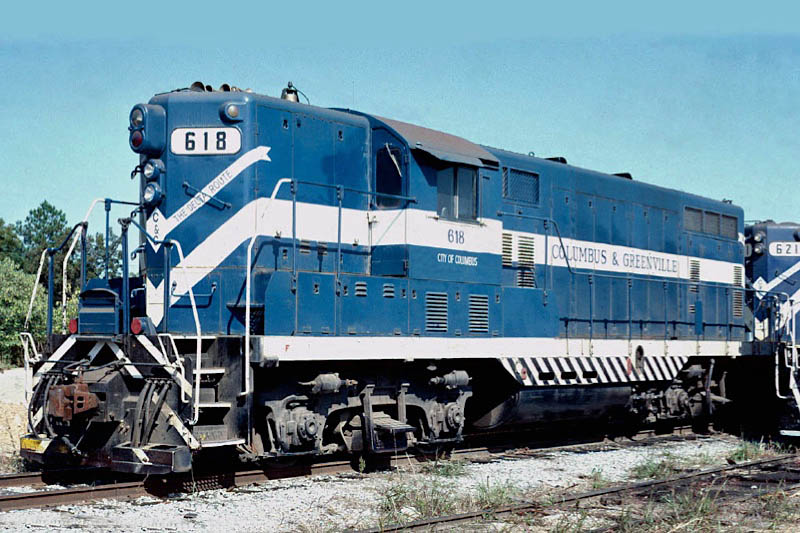
Greenwood, Ms / Oct 1982 / Bernie Feltman
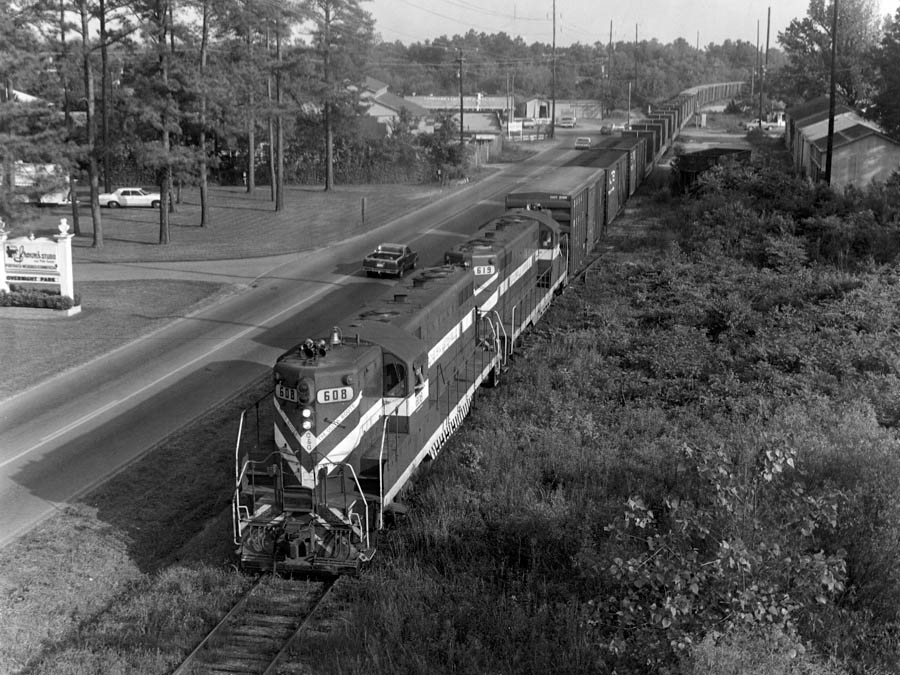
Columbus, Ms / Louis Saillard
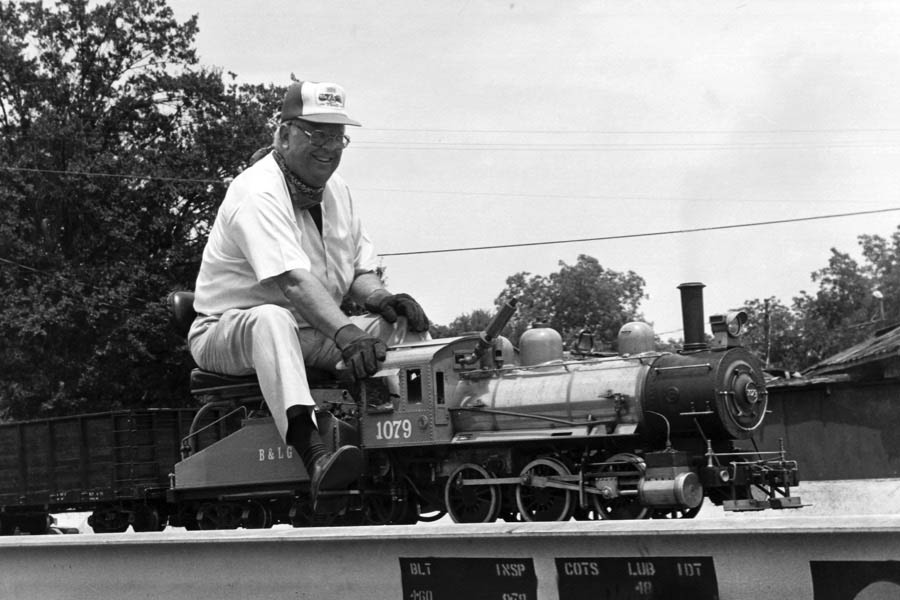
Sam Y. Wilhite - Columbus & Greenville president / Louis Saillard / collection

See also our complete Sam Y. Wilhite Transportation Museum scrapbook in Preservation
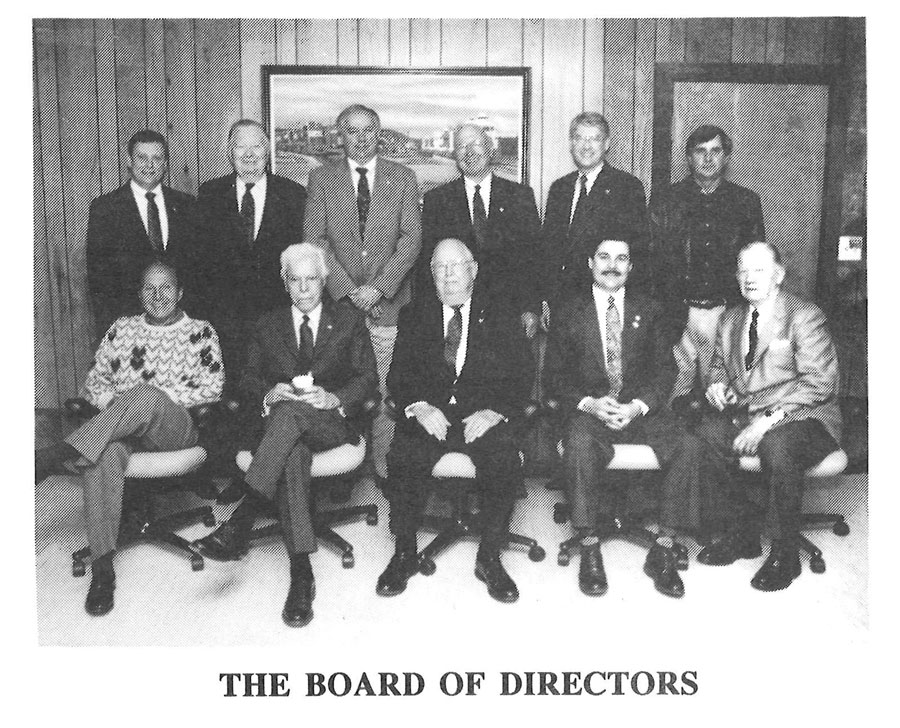
collection
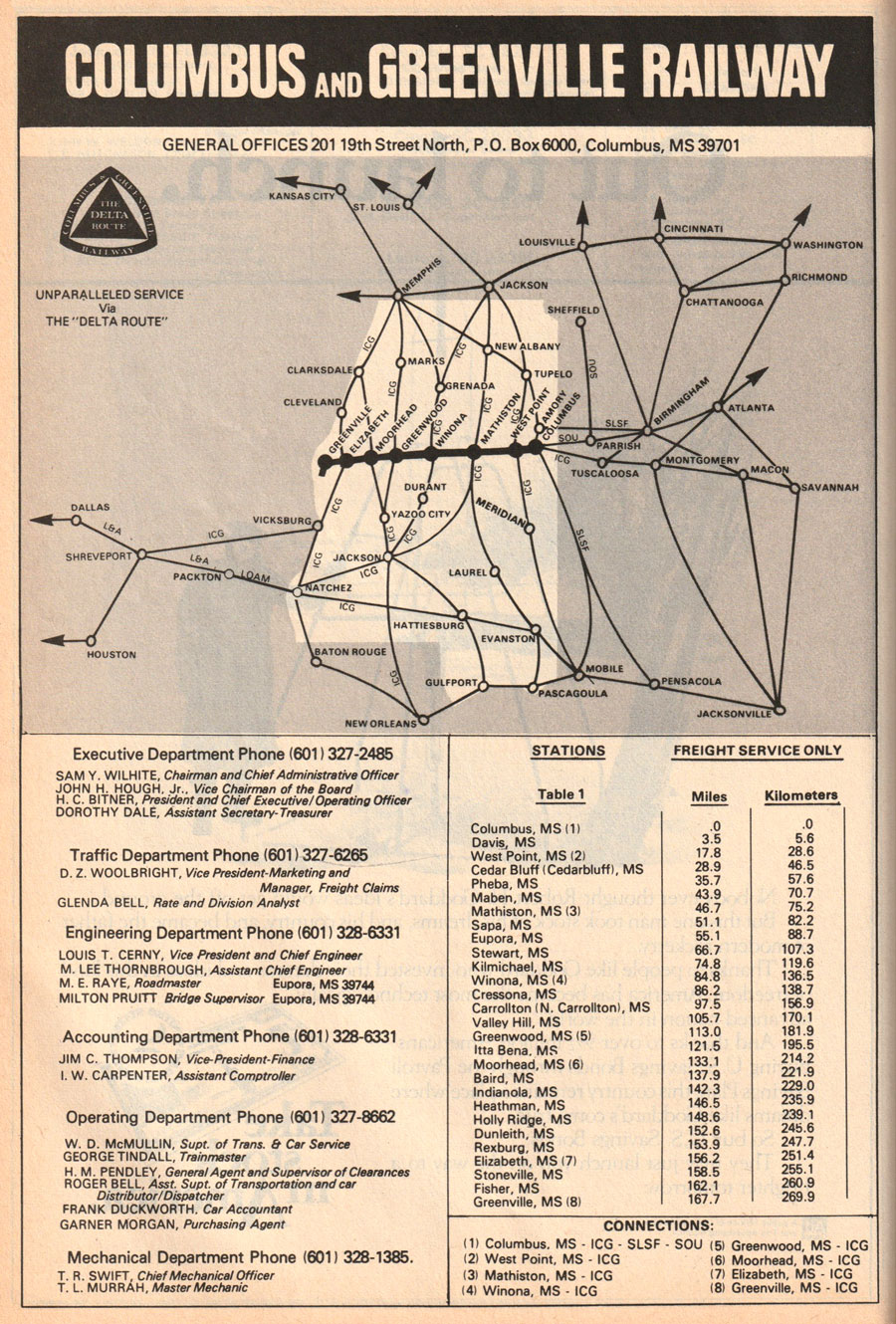
1978 Official Guide ad / collection

collection
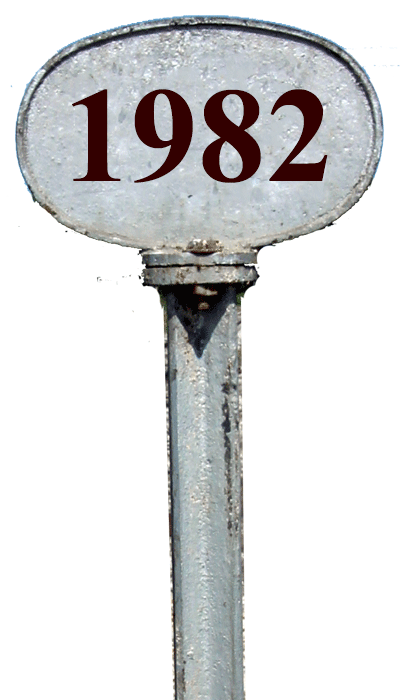 Columbus & Greenville celebrates centennial
Columbus & Greenville celebrates centennial
Throughout 1982, the Columbus & Greenville celebrated its centennial as a railroad line with a series of events in Columbus and Greenwood.

Greenwood, Ms / Feb 1982 / collection
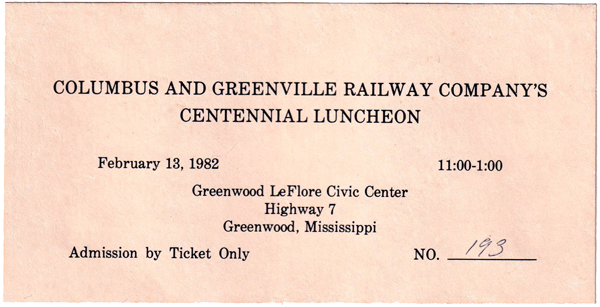
collection
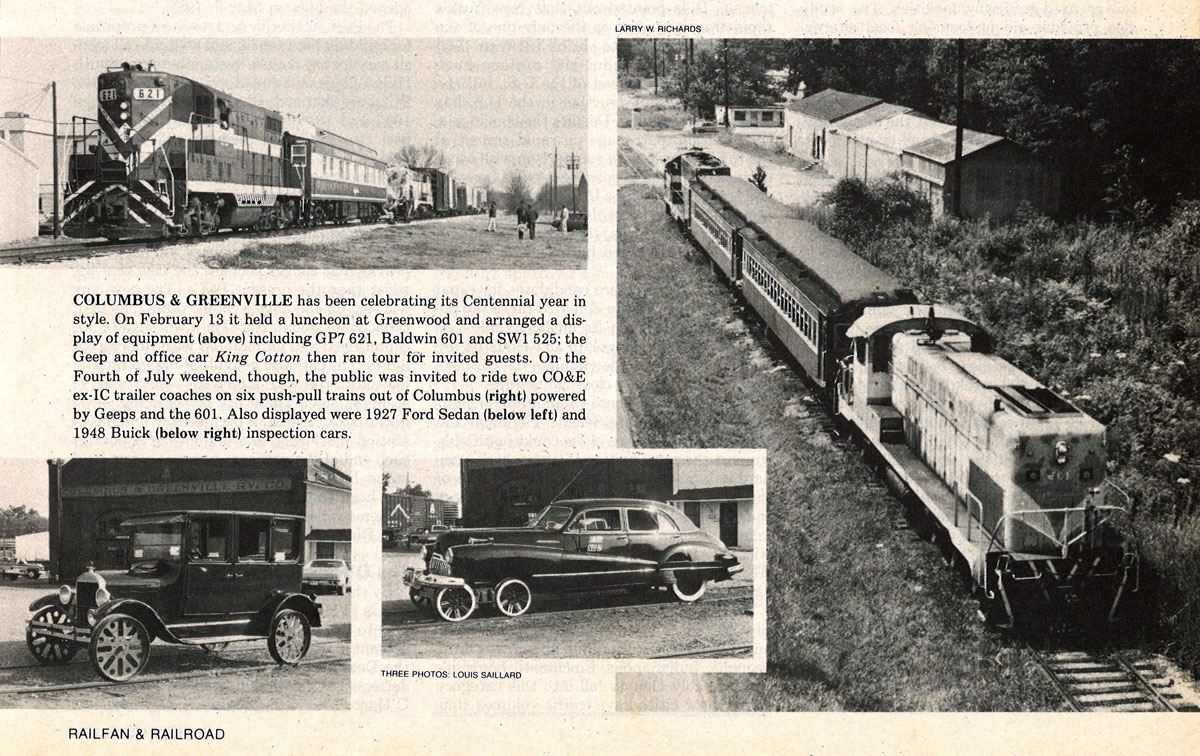
collection
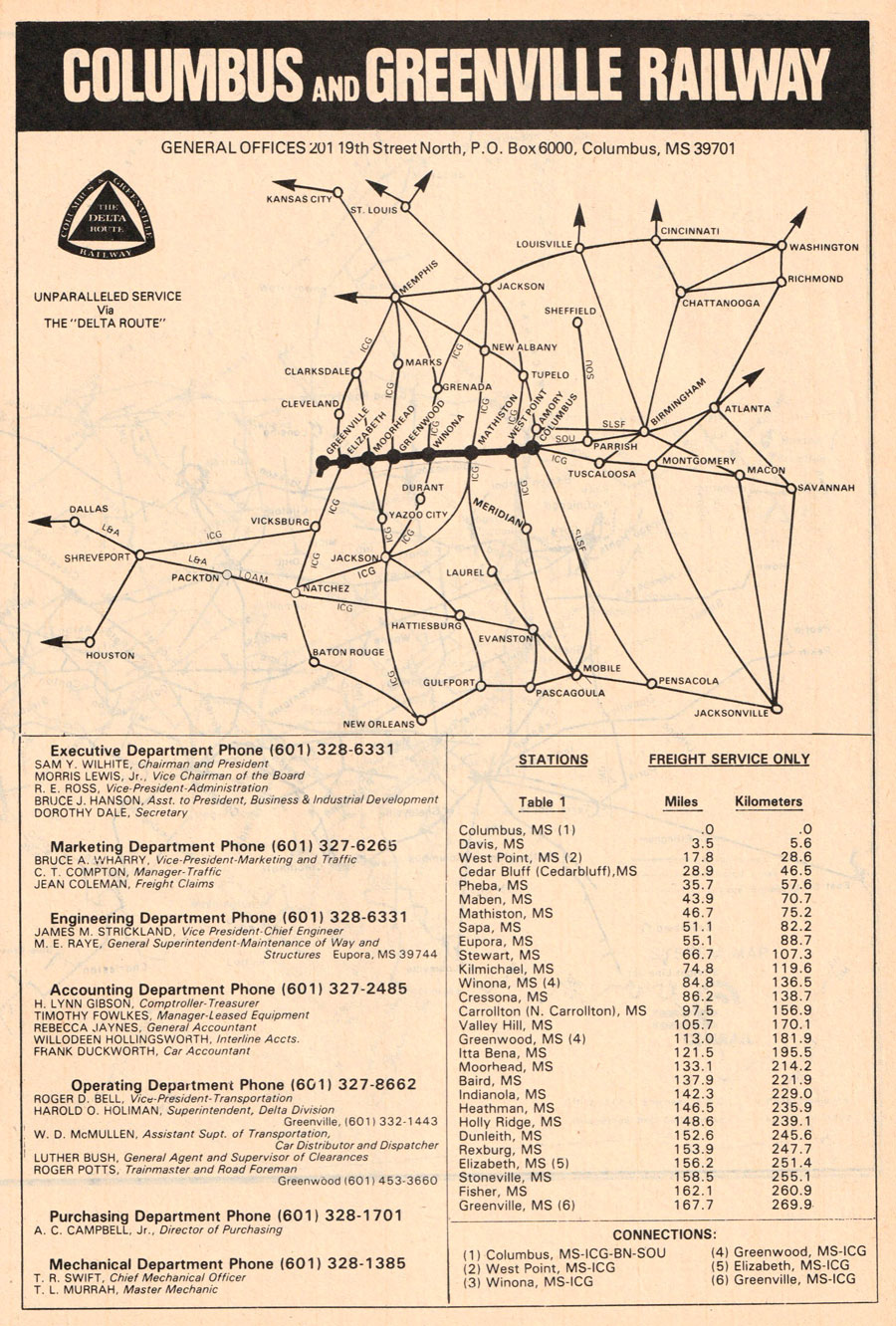
1982 Official Guide ad / collection
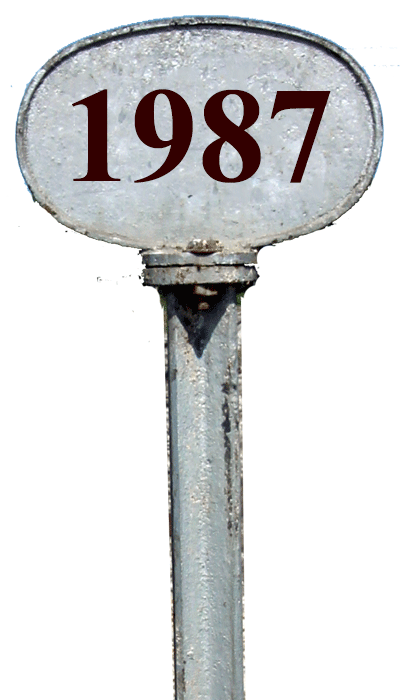 CAGY Industries
CAGY Industries
In an effort to diversify its revenue base, in 1987 a new shortline holding company was formed called CAGY Transportation Industries. The Columbus & Greenville itself became a subsidiary of the new corporation, as well as two new shortlines developed through leases from the Norfolk Southern: the Luxapalila Valley Railroad, based in Columbus and operating the westernmost remaining portion of the Southern's mainline to Birmingham; and the Chattooga & Chickamauga, operating former Tennessee Alabama & Georgia and Central of Georgia segments turned branchlines, both out of Chattanooga.
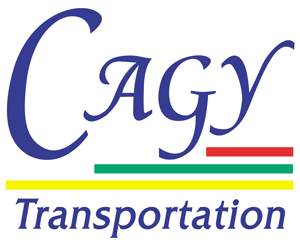

CAGY Industries shortline map / 1990 / web
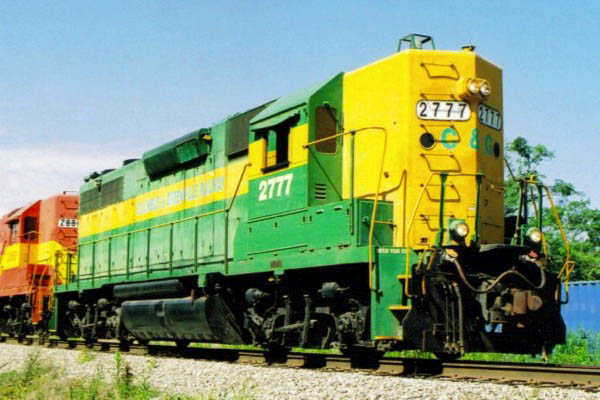
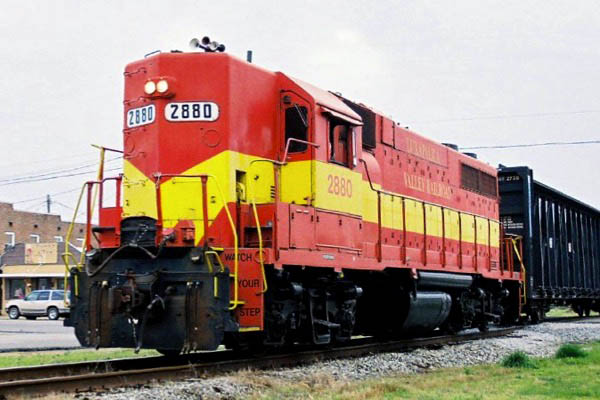

collection
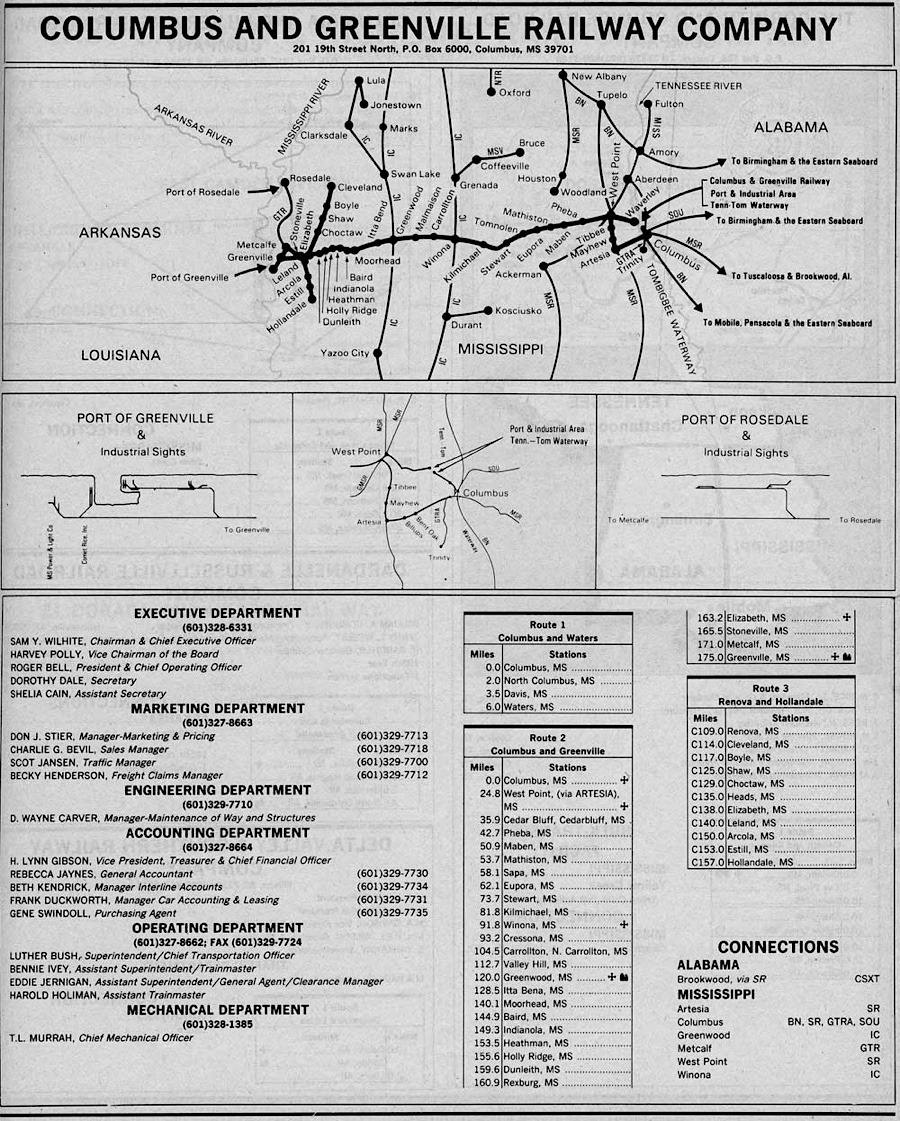
1988 Official Guide ad / collection
 Columbus & Greenville celebrates 25th anniversary
Columbus & Greenville celebrates 25th anniversary
In 2000, under the leadership of president Roger Bell, the Columbus & Greenville subsidiary shortline celebrated its 25th anniversary as an independent railroad with events in Heathman and Columbus. Only a year later, a bridge collapse near Carrollton combined with a longer trend of customer decline on the eastern end of the railroad to cause the C&G to embargo the line from just west of West Point to downtown Greenwood — more than half the total length of the original Georgia Pacific mainline. This created a bifurcated shortline, with extensive local switching and freight service in the Columbus area and service in the Delta from Greenwood to Greenville.
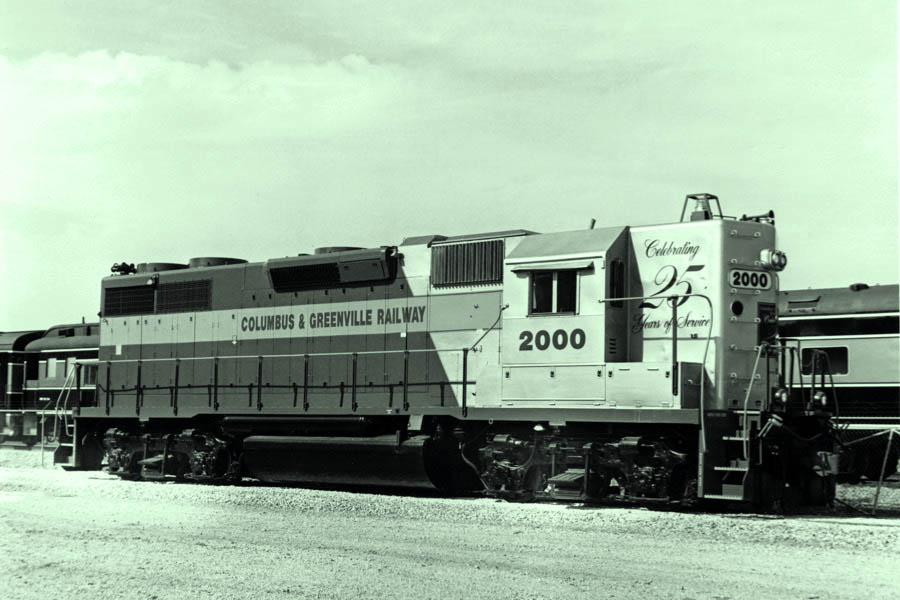
Heathman, Ms / Oct 2000 / Louis Saillard
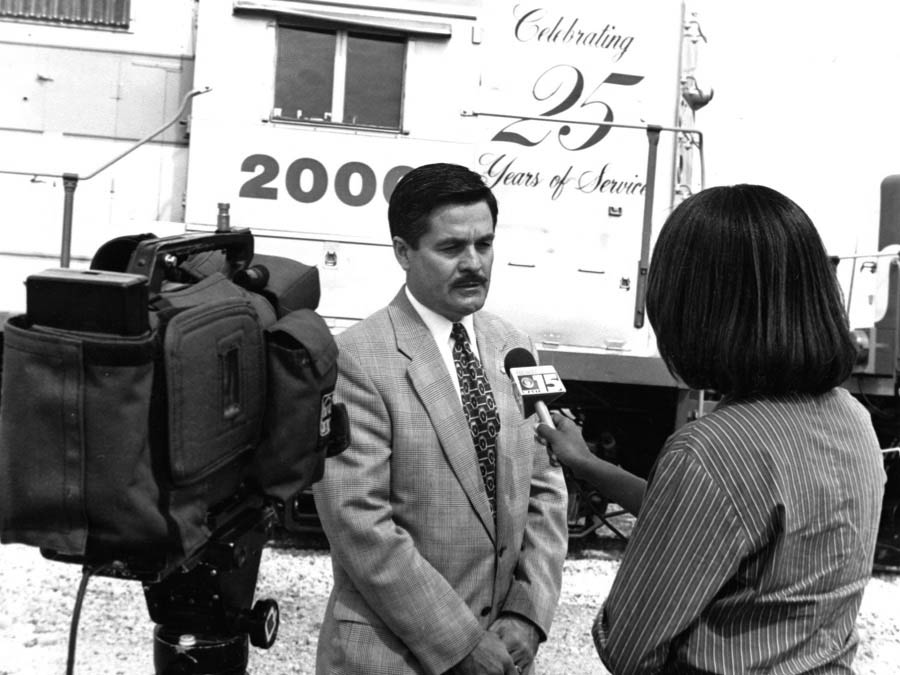
Heathman, Ms / Oct 2000 / Louis Saillard
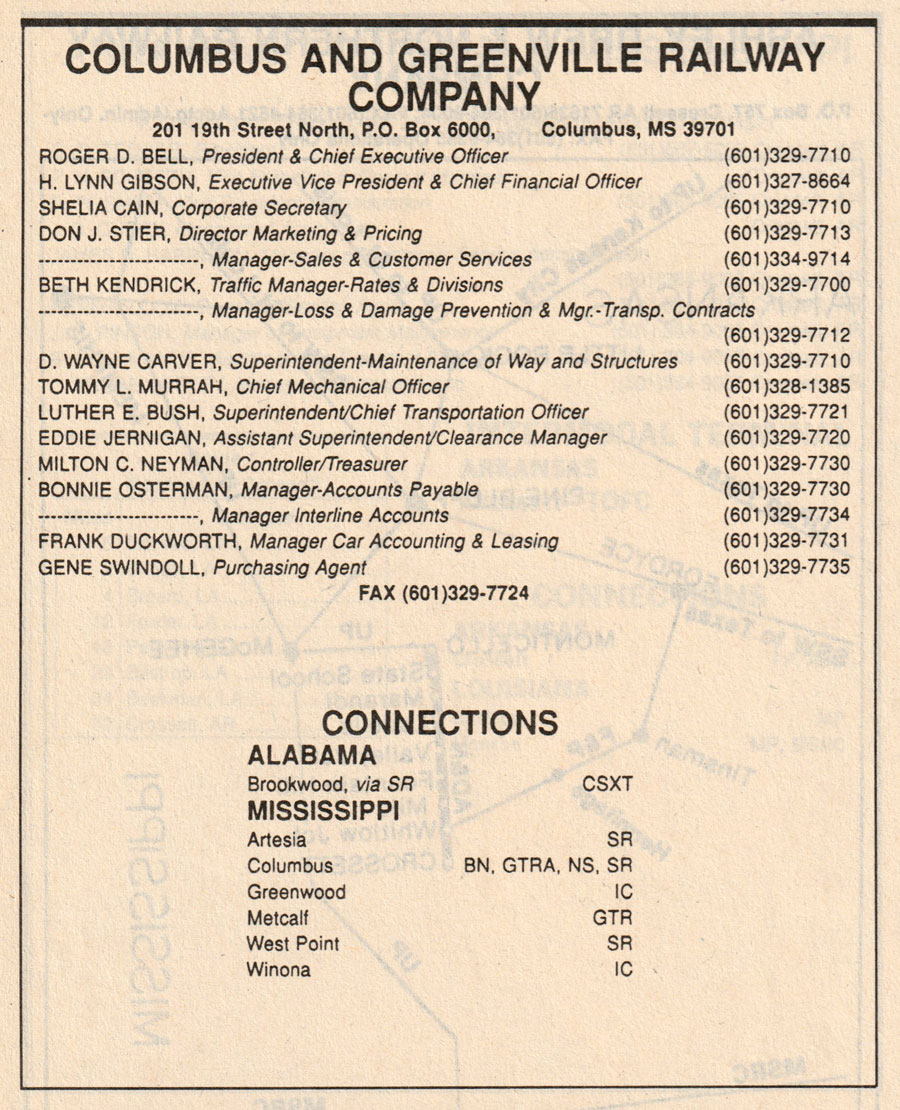
1994 Official Guide ad / collection
 Columbus & Greenville sold to Genesee & Wyoming
Columbus & Greenville sold to Genesee & Wyoming
In 2008, national shortline operator Genesee & Wyoming Inc. purchased CAGY Industries and thereby added to its extensive portfolio the Columbus & Greenville Railway, Chattooga & Chickamauga Railway, and Luxapalila Valley Railroad. For the third time in its 14-decade history as a railroad line, the rails around Columbus and Delta trackage between Greenwood and Greenville are again the property of a national railroad corporation. Under G&W control, the Columbus & Greenville is 151 miles of railroad offering nearly 500 spots for railcar storage. Interchange is maintained with Alabama & Gulf Coast Railway (Columbus); BNSF (Columbus); Canadian National (Greenwood); CSX (Brookwood, Al); Golden Triangle Railroad (Columbus); Kansas City Southern (Aretesia); Luxapalila Valley Railroad (Columbus); and Norfolk Southern (Columbus).
 Article
Article
Genesee & Wyoming to acquire CAGY Industries
April 2008
Genesee & Wyoming Inc. (GWI) is about to add three more short lines to its growing portfolio. Today, the holding company announced it signed an agreement to acquire CAGY Industries Inc. for $78.4 million in cash.
Founded in 1975, CAGY owns the Columbus & Greenville Railway, Chattooga & Chickamauga Railway and Luxapalila Valley Railroad, which operate more than 280 miles of track and move more than 26,000 carloads annually.
GWI expects to close the acquisition and commence operations on June 1 pending customary closing conditions, including the expiration of a 30-day notice period required by the Surface Transportation Board for GWI to obtain authority to control CAGY. The final purchase price will be adjusted for working capital at closing. In addition, GWI agreed to pay contingent consideration up to $18.6 million after satisfying certain conditions over the next two years.
CAGY President and Chief Executive Officer Roger Bell will continue to head rail operations for the three short lines as part of GWI.
"The addition of CAGY will expand our already significant presence in the southeastern United States and further diversify our commodity base," said GWI CEO John Hellmann in a prepared statement.
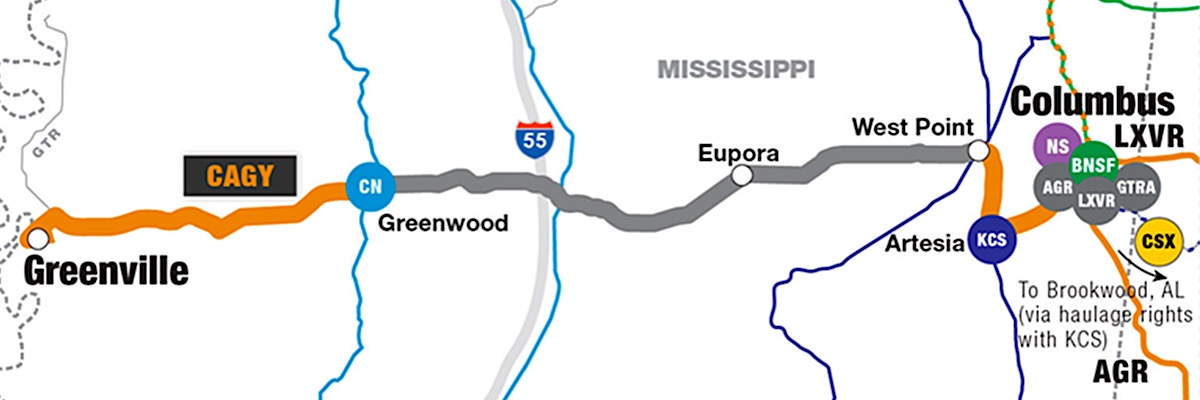
CAGY route map under GW control / web
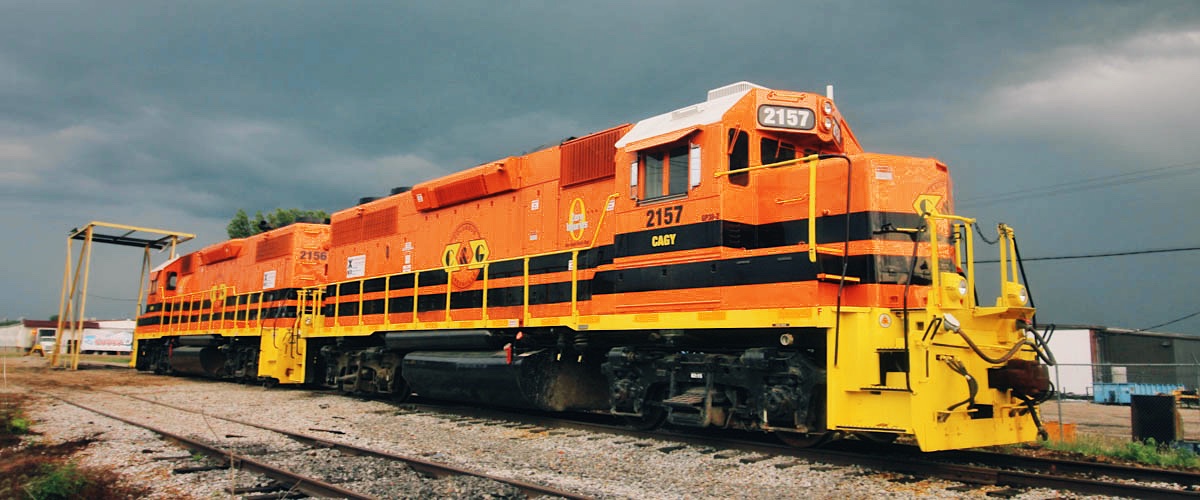
Greenwood, Ms / Jun 2020 / RWH
